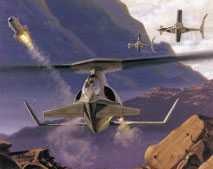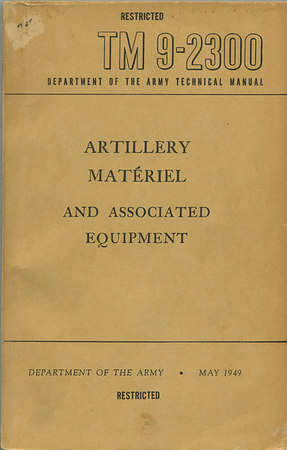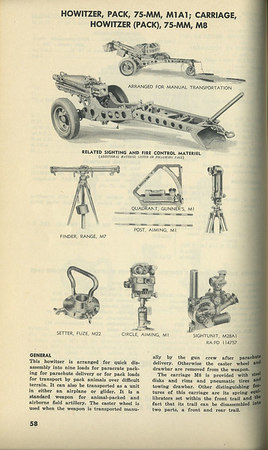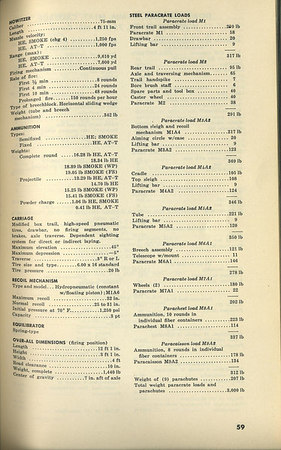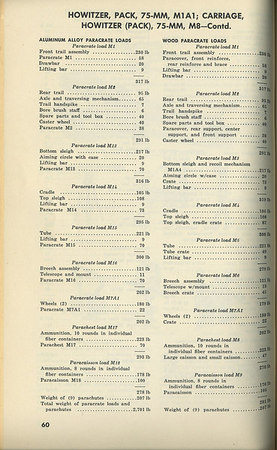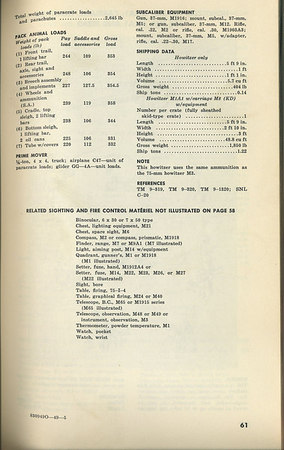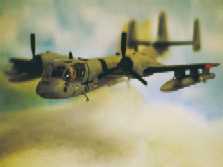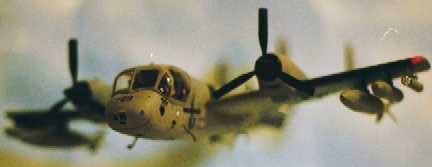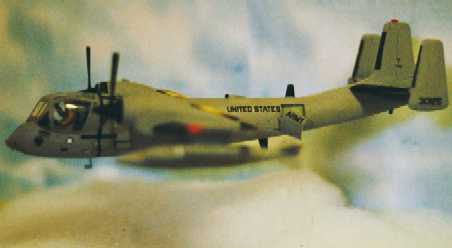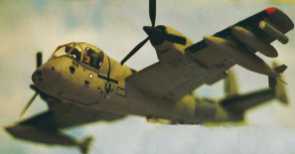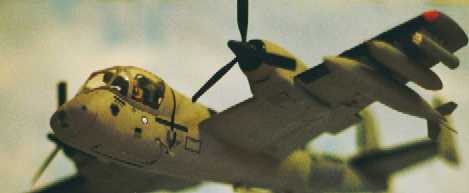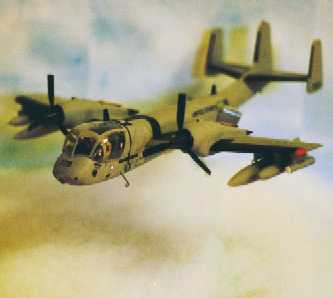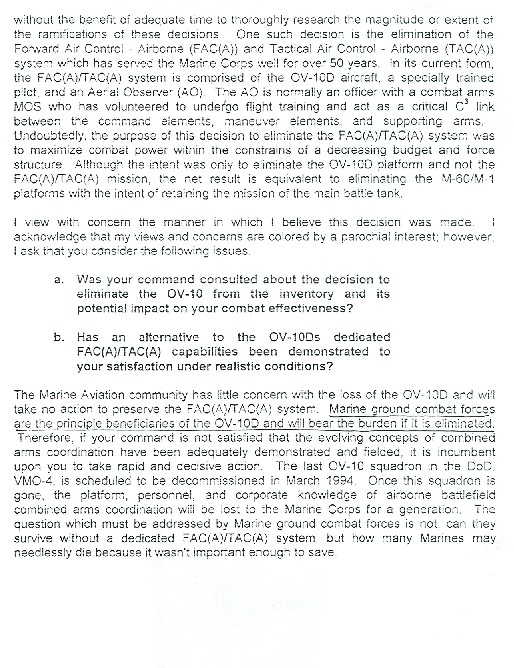
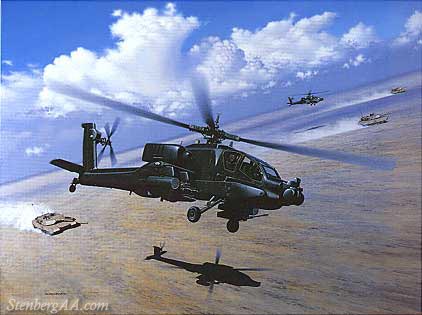
The Battle of Crete: World's First Air-Mech-Strike Operation: Airborne Victory, Amphibious Defeat
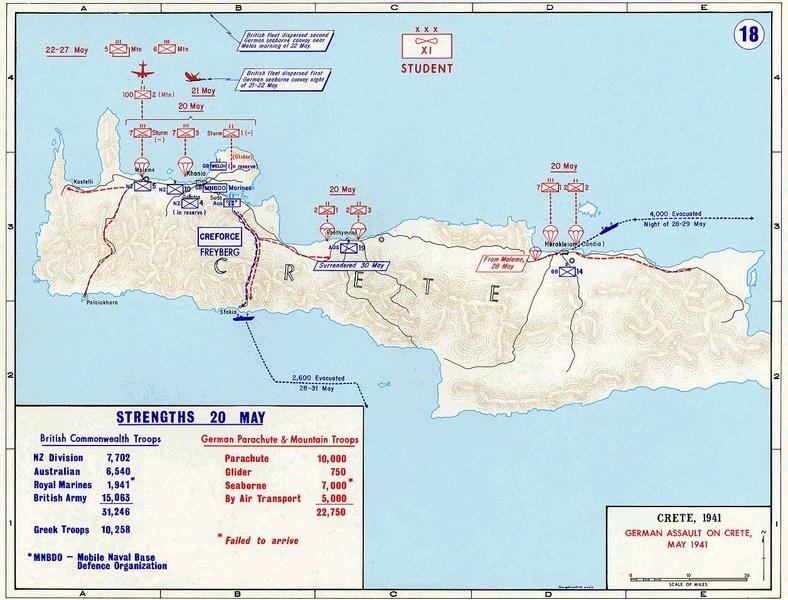
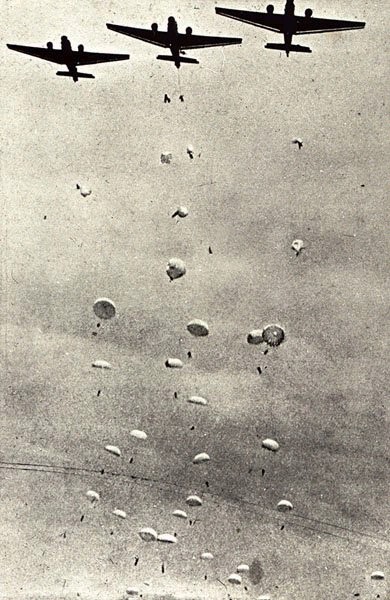
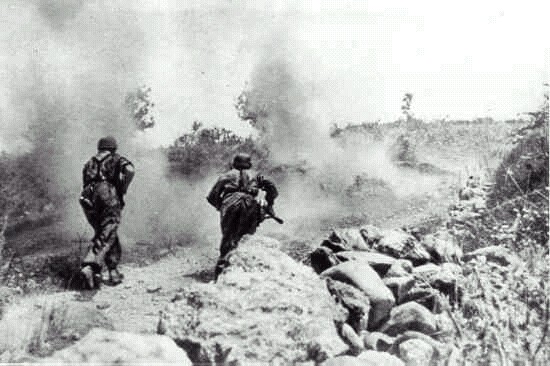
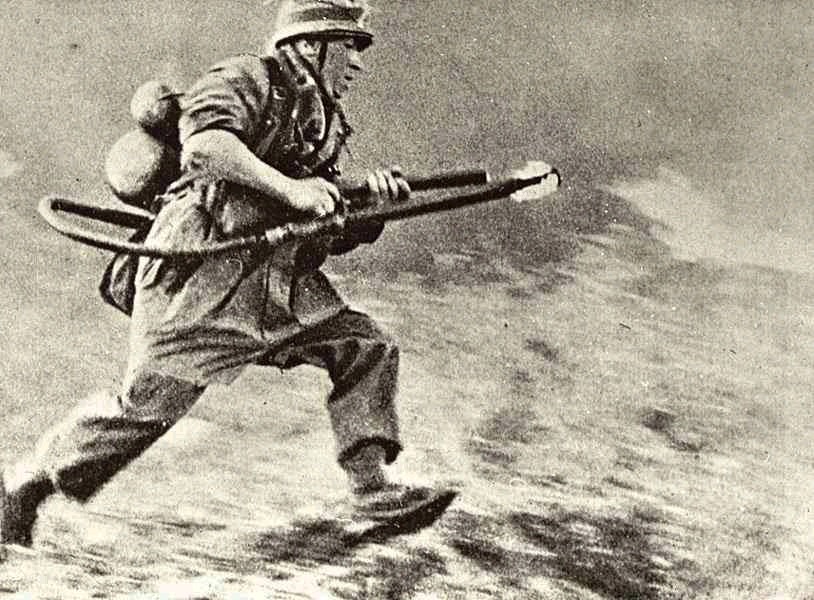
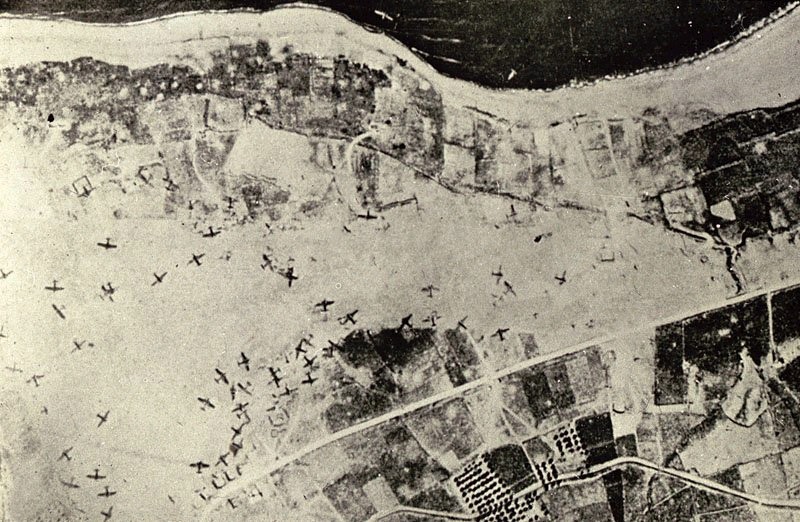
MYSTERY: we know with some certainty that the Kettenkrad motorcycle half-tracks were AIRLANDED by JU-52s at great risk onto Maleme airfield which was littered with destroyed aircraft. What we do not know is whether the LG40 75mm and LG42 105mm recoilless rifles were AIRDROPPED as 3 separate bundle loads from under the JU-52s and hand-towed into action initially or whether they airlanded with the motorcycle half-tracks.
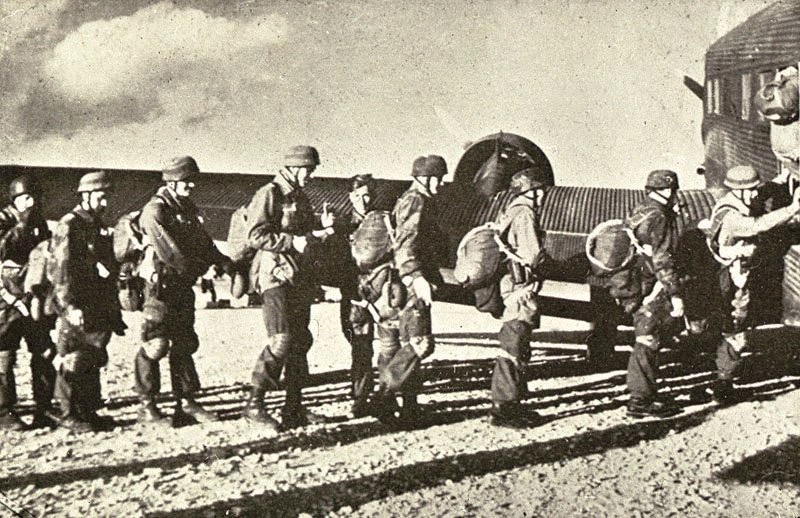
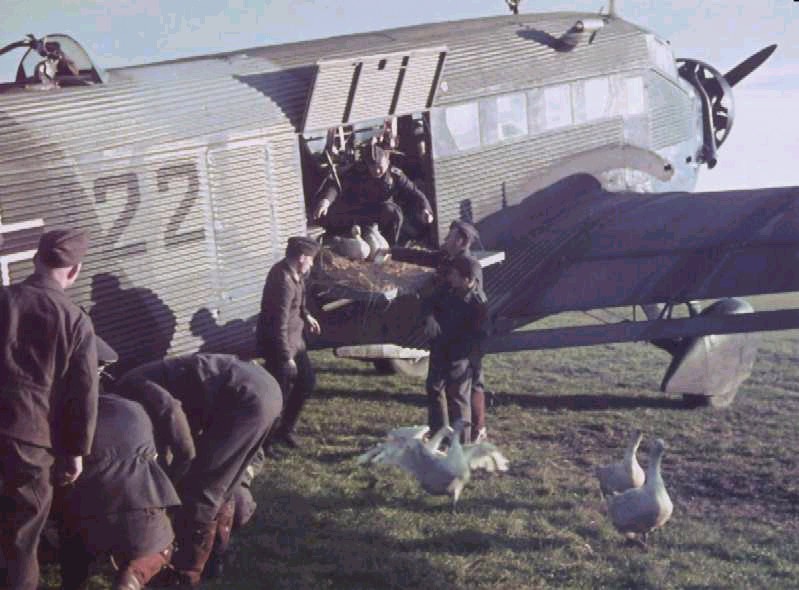
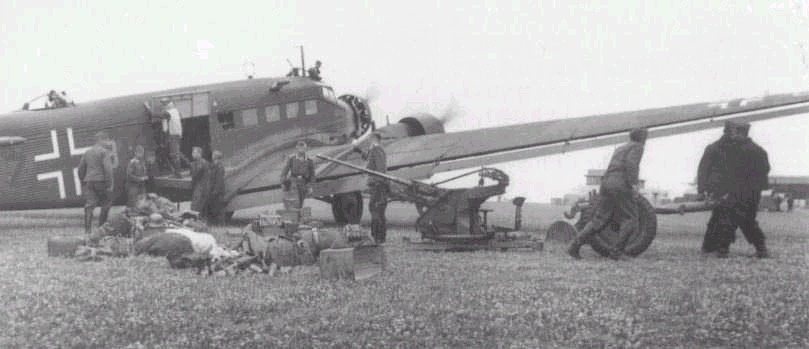
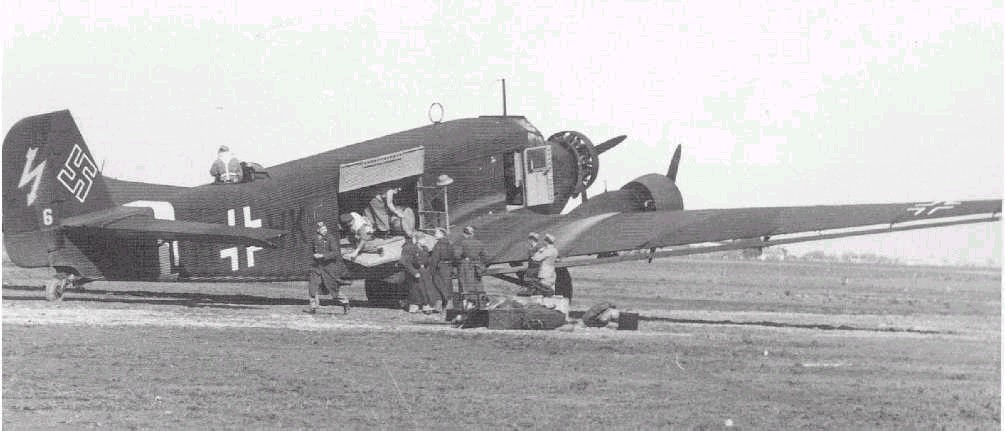
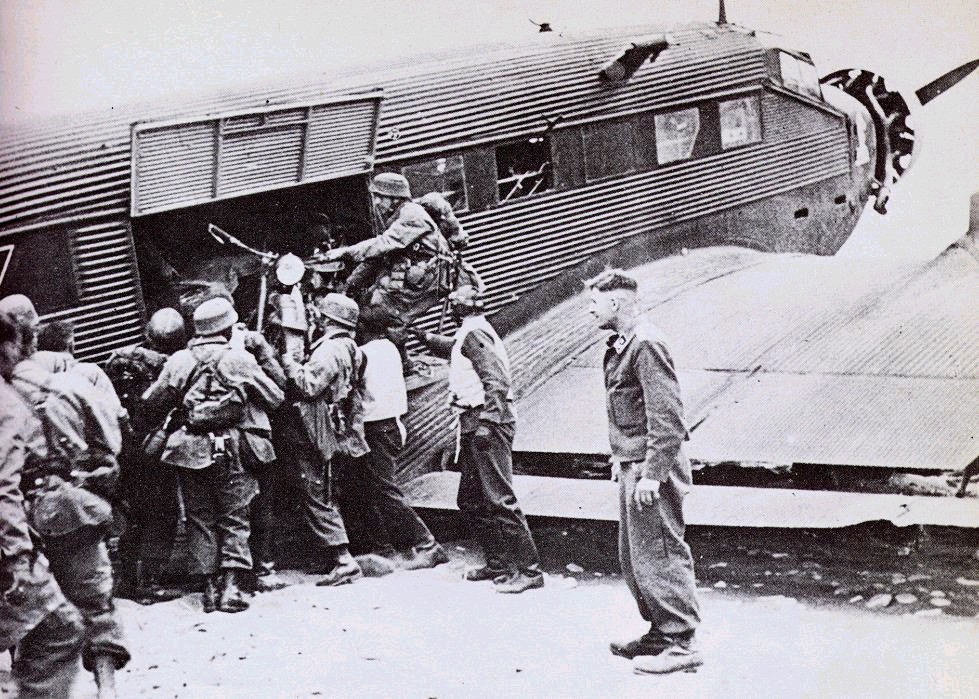
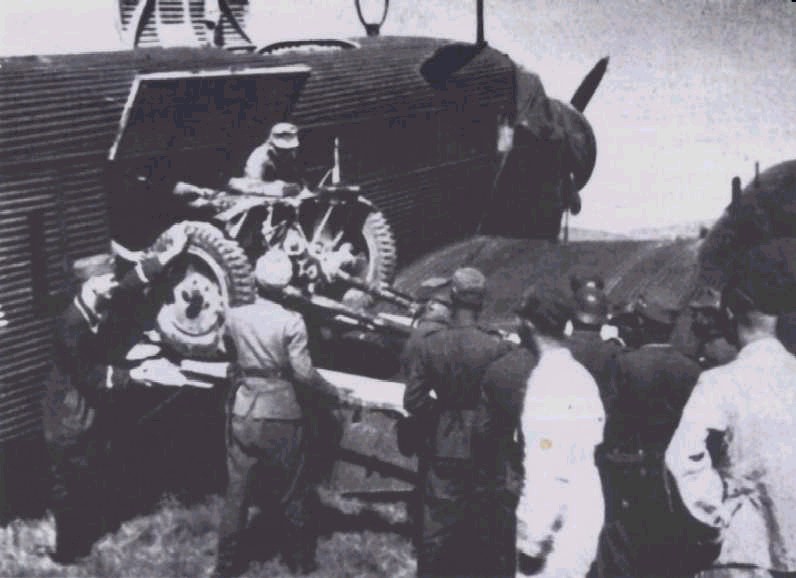
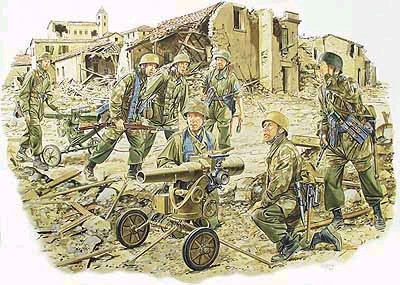
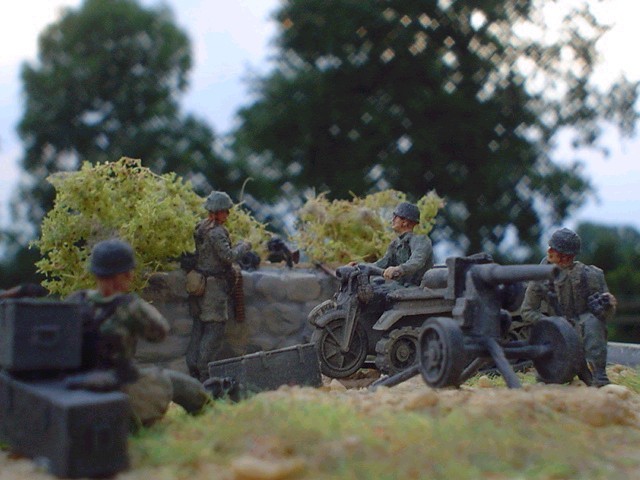
LG40 75mm RR in ACTION on Crete!
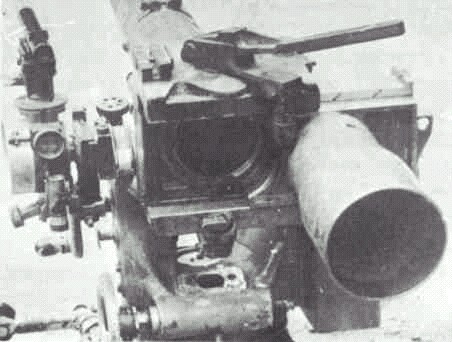
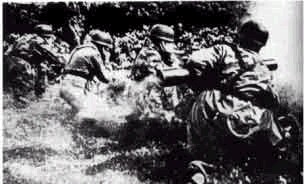
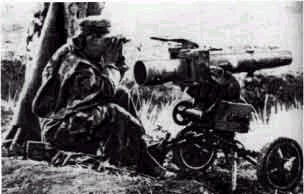
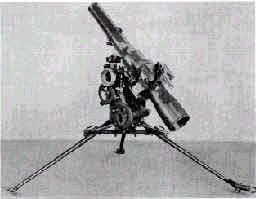
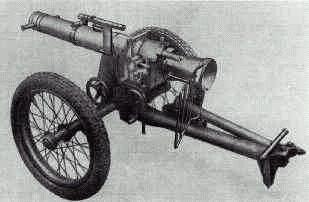
LG42 105mm RR in ACTION on Crete!
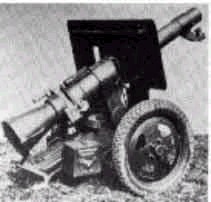

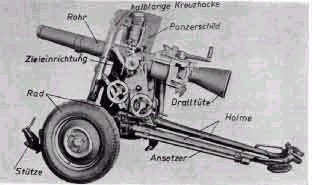
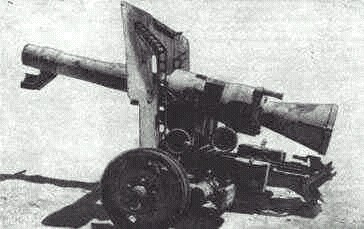
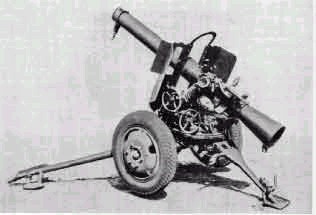
The Germans were deploying a new weapon on Crete: the LG40 Panzerabwehrwerfer 7.5, a 75mm recoilless rifle. At 320 pounds, it weighed only a tenth as much as a standard German 75mm field gun, yet had two-thirds of its range. The new gun could fling a 13-pound shell over three miles. Adding to the airborne units' firepower was the fact that one-quarter of the German paratroopers jumped with an MP40 submachine gun, often carried in addition to a powerful bolt-action Mauser K98k rifle. Moreover, almost every German squad was equipped with an MG34 light machine gun.
The Germans used color-coded parachutes to distinguish the canisters carrying rifles, ammunition, crew-served weapons and other supplies. Heavy equipment like the LG40 was dropped with a special triple-parachute harness designed to bear the extra weight.
The troopers also carried special strips of cloth which could be unfurled in pre-arranged patterns to signal low-flying fighters to coordinate air support and supply drops.
75mm LG 40
This is a light recoilless weapon designed for use with airborne forces. This weapon was in service in time for the airborne invasion of Crete where it proved to be successful. It is air dropped in two loads each contained in a wicker container. This weapon was also adopted for use with other light troops such as mountain infantry as its airborne origin made it satisfactory as a pack weapon. Like all recoilless weapons the LG40 has a substantial back blast creating a hazardous cone behind the weapon. The carriage is not designed for high towing speeds and no gun shield is provided.
|
Crew: 3 |
Ammunition: 7.5cm LG40 |
ROF: SS |
Introduced: 1940 |
|
Weapon Wt: 146 kg |
Ammunition Wt: 16.4 kg |
Reload: 2 |
Gun Shield: No |
|
Round |
DF Range |
IFR |
Armor Penetration |
|
AP |
215 |
N/A |
50mm (2 inches) |
|
HEAT |
160 |
8.9km |
? |
|
HE |
160 |
8.9km |
? |
105mm LG 42
The 10.5cm LG42 is very similar to the 7.5cm LG40 with the exception of the size of the weapon. It was also used during the invasion of Crete and proved its usefulness. The LG42 was also used by other light troops such as mountain infantry as it made a good pack weapon. The weapon and carriage are designed for rapid dismantling and assembly. The carriage is not designed for high speed travel but a small gunshield is provided for crew protection.
|
Crew: 4 |
Ammunition: 10.5cm LG40 |
ROF: SS |
Introduced: 1940 |
|
Weapon Wt: 389 kg |
Ammunition Wt: 35 kg |
Reload: 2 |
Gun Shield: Yes |
|
Round |
DF Range |
IFR |
Armor Penetration |
|
HEAT |
160 |
8.6km |
? |
|
HE |
160 |
8.6km |
? |
By the 24 May, the Germans were now being reinforced on a huge scale and had been resupplied to the point where they could begin to adopt conventional tactics supported by tactical air power and their own artillery. To the Allies' surprise, the Germans had brought artillery onto the island. This was unheard of in 1941, artillery being thought of as too cumbersome and heavy for airborne operations. The Germans had managed it by deploying one of the first recoilless guns seen in Europe. The recoilless gun had been invented by an American naval officer, Commander Davis during the First World War, and was very basic. Davis reasoned that if two guns were placed back to back and fired simultaneously, the recoil from both would cancel each other out. He made a gun with a single central chamber and two barrels facing in opposite directions. One barrel carried an explosive projectile, the other an equivalent weight of grease and lead shot. When the central cartridge was exploded the two projectiles were sent down their barrels at identical speeds making the entire mechanism free from recoil. The explosive shell went to its target while the wad of grease and shot disintegrated in the air. The Davis gun was purchased by the British and experiments undertaken to see if it could be used as an anti-submarine weapon but the war ended before the trials were completed. The German Rheinmetall company continued to experiment with the idea and eventually reduced it to a much simpler form. Reasoning that recoil could still be counterbalanced if the ejected 'countershot' was smaller but faster they found that the shell could be counterbalanced by a stream of gas moving at very high speed through a nozzle in the gun breech. The LG40 was of 75mm caliber, weighed 320lbs and fired a 13lbs high explosive shell to a range of 6.8km. The conventional 75mm gun of the German Army weighed 2,470lbs and fired the same shell to a range of 9.4km. Thus the recoilless rifle allowed virtually the same firepower as a conventional artillery piece with two-thirds the range but one eighth the weight.
The LG 40 was built in four parts, each capable of parachute decent without the need for special packing; the ordnance split into barrel and breech assembly, while a simple top carriage and a wheeled tripod assembly formed the rest of the equipment.
Although Rheinmetal were responsible for the basic research, both they and Krupp were given development contracts and both produced prototypes. The Krupp model used a simple side-swinging breech mechanism and was mounted on two motorcycle wheels, while the Rheinmetall type used a horizontal sliding breechblock and two small aircraft-type wheels.
The latter was the one accepted for service. Extensive use was made of light alloy in the mounting to save weight; and, to prevent the back blast from ricocheting on to the detachment, the elevation and traverse gears were interconnected so that the normal 360 degrees traverse was restricted to 30 degrees each way as soon as the elevation reached 20 degrees.
The firing mechanism was placed in a streamlined housing in the center of the jet venturi, so that a normal type primer in the center of the plastic case base could be used.
The danger area at the rear of the gun extended to 100 m (109 yds) for practice firing ot 50 m (55 yds) for combat firing; this, however, referred only to the actual jet blast, and stones and debris were disturbed some considerable distance beyond this. Firing instructions also emphasized the danger to the detachment members' ears from the blast, and recommended them to plug their ears tightly with clay or mud before firing. A total of 450 of these guns were made, 170 by Rheinmetall-Borsig at Dusseldorf.
Data
Caliber: 75 mm (2.95 in).
Length of gun: 750 mm (29.53 in).
Length of bore: 458 mm (18.03 in).
Rifling: 28 grooves, uniform right-hand twist, 1/52.
Breech mechanism: horizontal sliding block, percussion fired.
Traverse: 360 degrees below 20 degrees elevation, 60 degrees above 20 degrees elevation.
Elevation: -15 degrees to + 42 degrees.
Weight in action: 145 kg (320 lb).
Performance:
Firing standard high explosive shell weighing 5.83 kg (12.86 lb).
Full charge: velocity 350 m/ps (1,148 ft/ps), maximum range 6,800 m (7,434 yds).
Ammunition:
Separate-loading, cased charge.
Projectiles:
7.5 cm Gr 34 A1: fuzed K1 AZ 23, weight 5.75 kg (12.68 lb).
This was an high explosive shell, filled with a 90/10 mixture of TNT and aluminium powder.
7.5 cm Gr 38 H1/B: fuzed AZ 38, weight 4.40 kg (9.70 lb).
This is a hollow charge anti-tank shell.
These were the shells fired by the 7.5 cm Geb G.36.
7.5 cm Pzgr. rot: fuzed Bd Z f 7.5 cm Pzgr, weight 6.08 kg (14.99 lb).
This was an armor piercing high explosive shell of conventional pattern.
This was the shell fired by the 7.5 cm F K 16 nA.
Propelling charge
The charge consisted of a silk-cloth bag containing 1.21 kg (2.68 lb) of Digl Str P with a gunpowder igniter stitched to the bottom; this was carried in a cartridge case with an 85 mm (3.35 in) aperture in the base that was closed by a plastic disc. A percussion primer C/43 was screwed into the centre. The case-mouth was closed by a cardboard cup.
The design of the 75mm light gun relates to the recoilless rifles, in the breech of its stem is a nozzle for the release of solid-reactant gases outside, i.e., to the side, opposite to the direction of the motion of projectile. In this case the dynamic balancing occurs - stem with the shot remains fixed, thanks to which it is possible to forego the bulky and heavy antigravity devices. The development of recoilless rifles began in Germany in the middle thirties. They were necessary in order to ensure artillery for the fallschirmjägers, they were called "light weapons" due to secrecy. One such weapon is the 75- mm light gun, which was being used in the parachute divisions of the Wehrmacht against infantry targets and weapon emplacements. the first succesful use of the weapon was in the combat during the large-scale airborne operation on the seizure of Crete island in the spring of 1941.
The guns consists of following major portions: stem with the lock and the nozzle, upper machine tool with lift and swivel gears of guidance, lower machine tool with the tripod and tread with the cushioning of the sight mechanisms. The gun barrel consists of pipe- monoblock and breech, connected to the pipe with the aid of the sukharnogo lock. The lock is horizontal, wedge, which is opened/disclosed to the right. In the wedge of lock are openings for the release of the solid-reactant gases resultant with the shot back; the nozzle is fixed on the wedge. The upper machine tool poured from the light alloy revolves on the pintle of lower machine tool. Sectorial type lift and swivel gears are assembled on the upper machine tool. Lower machine tool consists of base, three feet and tread. Feet are hinged connected with the base of lower machine tool. In the firing position they are fixed with the aid of the stops. Rear feet are connected together upon transfer to the march position, and the nose wheel strut rises and is attached to the clip of stem. The tread consists of the tubular axle, in which is assembled torsion cushioning, and two disk wheels with the continuous rubber tires. The weight of gun in the firing position is 145 kg. For the landing by parachute method and for transportation on the drag harrows under the winter conditions the gun is divided into two parts (stem and gun carriage). The light weight of system gives a good maneuverability on the field of battle. The gun can conduct fire at the elevation from - 15° to 42° with the sector of horizontal field of fire 60°, and at the elevation from - 15° to 20° - with the sector of horizontal field of fire 360°. In this case is ensured the maximum range of shooting 8 100 meter. Ammunition to the 75 mm gun consists of special fixed rounds with the HE fragmentation, cumulative and armor-piercing shells. Case used in these cartridges has a bottom of plastic with the nest for primer cup. The bottom of the case flies out when firing and thus it makes it possible for the part of solid-reactant gases to leave back through the nozzle. The HE fragmentation projectile with a weight of 5,7 kg has the initial velocity of 376 m/s, shooting is conducted on the distance of 8 100 m. The shaped-charge shell with a weight of 4,6 kg has an initial velocity of 364 m/s and a firing distance 6 800 m. It is capable to penetrate armor with a thickness of 50 mm. As all recoilless rifles the 75- mm gun possesses such deficiencies as the disclosing action of the solid-reactant gases, which emerge from the nozzle, the presence from behind of the nozzle is hazardous zone as deep as 50 m, and also the outgoing of the nozzle gases produces a strong sound, which can damage the eardrums.
The caliber of 75 mm
Initial velocity of projectile: 376 m/s (HE fragmentation) 364 (cumulative)
The greatest angle of elevation: 42 degrees angle of depression -15 angle of the horizontal
Field of fire: 60 degrees
The weight when emplaced: 145 kg
Rate of fire: 8 shots/min
Maximum range of shooting: 6 800 - 8 100 m
Armor-piercing ability with shaped-charge shells: 50mm
TOWED RECOIL ARTILLERY
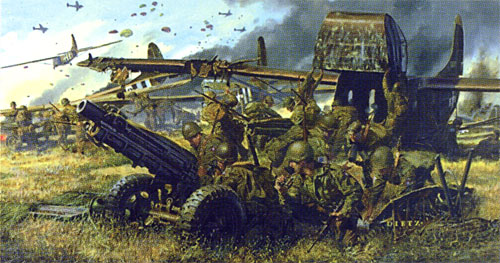
www.handcartz.smugmug.com/gallery/895456_53DPC#130702567_3GEh2
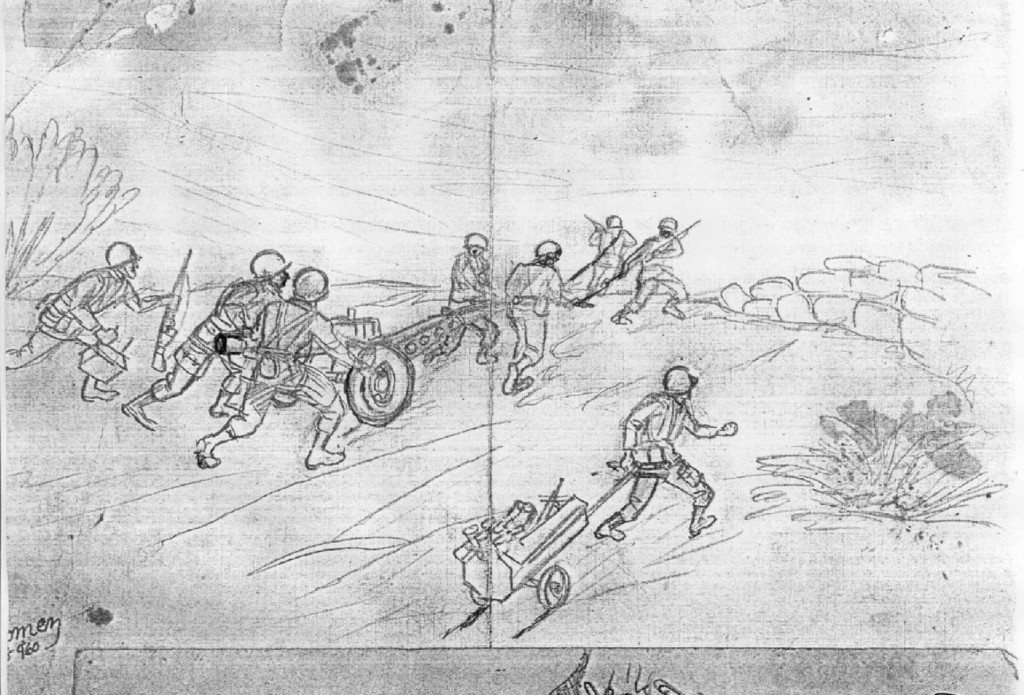
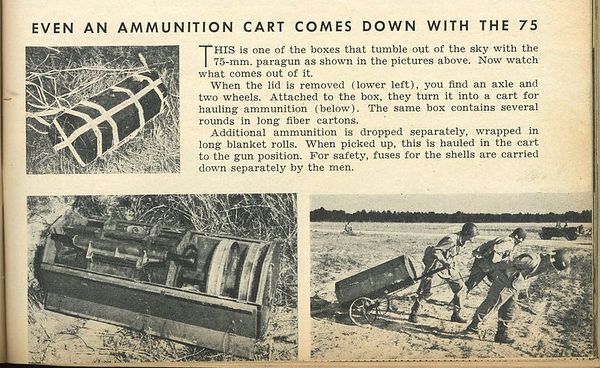
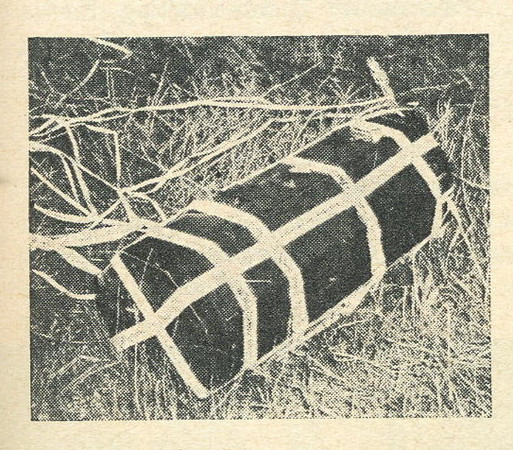
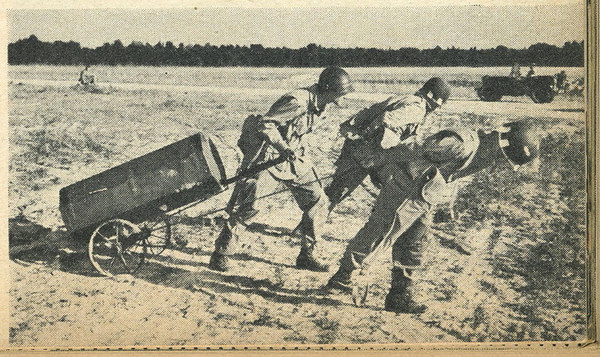
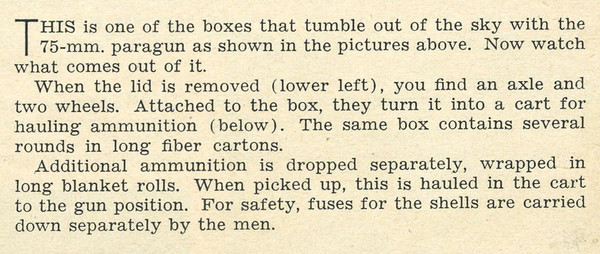
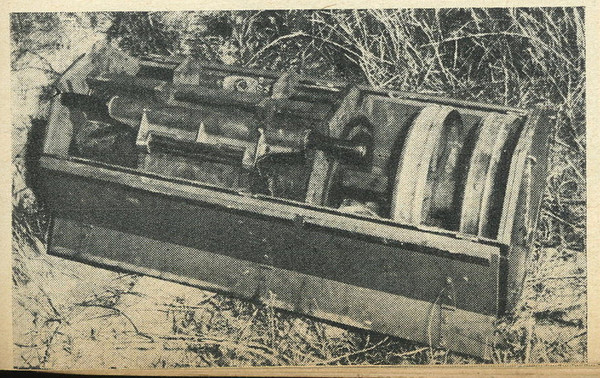
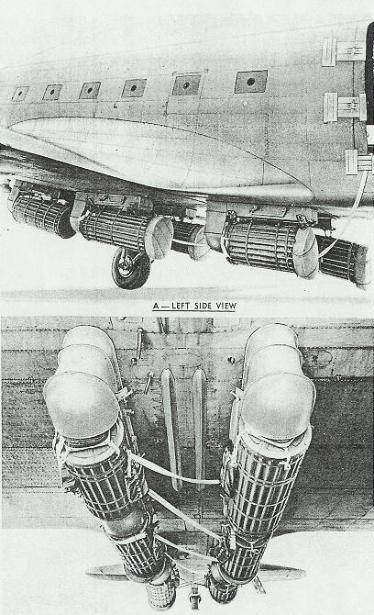
General Gavin and his comrades got the idea of equipment containers made into carts from studying the German Airborne victory on Crete in 1941 though not being too dependant on them, by having each Paratrooper jumping in his own equipment using lowering line loads.
The British glider-landed powerful 17-pounder (76mm) towed anti-tank guns to Arnhem, but this was not adequate to give the MOBILE firepower needed to punch through the 6-8 miles to reach the bridge to reinforce LTC Frost's battalion.
Later on, 57mm towed anti-tank guns were towed by jeeps from gliders for Operation Market-Garden (U.S. Airborne forces achieved their objectives) and even short-barrel 105mm howitzers just at war's end. This operation was a failure however, when British towed guns couldn't get into firing position to break through German road blocks on the way to Arnhem bridge. For meeting engagements, vehicles must have their firepower ready to fire, and our Airborne has long needed turreted light tanks or fixed assault guns to achieve this.
How Jeep-Towed AA/AT Guns Failed the British on the way to Arnhem
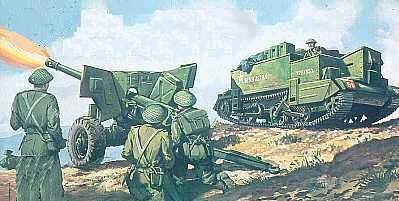
Even if your gun is towed by an ARMORED track, there's no guarantee that enemy fire will let you get out to put it into action
A mere pair of armored cars and some training students with rifles stopped two elite parachute battalions from reaching Arnhem bridge to reinforce LTC Frost who took an unopposed route. LTG Gavin reports that their jeeps towing AT guns couldn't get into return fire condition against the ready-to-fire armored cars. We know that Freddie Gough's Recce Squadron towed Polsten AA cannon. Whatever gun types they were towing, this inability to immediately return high explosive cannon fire to ward off a mere pair of armored cars RESULTED IN THE DEFEAT OF AN ENTIRE BATTLE EFFORT WITH STRATEGIC NEGATIVE CONSEQUENCES.
Most everyone thinks the Germans are the epitome of military efficiency so let's see how long it takes them to stop, unlimber and put into action a small 37mm towed anti-tank gun.
Watch video at full speed fast forward to 9:30:
 www.youtube.com.com/watch?v=tpJhxW9tnWU
www.youtube.com.com/watch?v=tpJhxW9tnWU
The small unarmored, wheeled truck stops at 9:32.
Still Sequence
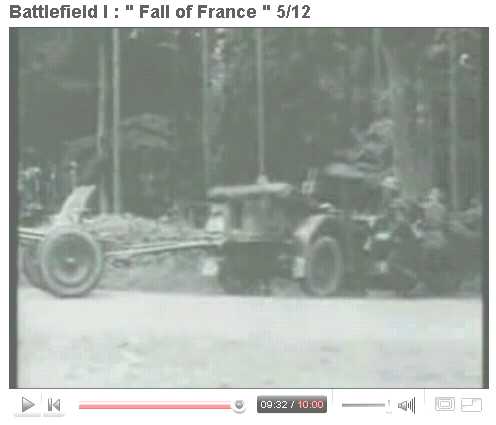
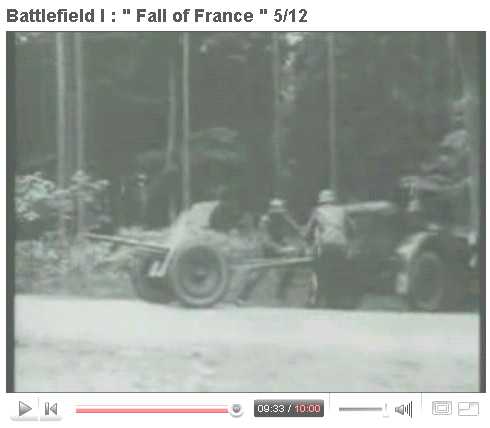
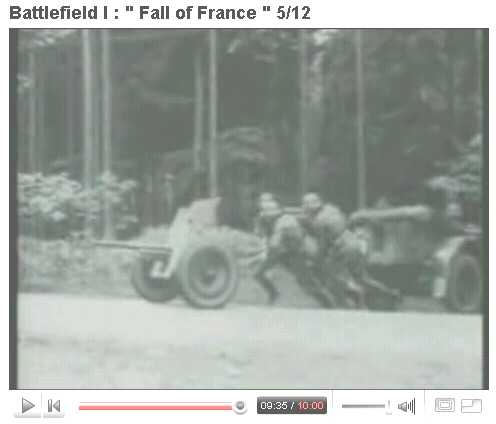
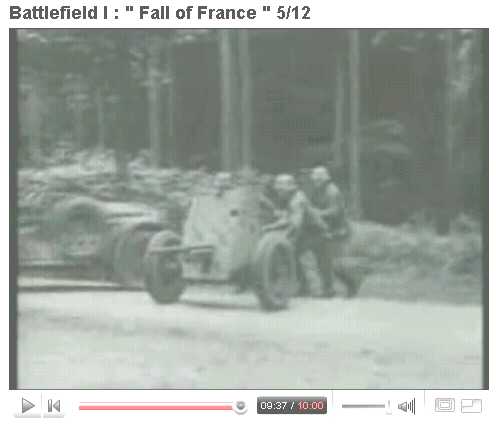
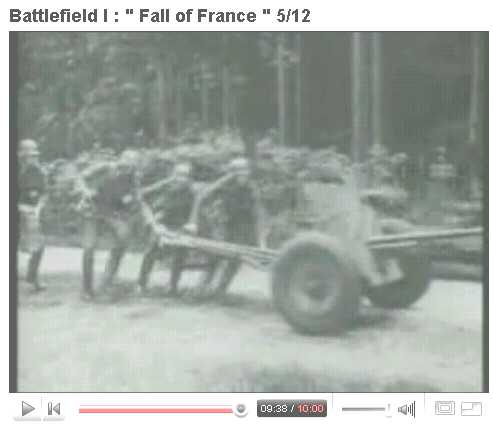
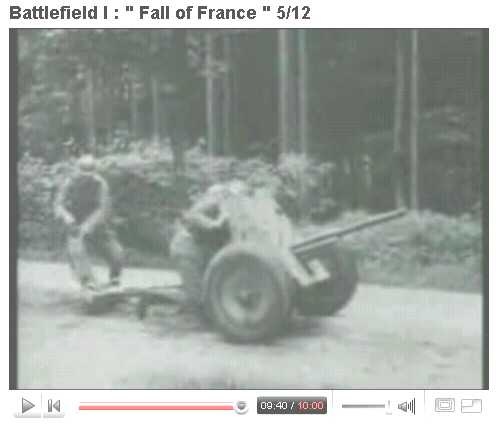
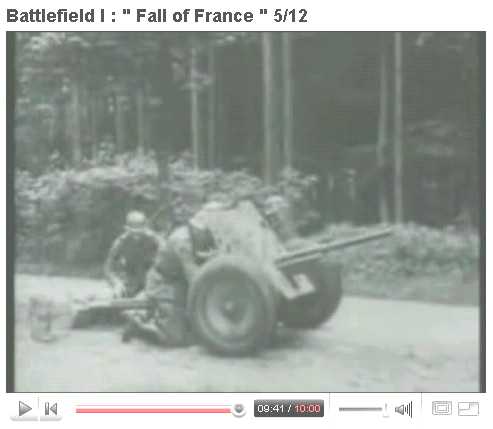
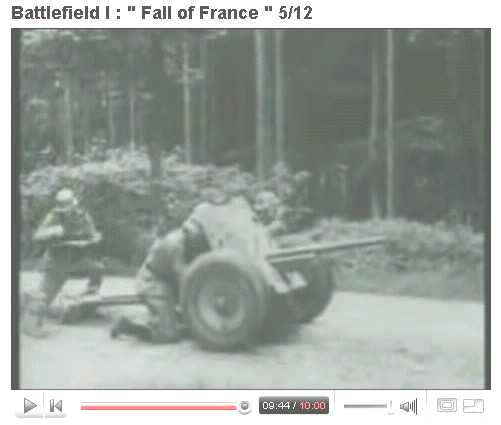
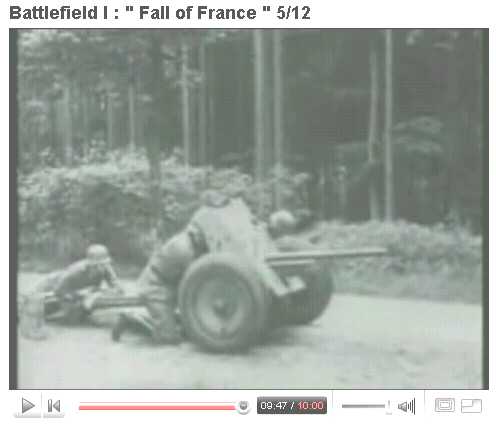
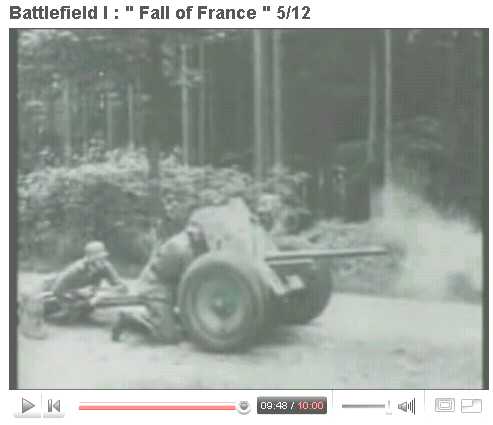
The AT only fires what looks to be one round already in its breech at 9:48, so it takes 16 seconds under ideal conditions to get a towed AA/AT gun on a paved road into action. A less efficient crew would take longer. In a meeting engagement when the enemy spots you or you spot them and both sides open fire, the towed AA/AT gun crew cannot return fire for a fatal 16 seconds. A lot can go wrong.
1.) Crew is killed and truck/towed gun destroyed before they can dismount
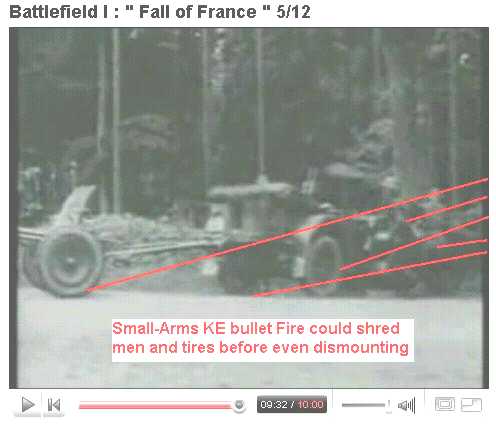
2.) Crew is killed after they dismount, truck and gun still vulnerable to destruction
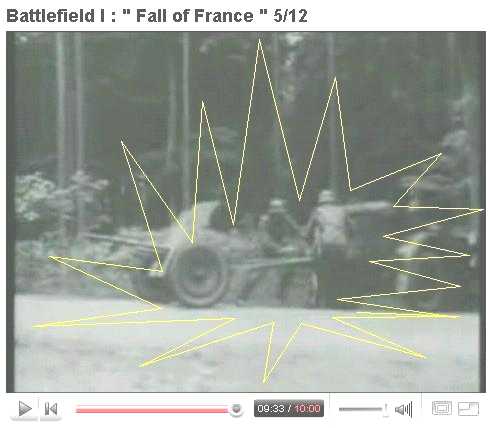
3.) Crew is only safe from frontal small arms fire 15 seconds later by virtue of a gunshield (U.S. towed guns no longer have these today) , but bullets can shred the gun's tires and immobilize it
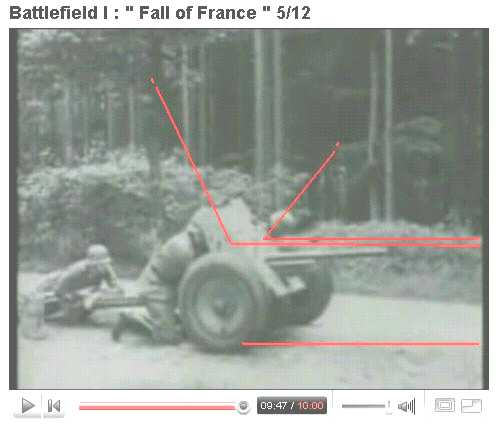
4.) Any high explosive near miss BEHIND the gunshield wounds and kills the crew
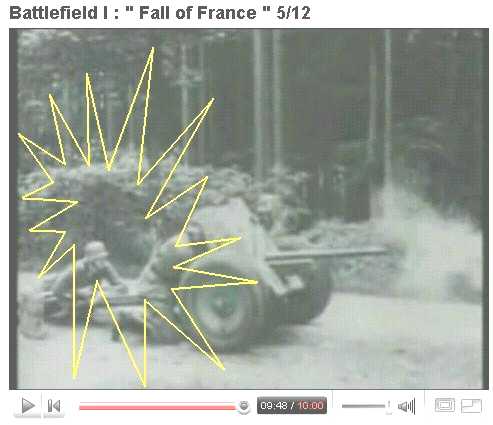
Today, 105mm M119 light guns so decisive in the Falklands war in 1982, and even M198 155mm howitzers are parachute airdropped to give long-reaching fire support for Airborne infantry. However, avant garde' civilian wonks at DoD are anti-artllery in favor of aircraft-dropped expensive precision munitions and therefore tube artillery was not taken to Afghanistan, resulting in several U.S. deaths that could have been avoided had artillery was there to suppress enemy mortar fires.
The early Air Assault fire support vision history page
Early Army Air Assault doctrine wrongly omitted ground armored vehicles as a necessary part for its 3D combined-arms team in Vietnam since they can be in an always in a ready-to-fight configuration. The AR/AAV was supposed to be under 10-tons to facilitate CH-47 Chinook helicopter liftability but it ended up at 17-tons with the Sheridan light tank and thus too heavy. The early idea was for the helicopter to replace ALL ground vehicle functions; which was found to be impossible--Air-Mech-Strike solves this by providing a ground AFV to give infantry mobility, dominant firepower, armored protection and a means to carry ammunition/vital supplies in greater than manpack quantities. Early Airborne/Air Assault doctrine depended on artillery in distant "firebases" to give foot mobile aircraft-delivered infantry firepower, however this distant firepower was not responsive or accurate enough for a close-in firefight to not land on friendly troops. Later in the Vietnam war, the firebases themselves became the targets of the enemy (Dien Bien Phu, Khe Sanh) to destroy with LONG-RANGE ARTILLERY FIRE and eventually rendered the Air Assault concept given to the South Vietnamese Army (ARVN) untenable. Air-Mech-Strike would solve this by having "tanks" and infantry carrier versions accompany AMS forces after aircraft insertion and having mobile artillery that would not necessarily need a defended firebase to operate. The goal of today's artillery firing area rockets and precision munitions would be to Suppress (SEAD) and Destroy (DEAD) enemy air defense weaponry to facilitate cross-FLOT operations as well as clear Drop/Landing Zones determined first by C4I "virtual pathfinding" means.
The U.S. infantryman over the years has come to expect and get continuous artillery support on call. The artilleryman in turn has depended on the infantry to secure his positions and keep his supply routes open. In Vietnam no simple solutions were available to continue this long-established teamwork. The early designers of the airmobile division had recognized that they would have to sacrifice the heavy 155mm howitzers and be content with moving the 105mm howitzer with the Chinook helicopter. As it turned out, a 155mm howitzer battalion was continuously attached to the 1st Cavalry. It was teamed with the CH-54 SkyCrane to become an integral part of the Division's fire support, even though it was not officially "organic." The Little John (surface-to-surface guided missile) rocket had been included in the original organization, but when the 1st Cavalry deployed to Vietnam, the Little John was deleted due to tactical and manpower considerations. To make up for this deficiency in firepower, an aerial rocket artillery battalion (ARA) was organized as the general support artillery. It consisted of three firing batteries, each equipped with twelve Huey helicopters armed with 2.75-inch aerial rockets.
The eratic impact trajectory of the 2.75" rockets lead to turning CH-47s into flying "Guns-a-Go-Go" gunships described below at the bottom of this web page but egos in the ARA community were bruised and they sabotaged this important concept from continuing.
Unguided 2.75 inch Hydra 70mm rockets have limitations in how close they can be used to friendly troops which enemies can exploit with "belt buckle" hugging tactics. This asymmetric tactic can be negated by attack aircraft with observers to direct guns and by increasing Hydra 70mm accuracy through low-cost guidance means.
The airmobile tactics of the 1st Cavalry Division, its speed of maneuver, and the distances involved required drastic changes in the techniques and development of fire support co-ordination. For one thing, the air was filled with a number of new objects-hundreds of troop transport helicopters, armed helicopters, reconnais[s]ance aircraft, and tactical air support. Through this same atmosphere thousands of shells from tube artillery had to travel. Fire support co-ordination during the critical air assault phase of an operation was the most difficult to resolve. The tactical air support, tube and aerial artillery, and sometimes naval gunfire and B-52 bombers had to be integrated without danger to the friendly forces and without firepower gaps that would relieve the pressure on the enemy. Only careful planning and carefully worked out standing operating procedures could make this manageable.
As an example, the 1st Cavalry Division had a zone system based on the twelve hour clock superimposed on the map location of each firing position. North was at 12:00 o'clock. Prior to firing, the artillery units announced over the aircraft guard frequencies the danger areas such as "firing in zones three and four, altitude 3,000 feet." It was incumbent on the pilot to check for artillery fire prior to approaching a landing zone. As an additional precaution, canonneers scanned the skies in the direction of fire prior to pulling the lanyard while observers checked the forward end of the trajectory.
During the first battle of the Ia Drang Valley, the 1st Cavalry had covered such a wide zone that the placement of artillery was of utmost importance. Not only was it necessary to cover the landing zones of the attacking forces, but it was also necessary to place artillery in such a position that it could cover another artillery unit for mutual support. In this "war without front lines," the artilleryman found himself often confronting the enemy face to face. It was not long before the artillery decided it would be good practice to collocate itself with the infantry battalion reserve.
During MASHER-WHITE WING, the 155-mm howitzer was airlifted for the first time using the CH-54 "SkyCrane" helicopter. During this same campaign, it became an accepted technique to select hilltops for artillery positions since these were easier to defend and provided open fields of fire.
Artillery has always been notorious for consuming large tonnages of ammunition. Again this is symptomatic with the kind of support that the U. S. infantryman has taken for granted. However, in Vietnam where practically every round had to be delivered by air, artillery ammunition proved to be one of the biggest logistics problems. Commanders had to exert supervision at all levels to make sure that the right fire support means was chosen for the target of the moment. A wise commander did not spend too much ammunition on harassment and interdiction fires that could not be observed.
The airmobile artilleryman had learned to fire in all directions with a minimum of confusion. He became accustomed to rapid and frequent moves and developed confidence in his airmobile prime mover, the Chinook. He even developed his own special tactics, known as "the artillery raid." In this case, an artillery battery would be moved deep into suspected enemy territory, rapidly fire prepared concentrations on targets that had been developed by intelligence, and then pull out before the enemy could react. Some of these raids were conceived, planned, and executed in less than three hours.
Workable methods were found to employ aerial rocket artillery at night, but the mainstay of fire support during the hours of darkness remained the tube artillery. Seldom was an infantry unit required to hold a position at night out of range of its friendly guns.
Close-in fire support has always been inherently dangerous. In the fluid situation of the airmobile battlefield, the ever present danger of the proverbial "short round" is multiplied by all the points on the compass. An error in any direction may well result in friendly casualties. As a result, coordination and control of all fire, the knowledge of the exact location of every friendly element is more important in the Air-Mech-Strike capable Division than in any other combat force. AMS solves this gap in fire support coverage in close by providing light armored fighting vehicle firepower so artillery will be used less and armored protection organic to infantry on the ground so even if a round falls short our men will not be harmed.
M119 105mm "light gun" victor in the Falklands war
M777 155mm UltraLightweight Howitzer (ULH)
Self-Propelled 105-155mm Howitzers: endangered species in the U.S. Army
Soltam RASCAL C-130 air-transportable 155mm SPH
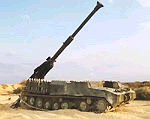
M109A6 PALADIN 155mm SPH
UDLP CRUSADER C-17 air-transportable 155mm SPH

Battle: Secretary Rumsfeld, airpower advocates about to overrun "Firebase Crusader"
The ambush that November day nearly 37 years ago was a total surprise to the American column on its way to Landing Zone Albany in the Ia Drang Valley. The well-prepared North Vietnamese attack separated, killed and wounded many American troops. In some areas, the North Vietnamese were inside the defensive perimeter, moving toward the positions occupied by the Americans.Often on the battlefield, a shot would ring out, followed by a scream. The enemy was taking no prisoners.
Lt. Bob Jeanette, a weapons officer of the 2nd Battalion, 7th Cavalry, was severely wounded, but had a radio. "As it got dark, I was still in the same position. I was trying to maintain contact with whoever I had talking to me back at brigade. There was a lull in the battle, and suddenly I was talking to an artillery outfit.
"The North Vietnamese were now running around the area, and we could see them moving. Bunches of 10, 20, more of them circling the perimeter of the landing zone. It was maybe 150 yards to the landing zone perimeter, and the enemy were between us and them."
Ultimately, Jeanette was able to convince the artillery unit to bring high explosive rounds down on top of the enemy.
"I never really knew how effective that artillery fire was until two things happened," he remembered.
The first incident happened while he was recovering from wounds at St. Albans Navy Hospital in New York, "I met someone who had been in that fight, a 2nd Battalion, 7th Cavalry guy, who came over to me and thanked me for that artillery fire. I was out in the halls on my crutches for exercise and he came up to me on crutches, too. He had an empty trouser leg. He told me the artillery took his leg, but it saved his life and he was grateful. I was stunned."
Later at Fort Levenworth, Jeanette met a sergeant who was in the same battle whose position was about 50 yards from his position. "Sgt. Howard said that every time the enemy got close to them, the artillery would come in close, too, and really whack them. He said the artillery fire was the only thing that kept the enemy away and kept them alive."
The above is just one of many war stories from the Vietnam conflict, but maybe the civilian movers and shakers in Washington need to re-read "We Were Soldiers Once And Young" by Lt. Gen. Hal Moore and Joseph Galloway.
The scene described occurred after air strikes by the highly efficient A-1E Skyraiders. Despite napalm and other ordnance, many enemy soldiers remained alive. It took artillery fire to save American lives.
That was long ago. But proof that it wasn't just an artifact of history emerged only weeks ago during Operation Anaconda in Afghanistan, when a U.S. infantry company found itself under mortar and rocket fire for nearly 12 hours without close air support. Unfortunately, it also had no artillery support: the unit's artillery had been left behind in the U.S.
Pentagon civilians who threaten to cut the Crusader artillery system seem to have forgotten their history. Airpower is a wonderful tool, but it isn't enough. Infantrymen on the ground need the combined firepower of both close air support and artillery.
Strangely, combat veterans who understand the value of combined firepower have been deafeningly quiet about the need for more advanced artillery. That's hard to understand, because they know air power has its limitations and that their grandsons will pay the price.
In the late 1940s when air power advocates tried to eliminate aircraft carriers and shift responsibility for power projection to the Air Force, active duty admirals revolted, cranked up the public relations machine on the need for Naval airpower and won.
The battle for Crusader may be over. The "after action report" will be prepared soon. Maybe the report should look at why the Army failed to convince the Pentagon, public and President that the Crusader was a vital asset. If so, it should also examine why the combat veterans who experienced the live-saving value of artillery hid in their foxholes.
Legendary retired Army Colonel Richard Sinnreich writes; "Crusader's cancellation would be a self-inflicted wound";
"If, as now seems likely, the Defense Department decides to defy congressional opposition and axe the Army's controversial Crusader howitzer program, the Army must share with its reformist critics responsibility for the program's cancellation.He isn't the only one confused. It's just that sort of confusion that may finally have doomed Crusader.By acceding with astonishingly little resistance to critics' disparagement of today's operational force as a legacy of the Cold War, the Army has undercut the most compelling argument for Crusader and for many of its other modernization programs as well. To a considerable extent, the Army itself, not Defense Secretary Rumsfeld, may have sacrificed Crusader on the alter of "transformation".
Note that the question is not whether the Army should transform. Few in or out of uniform doubt that it must. Instead, the operative question is whether transformation should apply to the entire Army or just a notional "Objective" force achievable sometime in the not very clear and probably not very near future.
On this score, the Army's public stance has been incomprehensible. It is one thing to acknowledge and repair a longstanding and troublesome gap in ground combat capabilities between the Army's light and heavy forces, and to look for better ways to exploit new information technologies. The Army is doing both as a matter of urgency, and so it should.
But it is another matter altogether to accept without quarrel reformists' facile contention that today's fielded forces, including our heavy forces, are strategically and tactically obsolete. Here evidence surrenders to speculation. Indeed, what little evidence there is, including that of our own operations in Somalia and Afghanistan and Israeli operations in the West Bank, suggests the opposite conclusion.
And yet, it is precisely that contention that now threatens Crusader. In the end, critics' real objections to Crusader are less to the system itself, complaints about its bulk notwithstanding, than to the Army it is intended to support, which is to say the one we have.
Because those objections arise on different and overlapping levels, they are not easy to answer. At the most basic level, some critics simply discount the threat of major conflict, at least for the next decade or so. Others reluctant to go quite that far, especially after 9-11, insist that any such conflict can be won from a distance, in effect relegating ground forces to mopping up. And even among those unwilling to discount altogether the prospect of ground combat operations, some now believe the heavy lifting can be done on the cheap by special operations forces backed by airpower.
Reflecting as they do irresolvable assumptions about when and where a future war might erupt and against whom, such views are almost impossible to refute. As a practical matter, however, they also are largely irrelevant. For better or worse, the Army we have is the one we on which we will depend for years to come. Hence the more pertinent issue is what should be done to prolong its ability to fight and win.
Here, the central complaint is that today's Army is too bulky to deploy quickly and too cumbersome to win quickly when it arrives. Critics cite the months required to assemble a decisive ground force during the Persian Gulf War (carefully ignoring the astonishingly swift victory that followed) and the Army's dilatory response during the Kosovo conflict (equally ignoring the prolonged political and internal military resistance to committing ground forces that preceded it).
Situational specifics apart, however, strategic and tactical agility are much less hostage to the Army's materiel than to the way it is organized and employed. For example, today's armored forces are far more agile and lethal than their predecessors, but their basic tactical organization and employment have changed little in decades.
Similarly, five years of study have revealed a host of organizational and operational changes not solely dependent on new investment that would materially increase the efficiency of Army logistical operations, eliminating the "iron mountain" of supplies about which so many have complained. But few of those changes have yet been applied to today's force.
Finally, with specific reference to Crusader, even the Army's new medium-weight brigades, intended to fill the light-heavy gap noted earlier, include a full battalion of towed howitzers, at the price of tens of heavy airlift sorties. Assuming they performed as advertised, two or three Crusaders, were they available, would do the same job better for a fraction of the lift.
By restricting its transformation efforts to its Interim and Objective forces and resolutely ignoring relatively inexpensive ways to reconfigure its fielded forces, the Army effectively has mortgaged its present to its future. Why should Mr. Rumsfeld or anyone else spend millions on a weapon intended to support what the Army itself dismisses as a "legacy" force?
In a recent conversation, a congressional staffer commented to me, "We want to help the Army. We just can't figure out what it really wants us to support."
Taking the good Colonel's arguments further....
We can make a version of the Crusader Self-Propelled howitzer on a stretched M113 MTVL 11-ton light tracked XM1108 platform like the Soltam RASCAL 155mm SPH attached and make it even lighter than its current 39 tons on a heavier tracked platform. Of course this contradicts the 19-24 ton LAV-III armored car as IAV decision which is also too heavy to fly by C-130s, but its the way the Army should go to overcome opposition criticism that its latest SPHs are not air-transportable "enough".
The point of having ground-based artillery is that you cannot rely on aircraft to suppress the enemy to enable MANEUVER as the 1973 IDF learned the hard way:
But this fight is not about doing MANEUVER, both Rumsfield and current Army leaders want to do FIREPOWER bombardment to try to win wars. Crusader to the current Army leadership is a way to bombard a digitized pinball game of a battlefield for their LAV-III/IAV armored cars to afterwards roll in and hand out candy/food for the U.N.
Both AF blue and Army green bombard and occupy (BO) are wrong, but automated SP Artillery like Crusader is a good and needed weapon for decisive MANEUVER that encircles, collapses and destroys enemies like the Taliban, al Queda and the Republican Guard even if current Army leaders just want to do "precision strikes" to get footage to show on CNN.
We should simply scale Crusader back to production for III Corps units that would do Desert Storm II to save money for what we need now to fight the war on terror: upgrade M113A3s, buy some M8 AGS light tanks and cancel immobile, vulnerable LAV-III armored car purchases.
We should realize that gold-plating munitions with guidance and then throwing them away when we could put the guidance into precision accurate aiming is smarter and in the long run cheaper. We cannot shoot $1 million dollar shells to kill individual Taliban Soldiers. We are on an anti-physical mentalism kick that forgets that in war you need PHYSICAL effects, and to get that muscle we have to pay for it up front in the platforms that physically launch; things like Crusader and Iowa class battleships. The precision munitions people cannot saturate large areas where dispersed enemy infantry are to facilitate MANEUVER to finish them off. We forget that the whole point of PRECISION is that it works against POINT targets. The ability to fire faster like an automatic SPH like Crusader can to get 8 cheap "wooden" shells but guided with precision aiming to cover an area to destroy a dispersed enemy is vital.
And at the same time we are building 3D Cavalry-type AMS forces we can get the speed the strategic deployment of 2D forces by low-cost improvements.
APS-3 Sealift
1. Ocean swim kits for the M113A3 Gavins to swim selves to shore
2. Stern shelf on TAKR-300/310 ships to hold a LCAC or sea sled to shuttle M1/M2/Crusader-Paladins ashore or buy one old amphib and assign to APS-3
3. Place Heavy Brigade that will link up with APS-3 vehicles parachute jump qualify (will separate cowards from those that want to collect a paycheck)
4. Buy old carrier or clear off deck of TAKR-300/310 sealift ship to make a "Jeep" carrier for Army helicopters to shuttle M113A3s and M973A2 armored SUSVs ashore
Details:
Seabased: the correct use of seapower for decisive maneuver
Many of the technowonks have called for buying the in-service German 155mm SPH PZH2000. The PZH gun weighs 62 tons. It has no resupply vehicle. Crusader weighs 40 tons. Its resupply vehicle weighs 38 tons. The only relevant point of the size is that two Crusader or one and its resupply vehicle will fit on a C-17. It is automated so the 48 rounds onboard the howitzer can be resupplied from the 100 round resupply vehicle in 12 minutes. The PZH does not have a resupply vehicle nor does it have the auto resupply capability and it takes about an hour to reload the 60 rounds it carries. The crew on the Crusader is separated from the ammo, not so with PZH. In the time it takes Crusader to program and fire 15 rounds, displace 750 meters, reload, and fire the next mission, Paladin has only been able to fire seven of the 15 rounds. Another point of consideration is that Crusader can deploy on C-17 with ammo loaded. Paladin flies empty with pallets of ammo that have to be broken down and loaded at the other end. If necessary for Airfield security, Crusader can roll off and be able to provide security in all directions out to 50 km and fire with in 90 seconds of off-load. It took a whole battery of Paladins to provide security for Task Force Hawk in Albania. Four Crusaders could have covered the entire area of Kosovo.
There are so many reasons why Crusader makes sense for the Army's artillery requirements. Truth is, if they had transformed the artillery unit structure to take advantage of the 3:1 advantage of Crusader, they might not be having their problems with the DoD budget-cutters. They have tried to hold onto their force structure and their organization and that is being used against them to justify killing the system. Crusader makes sense for both the 2D counterattack corps and the light AMS 3D forces which lack the punch they need and instead need to rely on the speed and precision of Crusader for the asymmetrical threats that our forces most likely would face, keep this in mind.
If DoD succeeds in killing the program, much of the $2 billion that has been invested in the program and the technological developments could be lost since a cold stop means pulling the plug. It's as if you pull the plug on your computer before you save your word document. Some of the date is saved but if you're like me you don't constantly think about it and all of a sudden your data is gone. You also have lost the intellectual capital that was working on the program. Without their thoughts and ideas it is tough to move the technologies to other programs much less recreate what you had. Some of the technologies that are involved include object oriented software; real-time common operating environment; ammunition handling; spray-cooling technology; electronics that allow field replacement of interior printed circuit boards; fully automated ammunition handling mechanism, a capability whereby a single howitzer crew (3 men) can perform the technical and tactical fire direction for up to 5 howitzers thus providing the potential to eliminate the current fire direction center within a platoon; first ground combat vehicle "cockpit"; human systems integration (only shirt-sleeve environment combat platform); the only combat platform that has an integrated solution to support interoperability interface with fire control, (AFATDS), situational awareness (FBCB2) and logistics infrastructure (GCSS-Army); survivability including innovative supplemental ballistic protection; susceptibility reduction; laser ignition system; universal inductive fuze setter that allows 12 rounds per minute; projectile tracking system.
When you put all this together and you consider the lack of analysis that DoD put into their suggested alternatives it is staggering how cavalier and imperial the decision process has become.
Artillery Gun System (AGS): Someone read our AMS book!; Europeans offer a long-range 155mm SPH far superior to our shortbarrel FCS NLOCS-C that's still air transportable by clever split-loading
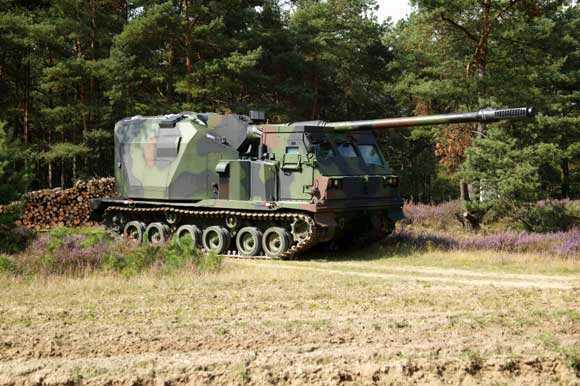
Kudos to Mark Ash for finding this!
In both editions of our Air-Mech-Strike book, we advocated using the PLS flat rack system to shoot rockets and tube artillery. Maybe the Germans picked up on the idea?
Bad news about the NLOS-Cannon FCS howitzer. Not only is its short barrel result in short-range THERE IS NO SPACE INSIDE TO CARRY ANY CREW, just a driver in front. This implies a SECOND 20-ton NLOS-FDC FCS vehicle = 40 tons = same weight as a M109A6 Paladin but at less range which is fatal in an artillery duel between armies.
We should cancel NLOS-C and FCS and buy AGM and mount it on a XM1108 Gavin /MLRS carrier on band tracks with hybrid-electric drive. We can get not only C-130 air-transportability, we can get the 40 km long range we must have fired by a 2-man crew in one vehicle and not two.
www.army-technology.com/projects/artillery
ARTILLERY GUN MODULE (AGM) MEDIUM WEIGHT SELF PROPELLED HOWITZER, GERMANY
Krauss-Maffei Wegmann's Artillery Gun Module (AGM) is an air-transportable, medium-weight, turreted self-propelled howitzer based on the proven technology of the PzH 2000 SP howitzer in service with the German Army. The system is fully autonomous and provides the same performance as the PzH 2000, but with reduced cost, crew levels and weight.
The gun module can be fitted on a tracked or wheeled chassis. The intention is to integrate the gun module into available in-service chassis for the customer country and to set up co-production arrangements with the local in-country chassis producer to provide a cost effective and medium weight indirect fire support platform.
The Artillery Gun Module development has been based on the 155mm / L52-calibre gun but the system could also be adapted for a lighter gun such as a 105mm gun or 39-calibre 155mm gun.
The module can be fitted on a heavy 6x6 or 8x8 chassis, a tracked Multiple Launch Rocket System (MLRS) hull or a main battle tank hull. It is necessary to fit hydraulically operated stabilisers and firing spades to wheeled platforms for the vehicle to withstand the recoil. The AGM installed on an MLRS chassis has a combat weight of 27t. Mounted on a 6x6 truck the combat weight is about 22.5t compared to the PzH 2000 combat weight of about 55t.
Under a completely separate programme led by shipbuilders HDW, a naval modular artillery gun, MONARC, is being developed that integrates the gun turret and autoloader from the PzH 2000 into the deck of a naval vessel.
PROOF-OF-PRINCIPLE DEMONSTRATOR
The development programme was started in early 2003. A proof-of-principle demonstrator has been built with a 52-calibre gun mounted on an MLRS tracked chassis. Preliminary verification firing trials of the proof-of-principle demonstrator were successfully carried out at the German Army's live firing range at Meppen in August and September 2004. 79 rounds were fired during the trials. Most were Zone 6 firings using Rheinmettall DM72 charge systems with a 52°C charge temperature.
The proof-of-principle demonstrator was not built with an autoloader and was manually loaded for the trials. The system successfully fired with the turret in the forward and rear positions and up to 45° in azimuth on either side of these positions. The firing tests were completed at all elevations. Some firings, but not at all elevations, were carried out with the turret at 90° to the forward position and using the most powerful Zone 6 charges.
SECOND DEMONSTRATOR
Assembly of a fully functioning second demonstrator started in the second quarter of 2005 and is scheduled for full firing trials starting in late 2005. The demonstrator includes a fully automatic loading system which loads the projectiles and the charges. A new six-cylinder engine and transmission is intended to be installed in the next evolutionary step.
GUN MODULE
The system is operated by a crew of two.
The AGM uses the main gun components from the PzH 2000, i.e. the barrel and elevating mass, the shell loader and flick rammer. The system also has a separate dedicated auxiliary power unit. The turret is of lightweight aluminium armour construction.
The 12.5t turret carries 30 projectiles and charges. The autoloader is based on a modified PzH 2000 shell loader and an automatic charge loader. The charge loader will automatically compose the selected charges using any Joint Ballistics Memorandum of Understanding (JBMOU) compliant charge module. The autoloader is powered by a 24V electrical supply.
A lifting system is installed at the front of the turret allowing the crew to reload the magazine from outside the vehicle. The ammunition feed has an automatic inductive fuse setting system. The pneumatically operated flick rammer rams the shells into the breech with elevation angle-dependent ramming pressure control.
CHASSIS
The MLRS chassis is modified with stronger torsion bars and extra shock absorbers.
The crew cabin is separated from the firing module. The crew cabin is fitted with a computerised fire control system with the NATO Armament Ballistic Kernel software implemented and linked to the KMW Artillery Command and Control System or to other command and control systems. The system can be loaded and fired manually.
The cabin provides protection against small arms rounds, anti-personnel mines, bomblets and nuclear, biological and chemical warfare attack.
PERFORMANCE
The AGM can fire against stationary and moving targets at a rate of 6 to 8 rounds per minute including Multiple-Round Simultaneous-Impact (MRSI) firing. Using standard rounds the maximum range is 30km; this is increased to more than 40km with base bleed rounds.
The into-action and out-of-action times for the AGM are similar to those of the PzH 2000 - approx. 30 seconds. The system receives target data via a radio link either while it is on the move or in a defilade position. The laying and loading data is computed and the firing command is executed. Immediately after firing the last round, the vehicle leaves the firing position in a shoot-and-scoot manoeuvre to avoid counter battery fire.
AIR TRANSPORTABILITY
The howitzer on the MLRS chassis is air transportable on an Airbus A400M transporter aircraft. With the gun in the forward position lowered over the cab the barrel overhangs the vehicle by 2.5m. For air transport, the Artillery Gun Module is 10.42m long, 2.97m wide and 3.06m high.
www.army-technology.com/projects/artillery/specs.html
SPECIFICATIONS - ARTILLERY GUN MODULE (AGM) MEDIUM WEIGHT SELF PROPELLED HOWITZER, GERMANY
Key Data
Crew 2
Dimensions
Height 3.06m
Width 2.97m
Length 10.42m
Weights
Weight module 12.5t
Weight with MLRS hull 27t
Weight with 6x6 truck Estimated at less than 23t
Weapons
Barrel 155mm, 52-calibre
Ammunition NATO standard 155mm
Performance
Traverse 360°
Rate of fire 6 to 8 rounds per minute
Range, standard 155mm rounds 30km
Range, base bleed rounds >40km
Air transportability C-130, A400M
The Army under Vanderpool did the indirect rocket helicopter mission even better by USING THE HELICOPTER ITSELF AS THE LAUNCHER.


www.redstone.army.mil/history/aviation/docs/gunsagogo.html
LTC Carle E. Dunn, USA-Ret. writes:
The CH-34 was the most powerful, single reciprocating engine helicopter in the Army. Its lift capabilities far exceeded others. Also, it had an ideal capability for the project underway. The rotors could be disengaged while the engine remained operating. Why was this important? When firing rockets in an indirect fire mode, it's best that the rotor blades be stationary.The situation encountered was this. Rocket pods were mounted on each side of an H-34. The pods held 4.5-inch rockets -- 48 of them. The concept was to fire from the ground in an indirect fire mode, i.e., the same as regular artillery. A forward observer (FO) would locate a target and initiate a fire mission. Adjusting rounds would be fired into the desired impact area. The FO would adjust fire onto the target. Then a salvo would be unleashed to fire for effect. This was standard artillery procedure.
However, the weapon system was anything but standard. And, some methods used were truly innovative. Moreover, some super-scrounging took place. The Navy had 12 railroad boxcar loads of 4.5-inch rockets. They intended to dump these missiles in the ocean. Someone at Sill convinced the Navy to ship them to the Artillery Center. They were quite pleased to present the Army with these vintage projectiles.
Field artillery employment doctrine defined tactical procedures for the H-34 test. To illustrate, imagine a planned offensive. Two H-34s are on station (in flight) in direct support of a ground unit. The FO contacts Fire Direction Center (FDC) personnel aboard one of the 34s. He calls for a fire mission.
A key element, in any field artillery mission, is direction of fire. In the evaluation scenario, initial direction of fire is laid using the Radio Magnetic Indicators aboard the 34s. The pilots land their craft pointed in this general direction. This is just as effective as many an artillery mission where the direction of fire comes from a magnetic compass.
FDC personnel know where the FO is. They also know the target's location. And, they have a direction of fire. The next objective is to get rounds on the way for the FO to adjust.
Upon landing, two individuals rush to the 34's tail wheel. They place a fabricated set of rollers beneath it. The rollers are about the size of roller skate wheels. They are held together in a semicircular frame. This enhances the ability to easily move the aft pylon while pointing the craft for direction.
Meanwhile, an artilleryman adjusts the rocket pods for elevation. He does this using a common lug wrench, similar to one used to remove lug nuts from a car's wheel. To assure correct elevation, he places a gunner's quadrant atop each pod. The elevation on the quadrant is determined by the FDC. When the gunner sees the quadrant's bubble center, the pods are at the correct elevation. Once set, two rockets are fired.
The bursting radius of a 4.5-inch rocket is about the same as a 105-mm howitzer projectile. If the FO can get two rounds within 50 meters of the target, the subsequent rocket salvo from both aircraft should be effective.
These missions took place. I watched. Moreover, I helped evaluate data from the "tests." There was controversy within the artillery community. The Infantry school, at Fort Benning, Georgia, provided their input. These idea exchanges, comments and opinions were healthy. They were helping mold future development.
A heated debate arose over which rocket to use. There were avid supporters of only using 2.75-inch rockets and restricting their use to a direct fire mode. The Infantry School stood firm on this issue.
The smaller missile, with its fin stabilization, was absolutely useless as an indirect fire projectile. This particular rocket bad enough problems in a direct fire role. Its tendency to "weather vane," i.e., turn into the wind, caused its Circular Probable Error (CPE) to be quite large in a crosswind. One comment beard at a meeting was, "Hell, there's no telling where the damn thing will go. Its CPE is already something like a 100 meters in a 1000. That's dangerous shooting close to troops!" Those words would ring in my ears during my first Vietnam tour.
Test reports from the CH-34 evaluation showed it to be almost as accurate as a 105-mm projectile when fired indirectly. The 34s also fired these rockets in a direct mode. They had similar problems as the 2.75 but not nearly as bad. A civilian defense contractor, I think it was Lockheed, had an impressive solution. The 4.5-inch, because of its larger size, could be fitted with a stabilization device. They wanted to rig the missile with a pyrotechnic gyro.
I personally attended a briefing by two representatives explaining how this device worked. Upon firing, a powder train ignited which caused a gyro to "spin-up" in 1/10th of a second. No wind, crosswinds, whatever. . . where that thing was pointed when it fired is where it went. Stated CPE was 1 meter in a one thousand. With a bursting radius of 35 to 50 meters, that's deadly at 3000 meters (9 feet approx.). To my knowledge the Army never tried this arrangement.
One evaluation consideration was aircraft vulnerability. A particularly worrisome part was when they were on the ground during a fire mission. Someone asked the question, "Why do they have to land to fire?"
This question raised some interesting observations. The most obvious were the rockets hitting the rotor blades after a launch. Some reflection brought to mind that machine guns had been firing through turning propellers since World War I (WWI). Simply link the firing mechanism to the transmission in such a way that rockets would go between the turning blades. This idea gave me goose bumps.
Furthermore, there was having to determine a firing solution while in flight. The firing battery would be on the move. The aircraft-target relationship would constantly change. No big deal, the Navy had been doing this for more than half a century.
Chuck Jarnot's T-MARS on trailer using MLRS 227mm rockets
AMS-SG author proposes we use MLRS packs on trailers to do air-mech artillery raids.
OTHER SELF-PROPELLED PRECISION ARTILLERY
HIMARS on FMTV 5-ton trucks using MLRS 227mm rockets
TOW ATGMs on HMMWV 4x4 trucks, M113A3 Gavins, Wiesels, BV-206s and BFVs
LOSAT on HMMWV 4x4 trucks
EFOGM on HMMWV 4x4 trucks
Surface-to-Surface Missiles
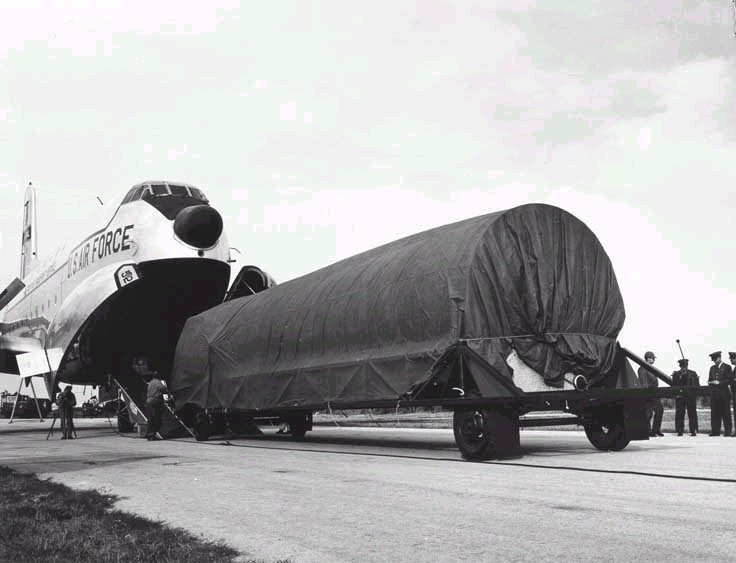
Jupiter IRBM off-load from USAF C-124 in Germany
A fascinating description of how the U.S. Army put America into space through its mobile surface-to-surface ballistic missile (SSM) program can be read on the web page below dedicated to pioneer General James M. Gavin's startling 1958 book, "War and Peace in the Space Age":
Generals Gavin and Medaris created the world's first mobile SSMs that could be deployed by aircraft in addition to their high ground mobility proven effective by the Allied Air Forces inability to target much less destroy German mobile V-2 missiles on transporter/erector launchers. This failure to defeat mobile launchers predates our failure with Scuds in Gulf War 1 and the Israeli Air Force in the recent war in Lebanon.
A very interesting short-range SSM with conventional high explosive or nuclear warhead capability is the Lance still in use by the Israeli Defense Forces.
Lance SSM on M113 Gavin modified M667 all-terrain tracked transporter/erector/launcher
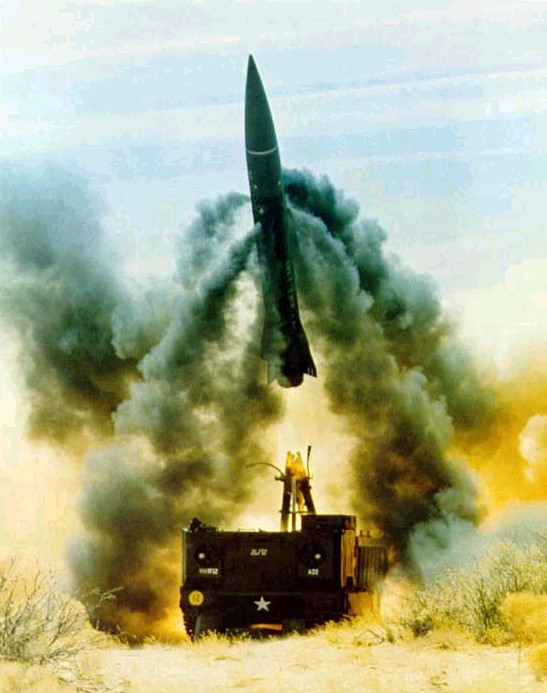
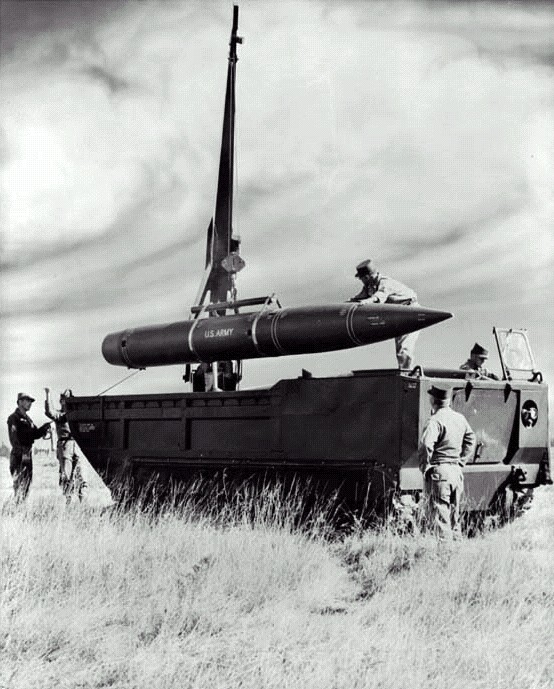
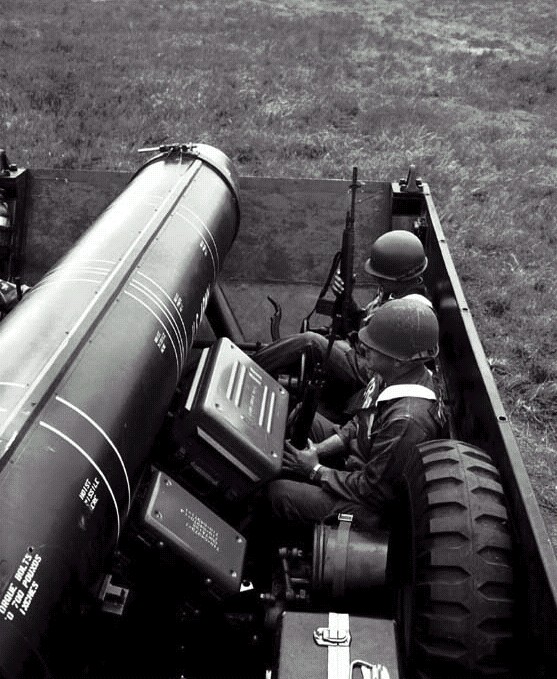
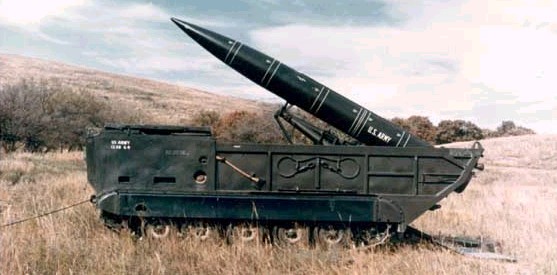
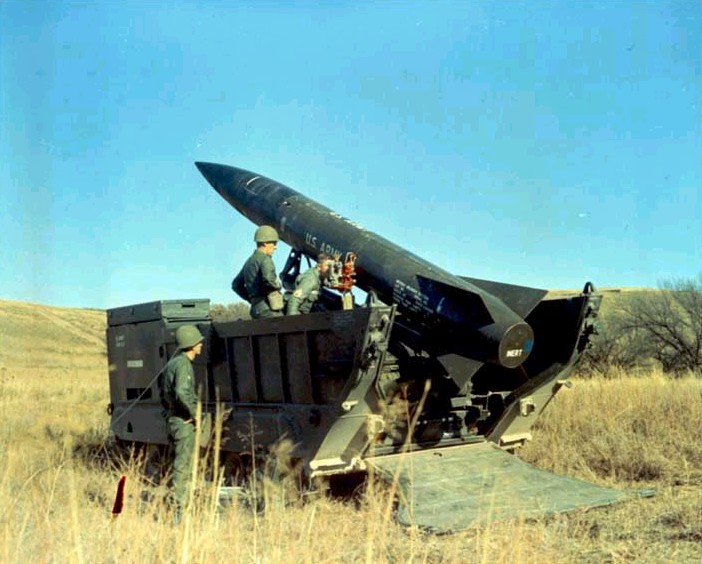
2 x Lance SSMs carried on resupply carrier
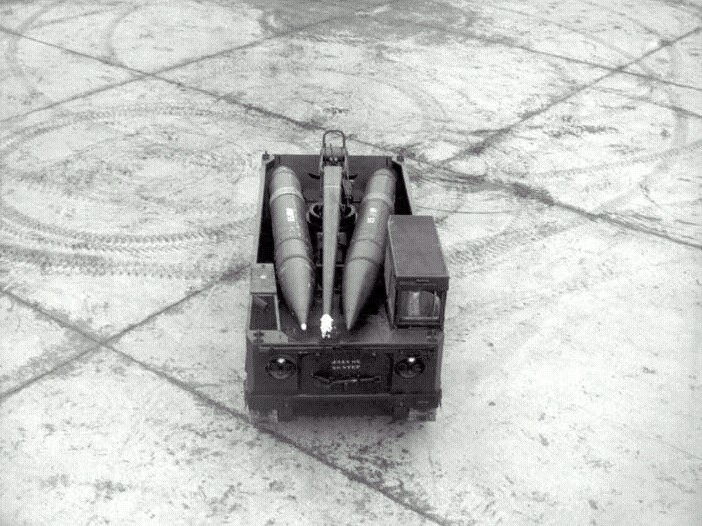
Lance SSM M667 all-terrain tracked TEL Parachute VADL from C-130 Hercules
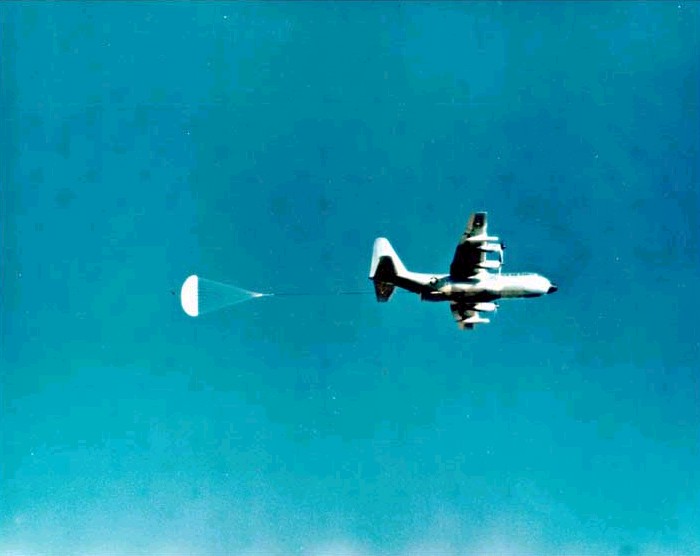
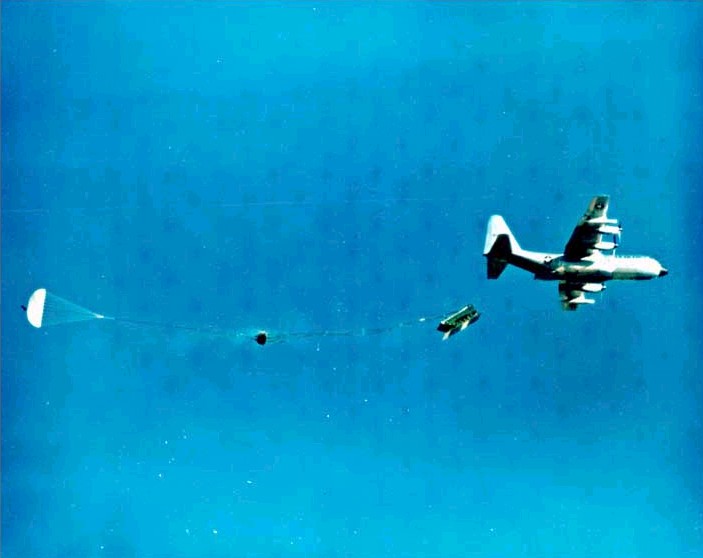
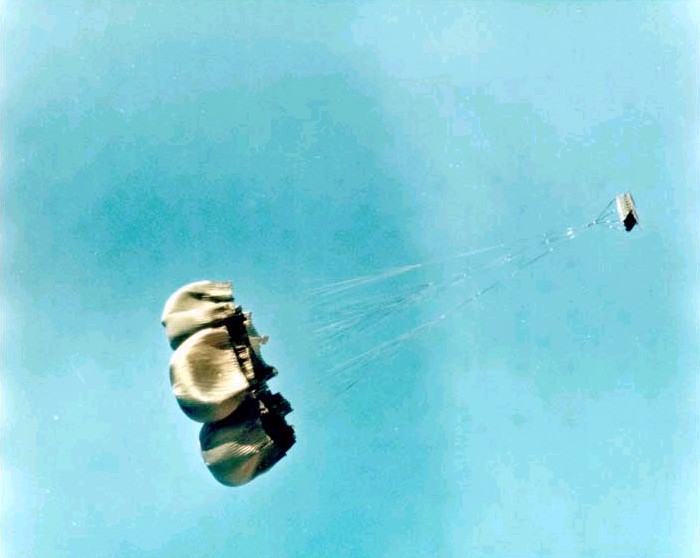
Amphibious Lance SSMs!
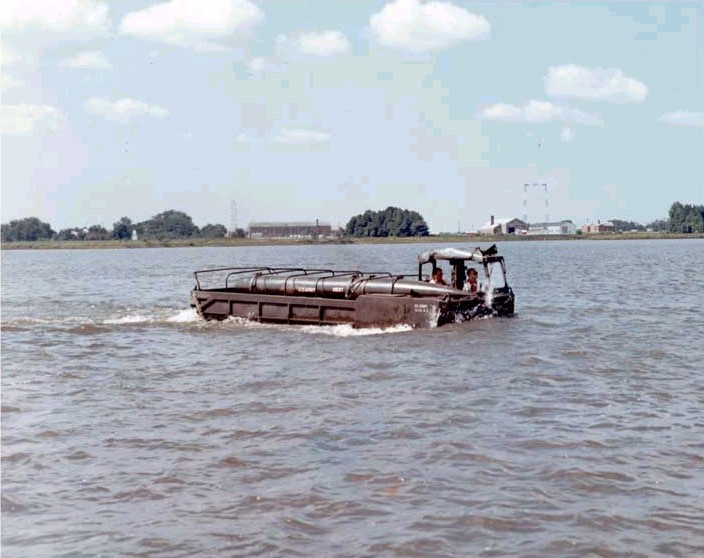
Lance SSM on wheeled trailer/erector/launcher
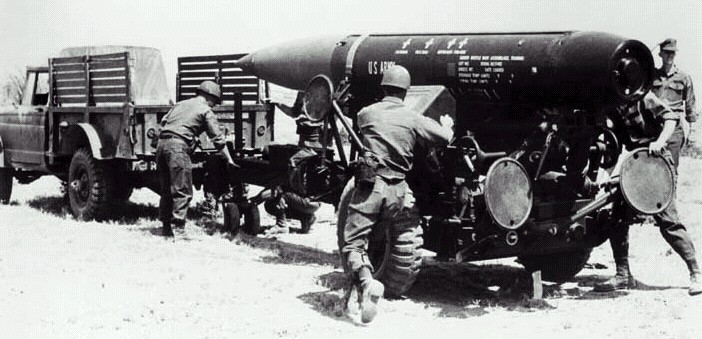
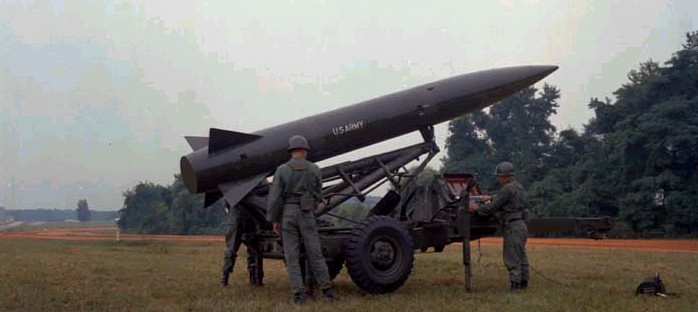
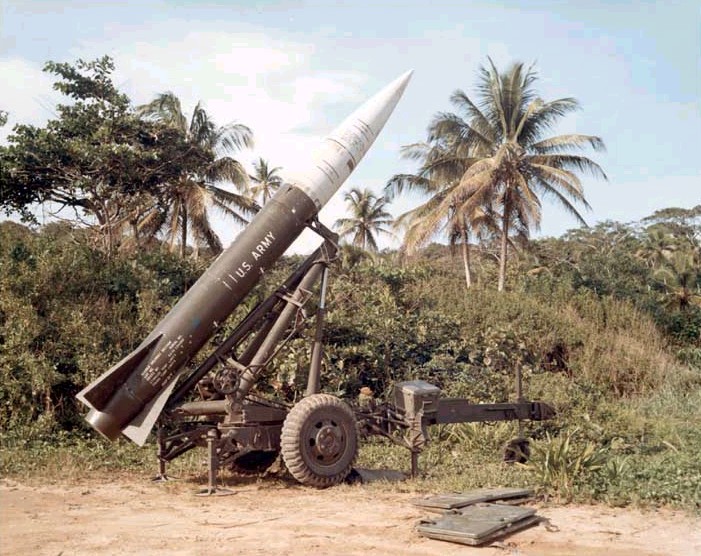
Chinook sling-load of Lance SSM on trailer from under the AMS-SG's own YCH-47A "Ghost Ship"!
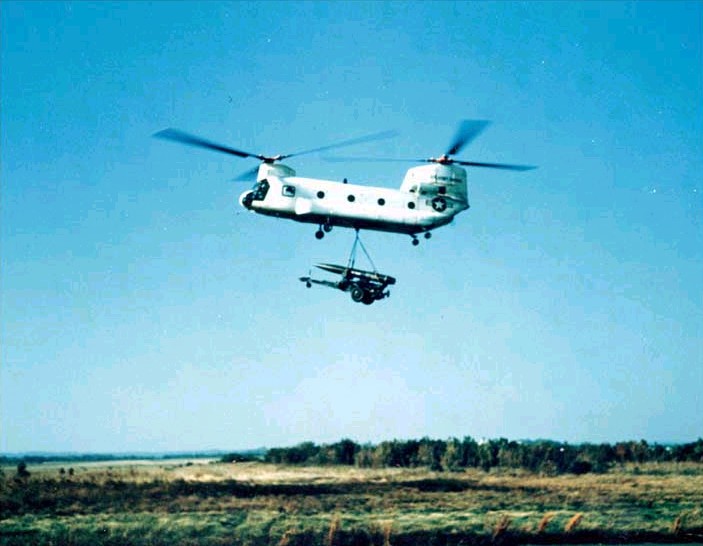
CH-47B/C/D model sling-load of Lance SSM
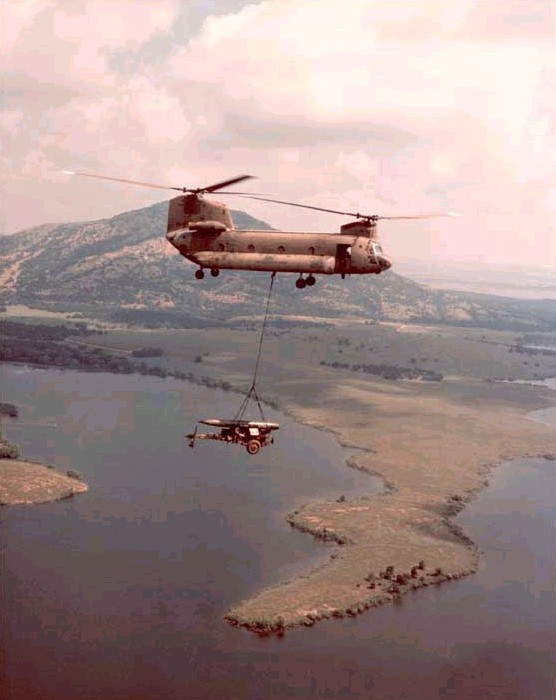
CH-47 internal load RO-RO carry of Lance SSM on trailer
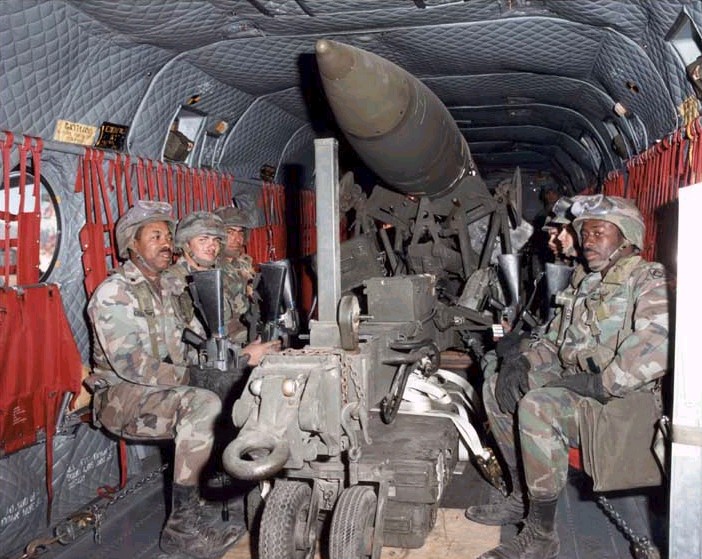
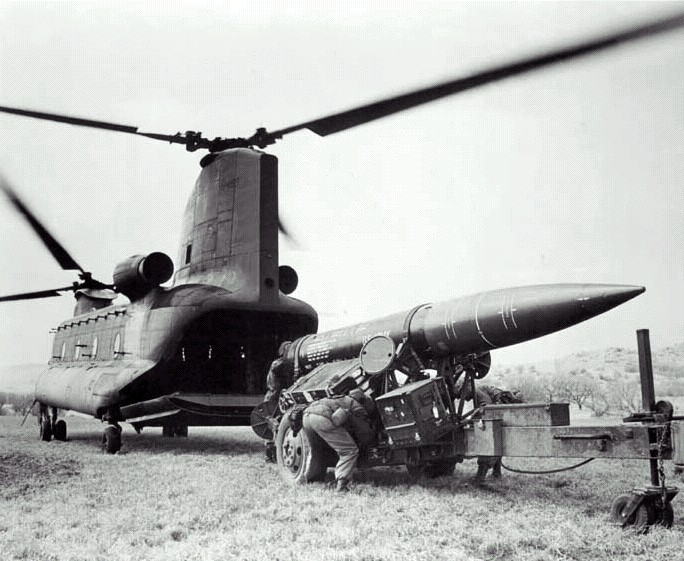
CH-47 sling-load of Lance SSM on trailer from under a CH-54
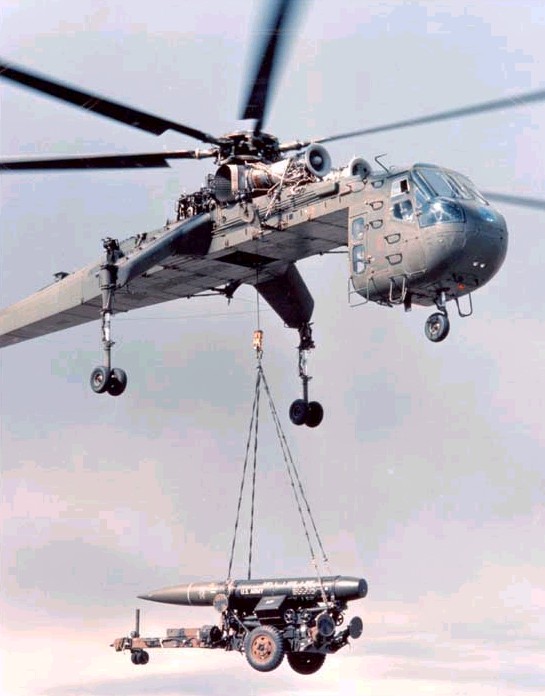
Fighter-bombers
NEEDED REFORMS:
Charles Myers' Vintage Maneuver Air Support Doctrine: needed today
Two Seat OA-10Bs with AFAC/GFACs in back; SeaHogs to give NAVAIR a High/Low Aircraft Mix
Bring back the USAF/Army "Cactus Air Force"
French SPAD XIII
German JU-87 "Stuka": the victor at Poland, France and Crete
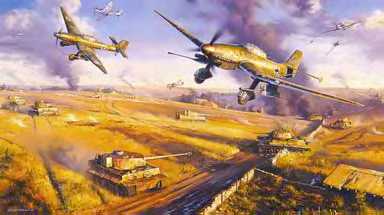
Russian IL-2 "Sturmovik"
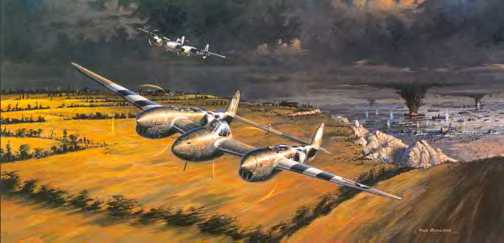
The first aircraft we had the out-performed the Japanese Zero and the German Me-109 is best described in Martin Caidin's book "P-38: Fork Tailed Devil". Like all of the other U.S. Army Air force/Corps planes in WWII, it could operate from operate from unimproved flying strips; a "Cactus Air Force"; a capability lost with today's pampered air force planes that need long, vulnerable concrete runways to operate and thus are miles away from the action on the ground resulting in Close Air Support being everything but "close". When the Japanese war mastermind, Yamamoto was flying a distance away, the 339th Fighter squadron was able to intercept and shoot him down, perhaps the critical act that sped up the war's end. With Air-Mech-Strike we will correct this. An enigmatic airplane because its guns are in the nose with the pilot and thus more easily aimed/bore-sighted than wing-mounted guns. The FACT that America's highest scoring aces Army Air Force pilots Bong (40)and Maguire (38) flew the P-38 is proof positive. We highly recommend the film, "A guy named joe" to see the P-38 in action to include an air-to-ground role. One questioned noone has answered however is how you bail out from a P-38 without hitting the rear stabilizer?
USAAF P-39 "AiraCobra"
Legendary low-level, armored CAS aircraft used by the U.S. Army Air Force 67th Fighter Squadron and 347th Fighter Wing "Cactus Air Force" on Guadalcanal to defeat the Japanese Army operated from unimproved dirt and matted landing strips like "Fighter 2". After saving the marines, the Army took over the ground fighting and finished clearing the Japanese off of the island. You see this brilliantly depicted in the film, "A Thin Red Line"
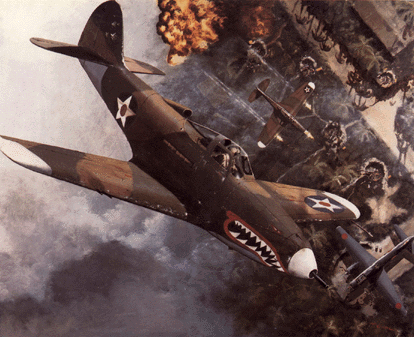
American P-40 "Flying Tiger"
Heavily armed and armored plane could out-dive the Japanese Zero; used to bomb/strafe in Far East Asia with the American Volunteer Group (AVG) "Flying Tigers" and with the RAF in North Africa. Highly recommend "God is my co-pilot" by BG Robert L. Scott.
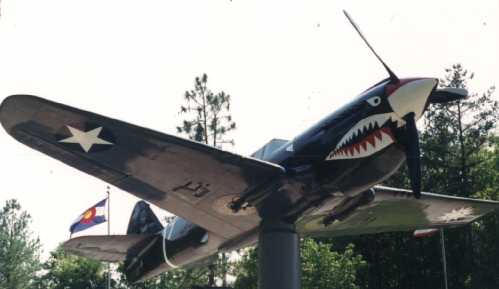
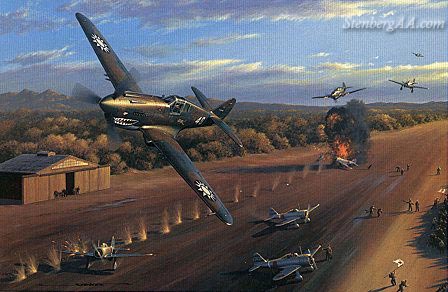
P-47 Thunderbolt
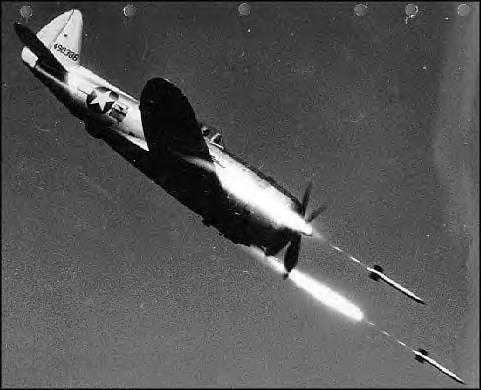
|
The Thunderbolt was a massive airplane, the biggest and the heaviest single engine, single-placed fighter ever built. The engine, the Pratt & Whitney 18 cylinder twin-row radial, developed 2,000 H.P., was the most powerful engine at the time. However, in turn, it needed a highly efficient duct system for its super-charger. The designer, Alaxander Kartveli designed the duct system first, then build the fuselage around it.
The heavy fighter was not an instant winner with the pilots that initally took it to combat. The American Ex-Eagle Squadron pilots hated it from the beginning, but the 56th Fighter Group pilots, who initally trained on the P-47, loved it! Low-altitude air-to-air combat remained a problem until a paddle blade was added, but high-altitude combat was a different story. Being radial, piston-engined using air cooling, the P-47 could take a lot of battle damage to its engine and still fly home, whereas a liquid-cooled P-51 could be shot down if its cooling system was damaged. The P-51s were used for high-altitude bomber escort missions where their streamlined high-performance was necessary to shoot down German ME-109s and FM-190s. The short range of the P-47 was a distinct handicap until the auxiliary fuel tanks were added. When it came to strafing and dive bombing, the big P-47 excelled. Following D-Day, in France the Thunderbolts performed magnificently in ground support until the end of the war.
|
P-51 "Mustang" stop-gap CAS

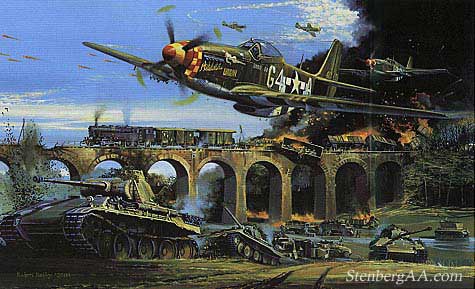
A-1 "Skyraider"
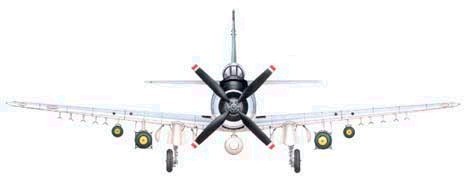
Ever see the film, "Flight of the Intruder" Skyraiders save the day, gunning down the NVA so downed A-6 Intruder fighter-bomber pilots could be rescued, art depicting what took place thousands of times during America's long war in Vietnam. Or how about "We Were Soldiers"?. This time SkyRaiders save U.S. Army Sky-Soldiers on the ground. The legendary Skyraider, with the ruggedness of the P-47 via a massive radial engine was fought by Navy and AF pilots in both Korea and Vietnam, perhaps the Son Tay POW camp rescue mission being the most significant mission strategically as it forced the enemy to treat our POWS better, saving dozens of lives.
The alleged close air support practicing USMC retired their SkyRaiders in 1957, but the wiser USN and USAF Air Commandos used "off-the-shelf" SkyRaiders to legendary effect in Vietnam.
A-26 Invader: combat in 4 wars: WWII, Korea, Cuba and Vietnam
Experience by Pappy Gunn of massing single-barrel .50 caliber heavy machine guns in the nose of first B-25s and then A-26s lead to the gunship saturation strafing of drop zones before Paratroopers jumped which continues today with the AC-130 (see below). The A-26 was renamed the "B-26" by some years later in the 1960s.
After combat in WWII, Korea, the Bay of Pigs, the A-26 was upgraded and sent to Vietnam where the USAF "Air Commandos" did tremendous damage to the Ho Chi Minh trail's supply columns, far exceeding the bomb results of the faster USAF fighter-bomber jets. Rather than seeing that it had nothing to do with one's flying skills, just the simple law of physics that slower aircraft can see targets to hit them better, the USAF waited until A-26 combat losses dried up the spare parts to keep them flying in order to pull them from active service in the middle of the war. The A-26 as a firebomber almost steals the movie, Always as Holly Hunter flies it on a desperate mission to save trapped Forest Service "Smoke jumpers".

OV-1 Mohawk: armed as early U.S. Army Air Assault doctrine intended, retired in '96 should be on duty today over Afghanistan!
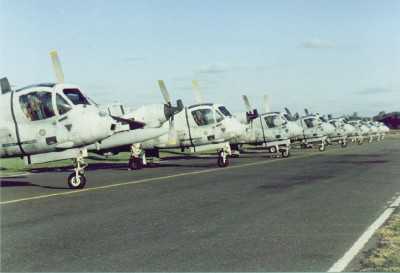
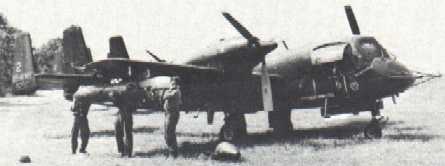
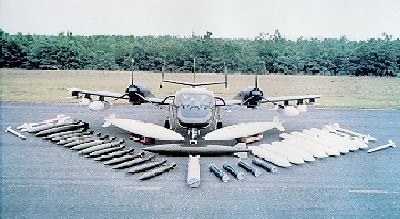
EXCLUSIVE VIDEOS! OV-1 Mohawk Video from Cold War, Vietnam and Desert Storm!
 www.youtube.com.com/watch?v=uX-48e05foQ
www.youtube.com.com/watch?v=uX-48e05foQ
 www.youtube.com.com/watch?v=7nJu3rDeomk
www.youtube.com.com/watch?v=7nJu3rDeomk
OV-1 In action photos!
OV-1 with bombs
Loading 2.75 inch rocket
OV-1 with airdrop resupply pod
Armed JOV-1C towed by jeep
Armed OV-1s taxing for STOL take-off
OV-1 mock-up with water skis
Snow ski landings with OV-1B in Germany
OV-1 mid-air refuel from C-7 Caribou
Excellent OV-1 downward visibility
Mohawk gunnery and rocket practice!
Armed OV-1 landing in Vietnam
From, the time of military balloonists, battlefield commanders have known the value of aerial reconnaissance, and the continuing need to look "over the next hill" has spawned many airborne observation platforms. The Grumman OV-1 is, however; unique among modern military aircraft in having been designed from the outset for battlefield surveillance. Strong, powerful, and purposefully ugly, the Mohawk has given the U.S. Army a versatile eye-in-the-sky for over thirty years, and it should have an important future (we should build new aircraft).
Grumman undertook development of the Mohawk in an unusual joint program sponsored by the U.S. Army and marine Corps. The two services shared broadly similar requirements for an observation aircraft with Short Takeoff and Landing (STOL) performance and the ability to operate under spartan conditions along-side frontline troops. Grumman and Lycoming were the unanimous choice of a joint service selection board for airframe and engine manufacturers, and the aircraft was designated OF-1 in marine markings and AO-1 with the Army.
As unveiled late in 1957, the Grumman G-134 Mohawk mockup had a round, insect-like nose, twin engines, and high T-tail. The roomy cockpit featured a large windshield that gave pilot and observer good downward visibility over the nose. Bulged side windows made it possible for the crew to look down at any spot on the ground, even directly beneath the aircraft, from any altitude greater than 37 ft.
The mid-wing layout gave the Mohawk a short, incredibly strong landing gear, and the overwing engine installation kept the 10 ft. diameter propeller well clear of the ground while affording the power plants some protection from groundfire. The OF-1/AO-1 also represented the first fixed-wing application for the Lycoming T-53 turboshaft, the engine then flying in the prototype Huey helicopter.
Marine requirements contributed an unusual feature to the design. As originally proposed, the OF-1 could be fitted with water skis that would allow the aircraft to land at sea and taxi to island beaches at 20 kts. Since the marines operate fixed wing aircraft in the close support role, the mockup also sported underwing pylons for rockets, bombs, and other stores.
Soon after the detailed wooden mockup was displayed, the marines withdrew from the Mohawk program for allegedly "economy" reasons, but in April 1958, the Army gave Grumman the go-ahead for nine YAO-1 prototypes. The marines went ahead years later and developed the OV-10 Bronco when it could have had OV-1s years before. The joint service roots of the Mohawk did, however, result in the aircraft being evaluated by the U.S. Navy, and all early contracts were placed through the Navy on the behalf of the Army.
By the time the first YAO-1 rolled out, the single T-tail of the mockup had given way to the distinctive three-tailed layout. Grumman engineers found the T-tail would have provided inadequate control with one engine out, and to overcome this, the aircraft would have required a hydraulically boosted rudder, an unwanted complexity in an aircraft intended for operation from rudimentary frontline bases.
Twin tails would have given the Mohawk sufficient single-engine control but poor directional stability in conventional flight due to propwash. The triple tail layout proved best, and in an unexpected example of early "stealth" technology, it created a smaller overall radar return than the original T-tail layout.
Grumman test pilot Ralph Donnell made the first flight in the YAO-1 on April 14, 1959, at the company's Peconic River test facility. The aircraft handled well, and the last of nine prototypes under the original $22 million contract was flying by the end of the year.
With its short, broad-chord wing, hydraulically operated flaps, leading edge slats and hydraulic speedbrakes, the Mohawk was very much a STOL flying machine. More than half the wing span was bathed in the wash of the big, reversible pitch propellers, and the wing incorporated a pair of hydraulically operated auxiliary ailerons that worked only when the flaps were down, for better low-speed control. Even loaded with test gear heavier than its intended reconnaissance fit, the YAO-1 could take off over a 50 ft. obstacle in about 900 ft. of runway and stop in just 300 ft.
In flight, the Mohawk had a design ceiling of 22,000 ft. and a top speed of about 320 mph. The big fuselage speedbrakes helped the aircraft make ultra-short landings, and they enabled the Mohawk to drop quickly from moderate cruising altitudes to escape enemy fighters. Drawing from a Grumman Ironworks heritage, based on the 20 year production of dependable, robust fighter planes, the sturdy AO-1 was rated plus 5g and minus 1 1/2g, and could reportedly pull up to 7g without structural damage.
Ralph Donnell's masterful demonstration routines with the snappy Mohawk often included a near hover in a stiff wind. The new aircraft had a stalling speed of just 60 kt., and with flaps down a minimum turning radius of only 355 ft. at 1.6g. Flight testing of the YAO-1 turned up some slight flutter, quickly cured by smoothing the skin of the vertical tail. The successful test program led to a second $22 million contract for 35 production AO-1AFs, the first of which were delivered to the U.S. Army Aviation School at Ft. Rucker, Alabama, in mid 1960.
The AO-1/OF-1 mockup showed Army markings and marine water skis. Skis would have enabled OF-1 to land at sea and taxi to shore at about 20 kts. Older OV-1A was used during tests of snow/mud skis in 1963. If skis were fitted, nosewheel doors were removed. Nosewheel well was plugged by ski itself after retraction. Main gear skis rotated 94 degrees for retraction. Designed to be maintained and repaired in the field. aircraft had interchangeable left-right stabilizers, elevators, and outboard fins. Wings could be removed inboard of engines to ship Mohawk by truck or train. STOL AO-1 had landing gear stressed for sink rates to 17 fpm and low pressure tires for soft, unprepared surfaces. Landings could be made in 300 to 500 ft.: takeoffs in 900 to 1,000 ft. Triple-tailed Mohawk had flaps inboard of engines and auxiliary ailerons between engines and ailerons. All primary flight controls (ailerons, rudders, elevators) were manually operated through rods, cranks, and cables. Auxiliary ailerons. speed brakes, and flaps were hydraulic. Designed to take punishment and shoot back, Mohawk had 246 Ibs. of crew armor including 1/4 in. thick aluminum cockpit floor and flak curtains.
From inception, the AO-1 had been designed to accommodate three different reconnaissance systems: conventional cameras, side- looking airborne radar, and infrared sensors. The early AO-1AF carried a single camera amidships that could take pictures vertically, or tilt 15 or 30 degrees to either side under the control of pilot or observer.
While the Army's first turboprop aircraft entered the inventory successfully, the Mohawk proved very much a "hot" ship to service aviators coming from slow, piston-engined airplanes. Its power and responsiveness tempted pilots to show off and resulted in more than a few fatal accidents. The two-seat cockpit could be fitted with dual controls for training, but operational Mohawks were most often flown by a pilot and reconnaissance systems operator. The right- hand observer's seat might have had the linkages for control stick and rudder panels, but the controls themselves were rarely in place.
With the big propellers so close to the cockpit, and with the Mohawk destined to spend much of its time at low altitudes, conventional crew bail-outs were impossible. Grumman therefore provided the AO-1 with twin Martin-Baker ejection seats that could propel pilot and observer to safety from zero altitude at any air- speed greater than 100 kts. The transparent overhead panels also could be jettisoned, but normal ejection sequence blasted the crew right through the canopy. It took some time for Army ground and flight crews to learn how to maintain and use the new seats properly, but once procedures were established, the notoriously hard seats proved themselves lifesavers.
The second of the Mohawk recon systems spawned a new model, the AO-1BF (later OV-1B). First unveiled in 1960, the B model had its Side-Looking Airborne Radar (SLAR) in an 18 ft. long fiberglass pod suspended from the right side of the fuselage. To save weight, the fuselage speedbrakes and wing leading edge slats were deleted, but the wings themselves were extended 6 ft. for additional lift. The B also incorporated an autopilot that helped fly uniform radar mapping patterns.
Despite its ungainly appearance, the SLAR-toting B handled quite well. In 1971, a single example was loaned by the Army to the U.S. Geological Survey for geologic and hydrologic studies under the direction of Herbert Skibitzke. Over the next four years, systems specialist and pilot Mary Lou Brown was to fly the USGS Mohawk on survey missions all over the United States.
As she recalls: "The Mohawk was a delightful plane to fly. Perhaps I should quality that statement. The 'B' model had a longer wingspan...and it was considered to be the safest model. We had no experience with the 'A' or 'C' models; however, we knew of several accidents with those models that were attributed to the shorter wingspan.
"Our pilot checkout procedure was informal and abbreviated. First, we read the manual. Then, Skibitzke rode in the right seat observing while a qualified Army instructor flew the plane. They then traded places, and Skibitzke piloted the plane with the instructor in the right seat. The process was repeated twice with Skibitzke being the check pilot for Ruby Sheldon and me. After several takeoffs and landings, we felt quite confident in the Mohawk."
The radar imaging capability of the Mohawk was to prove a significant advance in both peace and war. The SLAR could look through foliage and map terrain, presenting the observer with a film image of the earth below only minutes after the area was scanned. In military operations, the image was split in two parts - - one showing fixed terrain features, the other spotting moving targets.
In mid-1961, the first Mohawks to serve with U.S. forces overseas were delivered to the 7th Army at Sandhoffen airfield near Manheim, Germany. Before its formal acceptance, the camera-carrying AO-1AF was flown by Ralph Donnell on a tour of 29 European airfields to show it off before the U.S. Army field commanders and potential European customers.
Germany and France had shown early interest in the Mohawk, and Grumman actually signed a license production agreement with the French manufacturer Breguet in exchange for American rights to the Atlantic maritime patrol aircraft.
Projected European versions of the Mohawk were to have had the more powerful DeHavilland Gnome turboprops, but orders never materialized. Two radar-equipped OV-1Bs were, however, evaluated in both German and French markings in 1963.
The Berlin Crisis led President Kennedy to bolster U.S. forces in Europe and, as a result, eleven OA-1s were hurriedly cocooned for shipment to Germany in November 1961.
Stateside test work with the AO-1 continued. The aircraft performed well at temperatures down to -50 degrees F during a deployment to Fort Greely, Alaska, and in February 1962, two AO-1As maintained near perfect availability during the arduous Alaskan winter exercise Operation Great Bear at Fort Richardson.
When the Department of Defense reorganized American military aircraft designations in 1962, the Mohawk models were tagged OV-1A for the visual recon/photographic version, OV-1B for the SLAR toting variant, and OV-1C for the infrared reconnaissance bird.
That same year also marked the debut of the Mohawk in the Far East when the first OV-1s were delivered to U.S. Army training units in Japan.
The OV-1 was soon to take part in one of the earliest elements of American involvement in Vietnam, In July 1962, the 23rd Special Warfare Aviation Detachment (Surveillance) was formed. The unit arrived in the Republic of Vietnam in September with six OV-1As to provide reconnaissance capability for the South Vietnamese Army (ARVN). They were flown by American pilots and South Vietnamese observers.
The ordnance-carrying potential of the OV-1 soon generated a long- running feud between the Army and the self-centered Air Force, and among small-minded factions of the Army aviation community itself. Tested with a varied collection of bombs, rockets, gunpods, and other stores, the OV-1 proved itself a nimble and potent weapons platform. It did, however, venture into what was considered the operational realm of the Air Force even though the USAF really has been disinterested in helping the Army win battles with CAS for decades, so OV-1s provided fixed-wing air support for Army ground forces in Vietnam. The running battle over who should be responsible for such missions became so heated that at one point the Air Force demanded Grumman suppress company brochures stressing the attack potential of the OV-1. Typical corruption from the selfish USAF that doesn't want to do CAS and at the same time doesn't want anyone who does want to do it to be able to provide battle-winning and life-saving CAS.
Mohawk armament in the early stages of the Vietnam war was specifically restricted to 0.50 caliber heavy machine gun pods, and pilots were ordered not to fire unless fired upon by guerilla forces. Nevertheless, the OV-1s did provide important information to field commanders on Viet Cong movements, and their usefulness was to result in additional deployment as the American presence in southeast Asia grew.
The photo reconnaissance OV-1As were joined in 1963 by specially modified JOV-1Cs of the 11th Air Assault Division based on the more powerful "C" version of the Mohawk, the armed reconnaissance JOV was stripped of the sophisticated infrared sensing gear that distinguished the "C" model and equipped with gunsight, dual controls, and two additional stores pylons. (All Mohawks had six wing hard-points but normally operated with only two or four pylons in place.) The aircraft represented the Army's exploitation of the attack capability of the OV-1, specifically in support of troop-carrying helicopters. It was to prove a successful and highly controversial (to the selfish USAF) experiment. We should ask the men whose lives were saved if the effort was worth it.
More Mohawks appeared in Vietnam in the fall of 1964 when the 4th Aerial Surveillance and Target Acquisition (ASTA) Detachment arrived with a mix of radar-equipped OV-1Bs and infrared recon Cs. By spring, 1965, the thirty Mohawks in Vietnam had been combined in the 73rd Aerial Surveillance Company based at the former seaside resort of Vung Tau, 35 miles southeast of Saigon.
Despite the value of the OV-1s in providing American and South Vietnamese field commanders with their own, responsive reconnaissance capability, the U.S. Army remained unsure of the value of the Mohawk. The very nature of the joint Army/marine program had forced design compromises that made the aircraft an expensive and, sometimes, openly resisted item in Army budgets. Orders for the OV-1 stopped in Fiscal 1964. Service politics comes before the mission and the men.
Fast, quiet, and rugged, the Mohawks in Vietnam proved their worth time and again. At the full-scale battle of la Drang in 1965, and later in the Bong Son campaign, the few Mohawks available provided the ground forces with important visual reconnaissance reports and CAS firepower, and the growing usefulness of SLAR and IR imagery became increasingly apparent to the other American services. The Air Force used precision targeting data from OV-1s to direct B-52 strikes (no complaints from the USAF when its helping them get the glory). Navy coastal patrol forces were directed to infiltration points discovered by Mohawk radar; and the marines made good use of Mohawk night recon data in the conduct of Operation Starlight in August 1965.
Operational success led to additional Mohawk orders in 1966, and by 1968, five surveillance companies were operating in Southeast Asia.
Regardless of official policy, OV-1s in Southeast Asia often flew armed with a mix of rocket and gun pods because troops in the field tend to be more mature and driven by common sense. The rugged constitution of the aircraft proved a blessing for flightcrews, particularly when Viet Cong forces were equipped with heavier weapons and learned how to use them against low-flying aircraft. One Mohawk returned to base with more than 90 holes in one wing, another with its empennage nearly severed by an anti-aircraft hit. One, nicknamed "Old Yeller" for all the zinc chromate dabbed over its battle patches, was mortally wounded after 900 combat hours. Unable to lower or shake one landing gear down, the pilot ordered the observer to eject, then followed himself. A Grumman technical representative later confirmed that the abandoned Mohawk obligingly crashed in a nearby scrapyard.
By night, photo reconnaissance OV-1s flew with two box-like dispensers mounted over the aft wing roots, each with 52 upward firing flares. Catastrophic accidents in which improperly loaded flares fired down and detonated the entire package led to the introduction of a more effective strobe light pod that could generate up to 300 powerful flashes a flight, one every 3 seconds.
Of far greater value was the radar and infrared imagery provided by OV-1Bs and Cs. Day or night, in any weather, the Mohawks could paint details of enemy movement and disposition on continuous film strip maps of the terrain below. The SLAR system could look to the left or right of the flight path, or scan both sides at once. The "Red Haze" infrared system painted a picture of the earth directly under the aircraft, detecting telltale heat traces of truck engines, campfires, or other disturbances ordinarily hidden by darkness, camouflage, or the density of the natural jungle canopy.
The Viet Cong developed a fearful respect of the all-seeing Mohawk. They reportedly dubbed the quiet OV-1 "Whispering Death," and they offered a standing reward of 50,000 piastres (then, 118 piastres to the dollar) to any gunner downing a Mohawk.
From the first American presence in Vietnam to the final withdrawal, the OV-1 provided an important dimension in intelligence gathering.
Last of the principal Mohawk versions to enter production was the versatile OV-1D with more powerful T53-701 engines, improved avionics, and interchangeable mission pallets that make it possible to switch the aircraft from infrared to SLAR configuration in about an hour. The first four OV-1Ds were prototypes converted from earlier production airframes, and the first flew in 1969. These were followed by 37 new-build aircraft, the last of which was delivered in December 1970.
While the OV-1 was never the subject of heavy export sales, two olive drab D models were transferred to Israel direct from U.S. Army stocks in 1974, and their delivery was kept a closely guarded secret for more than a year. Despite the Israeli penchant for secrecy, the aircraft were flown out of Lod International Airport. A Pan Am copilot reportedly photographed one from the cockpit of his waiting jet and was met in Rome by Israeli agents demanding the film! The aircraft are evidently still in Israeli service, conducting classified surveillance operations.
Grumman also demonstrated the OV-1 to the Philippines Air Force in 1974, again stressing the counterinsurgency potential of the armed Mohawk. No sale resulted.
In the score of years since the OV-1 entered Army service, this powerful, versatile machine has set its share of performance records. On June 16, 1966, test pilot Jim Peters flew an OV-1 to 3,000 m (9,842 ft.) in 3 min., 41 sec., and to 6,000 m (19,685 ft.) in 9 min., 9 sec. He also held the OV-1 at 32,000 ft. sustained altitude, all world records for a turboprop aircraft in the Mohawk's weight class. A month later, Army Colonel Edward Nielson flew an OV-1 to a new turboprop speed record when he covered a 100 km closed course in 12 min., 48.8 sec. at an average speed of 292 mph.
Unusual in that it marked one of the few world record attempts to be made by an Army tactical unit, an OV-1C of the 293rd Aviation Company based at Fort Hood, Texas, set three new time-to-climb records in June 1971. The unpressurized Mohawk with uprated T53-L15 engines also climbed to 39,880 ft. peak altitude and sustained 36,352 ft. Before their flight, CW2 Thomas Yoha and Capt. Richard Steinbock had to pre-breathe pure oxygen to eliminate nitrogen from the blood-stream and prevent decompression sickness at high altitude.
The specialized sensing capabilities of the Mohawk have proven useful to several civilian government agencies. With its radar modified for the survey role, the single OV-1B of the U.S. Geological Survey participated in a series of geologic and hydrologic studies, mapping fractured rock formations, limestone sink holes, and other phenomena to help document water resources.
The first survey mission flown by the USGS was to detect surface water in the jungles of Panama as part of the Inter-American Geodetic Survey. In September 1971, project head Herbert Skibitzke was on the way to the Canal Zone when bad weather diverted him to Tapachula, Chiapas, Mexico, Low on fuel, he found the runway covered with slick, rain-soaked volcanic ash. Ordinary braking would have caused any conventional aircraft to swerve dangerously on landing, but the reverse thrust of the twin-engined Mohawk brought it to a safe stop.
In 1974, the USGS OV-1 surveyed the route of the Alaskan oil pipeline, and later that year, it helped study pack ice in the Beaufort Sea off the north coast of Alaska. In the frozen Arctic, using an ejection seat to abandon a crippled aircraft meant almost certain death by exposure. The OV-1B was consequently equipped with underwing pods packed with emergency flotation gear that would let survey crews ditch and survive. Fortunately, the situation never arose.
Supporting the lone Mohawk posed its own problems. "Maintenance was a nightmare," according to Mary Lou Brown, "especially in the Arctic. The aircraft and all its components were highly specialized. Parts could be procured only from the Army, and special tools were required for all the special parts. The hydraulic system was particularly vulnerable to the extremely cold temperatures of the Arctic; but then a main gear collapsed on landing at Phoenix Sky Harbor where the temperature was more than 100 degrees. The SLAR antenna made an excellent skid... On one memorable Arctic flight, Skibitzke had departed Fort Wainwright, in Fairbanks, after the plane had been in for maintenance, to return to our base at Point Barrow. As he approached the Yukon River, there was a resounding thud as first one gear and then the other dropped out of the wells and dangled beneath the plane. Attempts at recycling were ineffective. With about 400 miles of frozen tundra and the Brooks range between him and Point Barrow, he turned back to Fort Wainwright for another maintenance session."
The Mohawk continued its valuable survey work until 1975 when the aircraft was turned over to the Naval Air Test Center at Patuxent River, Maryland.
Another "renegade" OV-1 served with the Environmental Protection Agency in the early seventies. EPA bailed an OV-1C from the Department of Defense and used the panoramic nose camera and infrared sensing system to document oil spills, strip mine land damage, industrial waste flows, and other phenomena. The aircraft was flown from the EPA facility near Las Vegas, and returned to the Army in 1976.
After more than eight years of service, four OV-1Cs still fly with the U.S. Customs Service, hunting for drug smugglers with a non- standard, nose-mounted infrared system.
NASA too has found some uses for the Mohawk. An OV-1B was modified by Grumman to carry a small jet engine under the right wing. With it, carefully controlled flight profiles are flown over a test range to measure aircraft noise characteristics.
Additional early-model Mohawks have been brought up to the latest OV-1D standard, and if service longevity is a measure of design success, the OV-1 is undoubtedly a successful airplane. By the end of 1980, the Army had 25 x OV-1Bs, 26 x Cs, and 84 x Ds in active and reserve units. Starting in 1972, the Army National Guard began to receive the Mohawk, and in 1981, the Guard had 13 x OV-1Bs, 24 x Cs, and 16 x Ds serving with three units in Georgia and Oregon.
Grumman at one time proposed a single-seat attack version of the Mohawk with powerful T-55 engines and 30mm cannon in response to the Air Force AX competition. The production contract eventually went to the Fairchild Republic A-1O. Another Mohawk derivative with an extended nose for extra seats and special electronics never advanced past the drawing board.
There is, however, a specialized, little publicized Mohawk in service. The RV-1D performs classified electronic intelligence duties and is distinguished by two large underwing pods.
Before folding, Grumman continued to update Mohawks at the company's Stuart, Florida facility. And with new avionics and nap-of-the-earth flying tactics, Grumman's bug-eyed, multi-sensor bird served with the Army well into the nineties.
Overshadowed by sleek spyplanes and all-seeing satellites, the OV-1 should have remained a potent, responsive reconnaissance platform -- one that will stay in the frontlines of aerial intelligence gathering for some time to come.
CLOSE AIR SUPPORT YES OR NO? TROOPS OR POLITICS?
Since its inception as a joint Army and marine program, the OV-1 Mohawk had been a center of controversy. Actually the Army and marine requirements were never compatible and compromises were made that suited neither. From the Army's viewpoint, the original design was compromised by shipboard requirements and other specific marine specifications which had little application for an Army observation aircraft. From the marine viewpoint, they were looking for a fixed-wing replacement for the old Cessna L-19 "Bird Dog" light observation aircraft and they did not require sophisticated sensor systems which they planned to carry on other aircraft (like what?). As it turned out, the marines dropped out of the development program before the first prototypes were ready for flight.
Because the Mohawk was an exception to the Secretary of Defense's memorandum on weight limitations for Army aircraft and because it had inherent capabilities for armament, the Air Force had opposed its development from the beginning. There is no doubt that certain Army visionaries viewed the Mohawk as the "nose of the camel within the tent of tactical air support." The Army was to suffer for their enthusiasm for years to come by narrow-minded types who wanted to centralize control of CAS when it was proven CAS is best done decentralized under ground maneuver force control. The manufacturer, Grumman, published carefully placed brochures which showed the Mohawk in a variety of attack roles.

The Mohawk was originally designed as a visual reconnaissance aircraft with better survivability than the L-19 "Bird Dog" of Korean vintage. In addition, it was to have an integral camera system for spot photo coverage. Above all, it was to land and take off in the same distance as the L-19 which it was to supplement. It was not long, however, that "improved" versions of the Mohawk were visualized carrying sophisticated sensor systems developed by the Army surveillance agencies such as infared and side-looking radar. Weight, space, and power provisions had not been made for these systems in the original design. As a result, the gross weight increased and performance declined. These growth versions of the Mohawk were coming off the drawing board before the first "A" model had even been tested throughout its entire flight envelope and subsequent tests were to prove that major engineering modifications to both wing and power plants would be necessary in the latter versions. Furthermore, the addition of all this sophisticated sensor equipment not only raised the unit cost significantly but, in the view of many, watered down the Army contention that this was truly a front-line low-echelon aircraft.
Regardless, many OV-1s unencumbered by sensor arrays went ahead and flew armed CAS missions, saving many lives and winning many firefights.
It is important to review its actual performance in Vietnam in 1962. The six armed Mohawks did a magnificent job and many Army advisors pleaded for more of the same. The missions performed by these aircraft during this period were somewhat tangential to the story of airmobility in the Army. However, this does not take anything away from the individual accomplishments of the Mohawk pilots.
After a storm of controversy in the Pentagon, the 23rd Special Warfare Aviation Detachment was deployed to Vietnam in September 1962 for the purpose of providing air surveillance in support of Republic of Vietnam forces. In addition, they were to serve as a test unit for operational evaluation conducted by the Army Concept Team in Vietnam. The 23rd Special Warfare Aviation Detachment (Surveillance) was organized in July 1962 as a prototype armed aerial surveillance unit using the OV-1 Mohawk aircraft. Besides its headquarters and photo processing section, there were three flight teams, each consisting of two armed Mohawks, four pilots, and seven enlisted maintenance and armament specialists.
When they were deployed to Vietnam their rules of employment specified that: on all operational flights a Vietnamese observer would be aboard; that the aircraft would be armed with .50 caliber heavy machine gun weapons only; and, that this armament would be used only when required to defend against a hostile attack. The 23rd Special Warfare Aviation Detachment was assigned to Support Group, Vietnam for administration and logistical support. Operational control remained with Commander, Military Assistance Command, Vietnam, who decided to place the Mohawks in support of II Army of the Republic of Vietnam Corps. From 16 October to 22 November the entire unit was stationed at Nha Trang supporting the 9th Division and the Railway Security Agency. On 23 November one flight team was moved to Qui Nhon, 100 miles north of Nha Trang, to be closer to the 9th Division.
The plan of test for the 23rd Special Warfare Aviation Detachment called for systematic surveillance of a sector that would insure an even distribution of effort over a selected tactical area. However, it soon became abundantly clear that the supported units were generating so many missions for specific reconnaissance sorties within their tactical areas that no other missions could be flown. In each area, an element of the 23rd Special Warfare Aviation Detachment was employed under the direction of the Army of the Republic of Vietnam commander, through his U. S. advisor, as an integral part of the total available force. Because of the many variables involved, the specific contribution of the Mohawk to the reduction of Viet Cong incidents could not be quantified. But, there was no question that the 23rd Special Warfare Aviation Detachment inhibited and restricted Viet Cong activity.
Visual and photographic reconnaissance by this twin-turbine airplane produced a wealth of intelligence for supported units. Hundreds of structures, most of them camouflaged, were detected in Viet Cong base areas. Likewise, hundreds of people were sighted in suspect areas and, because of the detailed familiarity of Mohawk crews with the local situation and activity patterns, some of the people sighted could be positively identified as insurgents. One of the unique advantages of the Mohawk in reconnaissance was its speed to noise relationship which allowed the aircraft to get within observation distance of people on the ground without alerting them to it's presence. In one Division, artillery fires directed from the air were nearly tripled by the activities of Mohawk observers. Supported units quickly developed air to ground procedures to exploit the capabilities of the immediately available Special Warfare Aviation Detachment aircraft.
From 16 October 1962 to 15 March 1963 the 23rd Special Warfare Aviation Detachment flew more than 2,000 hours in the performance of 785 combat support missions. It had delivered defensive fire 27 times and had lost two aircraft. The cause of the loss of these two aircraft was never determined.
Many of the U. S. Army advisors wrote glowing reports of the Mohawk pilots and urged Military Assistance Command, Vietnam, to relax the rules of engagement. For example, on 23 March 1963 the Senior advisor of the II Corps Tactical Zone, Colonel Hal D. McCown, Wrote:
... Two Mohawk aircraft are constantly based at Quang Ngai airfield for close and immediate support of the 25th Infantry Division. Results of Mohawk operations there thus far include the following:In another letter, dated 19 March 1963, the Senior Advisor of the 25th Army of the Republic of Vietnam Division, Colonel Paul A. Baldy, echoed many of Colonel McCown's remarks and added his own list of impressive data. He closed his letter with the following:a. Rapid production of low level aerial photographs of VC troop dispositions and installations as well as photographic coverage of prospective operational areas of the 25th Infantry Division.
b. A large volume of combat intelligence has been produced by visual sightings of troops in the open including weapon emplacements.
c. A bonus effect has been obtained from the defensive machine gun fire put down by the Mohawks when fired upon. Some VC casualties have been observed from these fires.
d. During the period 15 February to 8 March, artillery adjustment by Mohawk observers on VC troops sighted accounted for an estimated 65 enemy casualties. Combining these casualties with those noted in subparagraph c above, it is concluded that the Mohawk has either directly or indirectly caused more VC casualties during this period than all other military forces in Quang Ngai, including RVNAF air strikes.
Furthermore, I consider that the attack by the well equipped Q 95 VC Battalion in the Bato area on 3 March was relatively impotent. This was most probably due to actions by Mohawk aircraft on the days immediately preceeding the attack. These aircraft were responsible for sighting and adjusting fire on large groups of armed VC within a few thousand meters of the scene of the attack.
Despite this fine performance, the full potential of the Mohawk aircraft cannot be realized because of the present test restrictions. I refer to the limitation of armament to the .50 caliber [ED: heavy, single-barrel] machine guns.
The Mohawk aircraft consistently locate remunerative targets which are beyond the range of friendly artillery. The majority of these targets are small bodies of troops in the open. In counter-insurgency operations this is the type target most likely to be encountered. These are fleeting targets, and unless immediately engaged, will disperse and disappear. They are long gone before a friendly air strike can be mounted.
On the several occasions that the Mohawk has encountered and returned ground fire, the aircraft limitation to .50 cal machine guns has considerably curtailed the effectiveness of this defensive response. It is apparent that the addition of rockets, napalm and small fragmentation bombs would have greatly increased the number of VC casualties inflicted during the past few weeks. Further, this vastly increased fire-power capability would have a profound impact on the VC ability to conduct daylight troop movements. This would seriously hinder their tactical initiative, especially in Quang Ngai Province. It is also believed that this increased defensive firepower would enhance the surveillance capability of the aircraft by allowing greater low level freedom of movement.
It is my considered opinion that the Mohawks' success can be attributed to their immediate responsiveness to the ground commanders. In a counter-insurgency operation such as we have in Vietnam with its fleeting and elusive targets, the immediate and direct control over an aircraft as swift, silent and well-equipped as the Mohawk, flown by pilots with intimate knowledge of the terrain and the current enemy situation, is an invaluable asset to a commander.Similar letters of praise came from the 9th Infantry Division advisors and the senior railway security advisor. In the case of railway security, enemy attacks decreased by 50 percent after regular surveillance was begun by the 23d Special Warfare Aviation Detachment. Nevertheless, the career of a railway engineer in Vietnam was considered to be non-habit forming.
There is no doubt that the Mohawks filled a real intelligence need for the U. S. Army advisors in the field. For the first time the advisors found themselves with a responsive tool in the form of the Mohawk under their direct operational control to fill in the many gaps in their intelligence. Their requests for aerial surveillance and fighter strikes through the cumbersome channels to the Vietnamese Air Force no doubt increased their desire for more Mohawk support. As can be seen from the above, there was the inevitable trend to use the Mohawk in the CAS fighter role, mainly because it was there and it had the hard points necessary to carry armament.
The Army Air Assault Division as defined by the Howze Board was supposed to have 24 armed OV-1 Mohawks but instead had to settle for 6 unarmed Mohawks, and the result was less CAS and more deaths in Vietnam due to service bickering. When it comes to war, the fighting man should get what he needs, period.
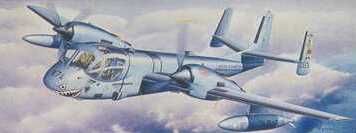
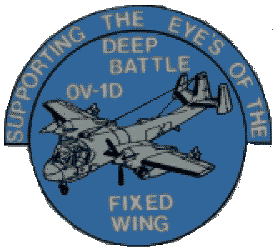
The Mohawk as an unsurpassed recon platform continued into Desert Storm until retired in 1996. The OV-1s should be in service today as an armed Maneuver Air Support recon "Cavalry" platforms to prevail in fights like Anaconda and new models built since they are far faster (300+ mph) than RAH-66 Comanche scout helicopters (150 mph) and more agile and survivable than dumb UAVs. Plenty of OV-1s are in civilian ownership that could be bought back to stand up a squadron in the U.S. Army.
Tilt-Wing OV-1 Mohawks: VSTOL that works
We should cancel the failed USMC/USAF V-22 tilt-rotor boon-doggle and field tilt-wing OV-1s based on proven CL-84 technology.
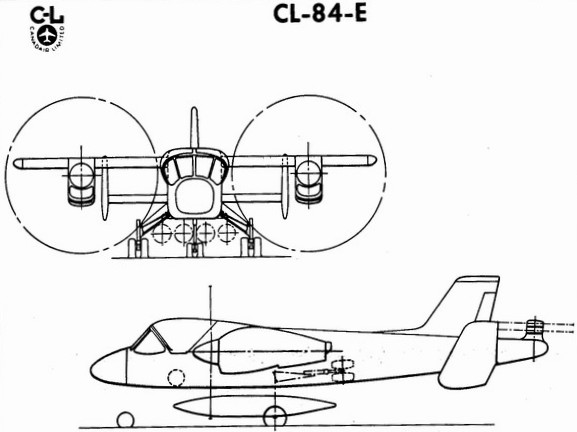
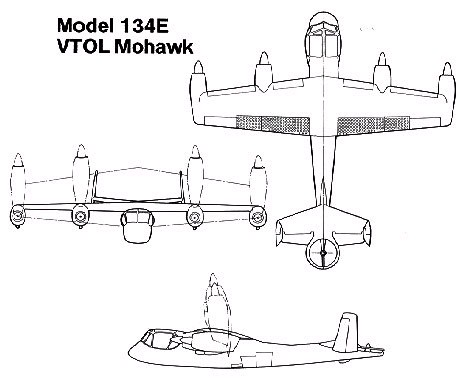
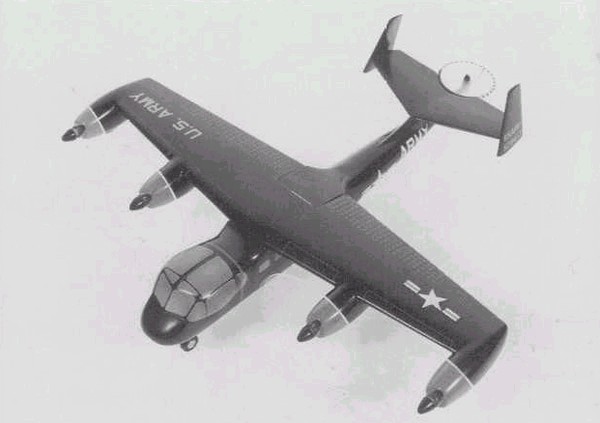

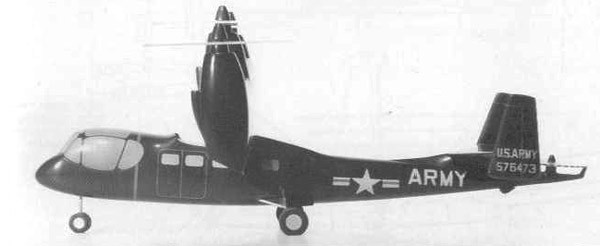
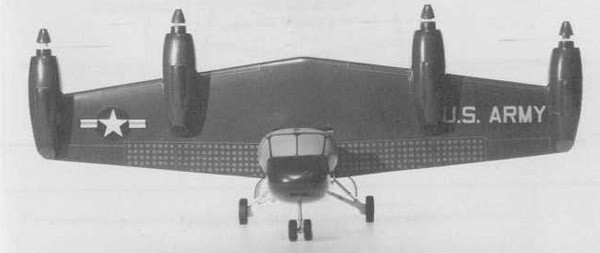
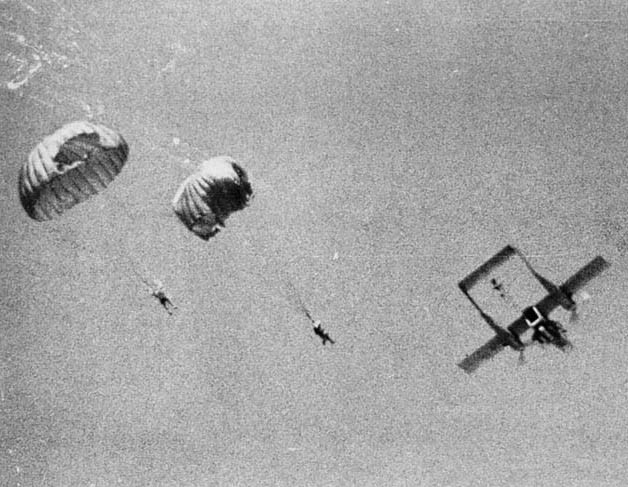
When the egotistical brass at HQMC backed out of the Army OV-1 program in the late 1950s, it left the real marines in the field without a survivable observation/attack plane. A few Bird Dog IIs were bought but they were still at best 150 mph airplanes with no armor and gasoline engines. Then an amazing LARA concept by legendary marine combat pilot, K.P. Rice came to the forefront.
However, DoD ruined the LARA concept of a plane that could land anywhere the grunts were and made the OV-10 into yet another runway, air base dependant plane so as to not rock the status quo. The OV-10 was a somewhat STOL capable plane that could drop 4 Paratroopers, lay a smokescreen and fire ordnance, yet was retired when two early-model OV-10As without infared missile defensive measures but with marines inside were shot down, captured and killed in the coverless, open terrain of Iraq during Desert Storm; now we lack an effective aircraft carrier-based Airborne FAC having to press the inadequate, too fast, fuel-hungry 2-seat F/A-18 into service in this role. We have no FAC aircraft that can fly off the deck of the smaller amphibious carriers. So much for USMC boasts that they value "close air support". They are hypocrites of the first order. The USAF fighter-bomber jocks hate CAS, but at least they operate the A-10 Warthog offering actual not make-believe CAS capabilities.
The USMC should have never backed out of the OV-1 Mohawk program because their weak egos couldn't tolerate working together with their rivals in the U.S. Army. A fuselage plug extension behind the OV-1 pilot/observer could have carried a 4-man recon team in better comfort than the back of the OV-10 and dropped down through a hole in the floor as British paras did from bombers in WW2. Had we had both the Army and the USMC working together on the OV-1 program to fend off internal egomaniac attacks, we might still have observation/attack plane capabilities today. It might have even progressed into the V/STOL tilt-wing version that is depicted above--note the side doors in the fuselage that could have been used for regular door exit parachute jumps.
At least one marine officer had the moral courage to confront the USMC brass as the official memorandum below shows. Notice all the famous USMC generals who didn't even lift a finger to save the OV-10 fixed-wing o/a plane capability. The marines that have died needlessly in Iraq/Afghanistan because of a lack of o/a 24/7/365 air surveillance coverage to prevent land mine emplacement is blood that is on their incompetent hands. The USMC boast that they "invented" CAS and do it flies in the face of reality that they have thrown away all the aircraft required to do CAS and are doing the USAF fighter-bomber "top gun" egotrip with "USMC" stamped on the side. Grunts can say they want this or that airplane flying to support them, but THEY AIN'T THE ONES FLYING the planes, so they can STFU according to the "fly boys". The U.S. Army STOL grasshopper concept needs to return with grunt enlisted pilots if anyone wants to actually practice effective CAS.
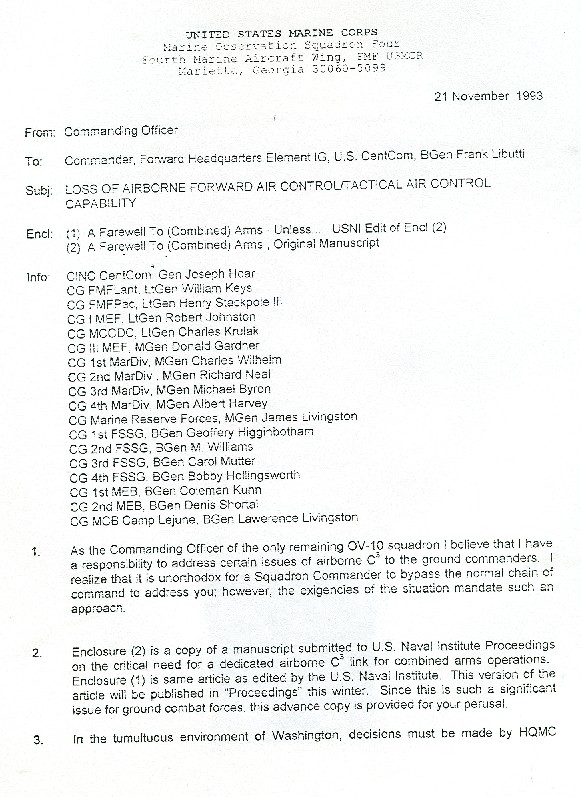
PLAIN TEXT
21 November 1993
From: Commanding Officer
Commander, Forward Headquarters Element IG, U.S. CentCom, BGen Frank Libutti
Subj: LOSS OF AIRBORNE FORWARD AIR CONTROL/TACTICAL AIR CONTROL CAPABILITY
Encl: (1) A Farewell To (Combined) Arms - Unless... USNI Edit of Encl (2)
(2) A Farwell To (Combined) Arms, Original Manuscript
Info:
CINC CentCom, Gen Joseph Hoar
CG FMFLant. LtGen William Keys
CG FMFPac, LtGen Henry Stackpole III
CG I MEF, LtGen Robert Johnston
CG MCCDC LtGen Charles Krulak
CG III MEF, MGen Donald Gardner
CG 1st MarDiv, MGen Charles Wilhelm
CG 2nd MarDiv, MGen Richard Neal
CG 3rd MarDiv, MGen Michael Byron
CG 4th MarDiv, MGen Albert Harvey
CG Marine Reserve Forces, MGen James Livingston
CG 1st FSSG, BGen Geoffery Higginbotham
CG 2nd FSSG, BGen M. Williams
CG 3rd FSSG, BGen Carol Mutter
CG 4th FSSG, BGen Bobby Hollingsworth
CG 1st MEB, BGen Coleman Kuhn
CG 2nd MEB, BGen Denis Shortal
CG MCB Camp Lejune, BGen Lawerence Livingston
1. As the Commanding Officer of the only remaining OV-10 squadron I believe that I have a responsibility to address certain issues of airborne C3 to the ground commanders. I realize that it is unorthodox for a Squadron Commander to bypass the normal chain of command to address you; however, the exigencies of the situation mandate such an approach.
2. Enclosure (2) is a copy of a manuscript submitted to U.S. Naval Institute Proceedings on the critical need for a dedicated airborne C3 link for combined arms operations.
Enclosure (1) is same article as edited by the U.S. Naval Institute. This version of the article will be published in "Proceedings" this winter. Since this is such a significant issue for ground combat forces, this advance copy is provided for your perusal.
3. In the tumultuous environment of Washington, decisions must be made by HQMC
Page 1
without the benefit of adequate time to thoroughly research the magnitude or extent of the ramifications of these decisions. One such decision is the elimination of the Forward Air Control - Airborne (FAC(A)) and Tactical Air Control - Airborne (TAC(A)) system which has served the Marine Corps well for over 50 years. In its current form, the FAC(A)/TAC(A) system is comprised of the OV-10D aircraft, a specially trained pilot, and an Aerial Observer (AO). The AO is normally an officer with a combat arms MOS who has volunteered to undergo flight training and act as a critical C3 link between the command elements, maneuver elements, and supporting arms.
Undoubtedly, the purpose of this decision to eliminate the FAC(A)/TAC(A) system was to maximize combat power within the constrains of a decreasing budget and force structure. .Although the intent was only to eliminate the OV-10D platform and not the FAC(A)/TAC(A) mission, the net result is equivalent to eliminating the M-60/M-1 platforms with the intent of retaining the mission of the main battle tank.
4. I view with concern the manner in which I believe this decision was made. I acknowledge that my views and concerns are colored by a parochial interest; however, I ask that you consider the following issues.
a. Was your command consulted about the decision to eliminate the OV-10 from the inventory and its potential impact on your combat effectiveness?
b. Has an alternative to the OV-10Ds dedicated FAC(A)/TAC(A) capabilities been demonstrated to your satisfaction under realistic conditions?
5. The Marine Aviation community has little concern with the loss of the OV-10D and will take no action to preserve the FAC(A)/TAC(A) system. Marine ground combat forces are the principle beneficiaries of the OV-10D and who will bear the burden if it is eliminated.
Therefore, if your command is not satisfied that the evolving concepts of combined arms coordination have been adequately demonstrated and fielded, it is incumbent upon you to take rapid and decisive action. The last OV-10 squadron in the DoD, VMO-4, is scheduled to be decommissioned in March 1994. Once this squadron is gone, the platform, personnel, and corporate knowledge of airborne battlefield combined arms coordination will be lost to the Marine Corps for a generation. The question which must be addressed by Marine ground combat forces is not, can they survive without a dedicated FAC(A)/TAC(A) system, but how many marines may needlessly die because it wasn't important enough to save.
Page 2
"A Farewell to (combined) arms, unless..."
By Major D.H. Fisher, U.S. Marine Corps Reserve
OV-10 pic
Keeping Marine Observation Squadron (VMO)-4's new OV-10Ds-here over the expeditionary airfield at Twenty-Nine Palms, California-alive and well in the reserves would be a very smart thing to do. It's not too late.
______________________________________________________________________________
During Operation Desert Storm, a single detachment of long-endurance OV-1ODs with integrated forward-looking infrared systems, laser rangefinder-designators and trained air crews provided round-the-clock reconnaissance and served as indispensable communications links with all supporting arms agencies. The ground marines in Desert Storm loved the OV-10D, but the last Marine Corps squadron, Marine Observation Squadron (VMO)-4 in Atlanta, Georgia, is scheduled for decommissioning in March 1994, leaving our marine ground forces without that critical link in the combined arms system-which is not what it used to be, either.
Retaining a squadron of OV-10Ds in the reserves until a suitable replacement platform is fielded would be prudent.
Marines travel light and do not have the heavy artillery assets that support their Army brethren. Naval gunfire used to fill in the gaps, but the big naval guns that served the Corps so well in every major conflict since World War II have been silenced-victims of post-Cold War budget cutting. Most U.S. Navy ships now sport only a single 5-inch/54 caliber gun mount-and some have only a 76-mm mount; neither has the range or destructive power required. Shore-based and anti-ship cruise missiles may force our ships farther off shore, decreasing even more their limited range. Tomahawk and Harpoon missiles are essentially useless in the direct support of marine infantry.
Although there is much talk about new systems, there is no money in the current budget to develop, test, or buy any of them. Scratch naval gunfire from the combined arms team. Marine aviation must take up the slack. Rotary-wing marine air provides the ground commander with mobility, logistics support, and potent attack helicopters that can offer tremendous short-term punch for the ground commander. Their limited range and payload, how-
Page 74
ever, cannot replace the massive firepower of fixed-wing aircraft.
Neither can they replace smaller, slower, turboprop, fixed-wing aircraft with long on-station times, besides, their other very important missions would suffer. The answer is what we have-Marine Observation Squadrons, whose legacy of providing ground commanders with command and control, reconnaissance, plus artillery and naval gunfire support-is unequaled. The concept worked in the Korean War, in the Vietnam War. and again in Operation Desert Storm: the need for a dedicated observation aircraft is clear, as are its characteristics, including the ability to operate from unimproved air strips and roads.
All Marine Corps OV-10Ds have been updated with FLIR systems to provide day and night video imagery to the ground commander: advanced solid-state, multi-band VHF/AM, VHF/FM, UHF, and HF radios; and effective countermeasures to protect against infrared (lR)-guided surface-to-air missiles. Most important, the OV-10D pilot and Supporting Arms Coordinator (Airborne) team's primary mission in life is to support marine infantry by providing a dedicated, flexible link between all elements of the combined arms team. Unfortunately. the Marine Corps has chosen to cast this aside in the name of economy.
The two-seat F/A-18D, touted as the OV-10D's replacement, is inappropriate for the mission for various reasons. In fact, it offers everything you do not want in a FAC(A) platform: high speed (try picking out a six-digit grid on a target at 420 knots at 5 G's-just unfolding the 1:50,000 map is tough enough); short endurance (even if a tanker is always available, the F/A-18D must frequently leave the area for 20-30 minutes to refuel); large geographical separation of the aircraft and crew from the ground forces: and a part-time approach to supporting arms coordination (which probably does not rank in the top five training priorities for F/A-18D air crews).
The AH-1W has also been suggested as a replacement and although it resolves many of the F/A-18D's inherent problems from the problem of task saturation and short endurance. Given limited flight time and training opportunities. The AH-1 community cannot be expected to add new missions and retain a reasonable degree of proficiency in the plethora of missions already assigned. The AH-1W also lacks the OV-10D's FLIR and laser designator and there just are not enough attack helicopters to go around.
The OV-10's survivability on the battlefield has been questioned. Granted, it is slower than the F/A-18 and cannot hover in defilade like a Cobra, but its IR-suppression 'system, IR jammer, and decoy flares controlled by a missile-launch detector provide it with an unmatched capability to survive against IR-guided missiles. (The two OV-1Os lost in Desert Storm were OV-1OAs without IR suppressors or advanced countermeasures.) In comparison, the F/A-18, with the largest infrared signature of any aircraft in the Marine Corps inventory lacks a missile-launch detector and an IR jammer-and the threat from IR missiles is increasing.
Remotely piloted vehicles (RPVs) have their place above the battlefield, but they currently offer no direct link between the ground commander and the RPV control site and their field of view is very limited. As a result, ground commander cannot get an overall picture of the battlefield.
Augmenting VMO-4 reserve flight crews with a limited number of active-duty personnel would ensure continued support for ground forces and preserve the highly perishable skills of the pilots and SAC (A)s. When a suitable replacement platform is obtained, possibly an AH-1W or a smaller V-22., such as the XV-15 modified specifically for the SAC role, the reserve squadron can train the new active-duty air crews.
Some argue that the Marine Corps cannot afford to maintain a small number of special-mission OV-10Ds; Marine Corps ground forces must decide quickly if they can afford not to.
___________________________________________________________________________
Major Fisher, a Supporting Arms Coordinator (Airborne) with VMO-4, is a survivability engineer with Lockheed Aeronautical Systems Company. He was an Electronic Countermeasures Officer with YMAQ-2 while on active duty from 1977 to 1984.
Page 75
Professional Notes
Death of a Squadron
___________________________________________________________________
By Captain Mark P. Stolzenberg. U.S. Marine Corps Reserve
The OV-10s and the crews that flew them are all but gone, and this is not a plea to retain them. It is rather some observations on a series of personnel decisions made during the 1980s in the Marine Observation Squadron.(VMO) community that led to the loss of the only Marine Corps aviation asset whose sole purpose was to be the eyes of the ground commander.
Almost all of the decisions were reactions to breaches of flight discipline and accidents that resulted from failures in flight leadership-and leadership in a flying squadron relates directly to the tactical proficiency of the flight leaders. If an officer cannot hack it, rank will not save him. Failure to recognize this fundamental concept was-and is-epidemic in the VMO community.
Several of the accidents involved personnel previously identified as marginal-to-incompetent aviators. Leadership moral courage-could have prevented these accidents.
Several institutional factors contributed to the problems, which began in the early 1980s. The biggest was the lack of an OV-10 Fleet Replacement Squadron which left it to the two active Fleet Marine Force (FMF) squadrons to train replacement aircrews. Inevitably, the ever present and higher-priority operational commitments took precedence over training, which was stretched out to the point that some aviators required 11-13 months to complete the 15 flight hours and 10 or so syllabus sorties to qualify in accordance with Naval Air Training and Operational Procedures standards. Becoming proficient enough to make a real contribution to the squadron's mission was pipe dream for many.
Training was so backlogged at one point that VMO-1 had 23 replacement aircrews-but not enough qualified pilots to support of simultaneous detachments.
Nevertheless, the community maintained its reputation for tactical proficiency. Aviators who persevered and qualified as Forward Air Controller (Airborne) and Tactical Air Coordinator (Airborne) were good at their jobs. Unfortunately, when their leadership potential
Page 72
was neither fostered nor nurtured, they began leaving the service. Their resignations, attributable at least in part to actions by short-sighted, unimaginative superiors. were the first trickles in the flood that swept the squadrons away.
One attempt was made to alleviate the replacement aircrew problem in the short term. Some first-tour aviators, with two to two-and-one-half years on station were allowed to return to the Naval Air Training Command for duty as instructors. These aviators, with approximately 300 flight hours of fleet experience, by and large did not enhance the image of the observation community. The successful ones transferred to the Navy; others who were not augmented into the regular Marine Corps left the service. The performance of this group of aviators can only be described as disappointing. Moreover, the leadership potential of the successful ones was never developed in the community, because none of the group returned for a second tour in Broncos.
But there was more to the problem than just too many replacement aircrews-their ability in many cases was suspect. OV-10s were a dumping ground for those who finished at the bottom of the advanced jet training command and the combination of weak first-tour aviators, scarce flight time, and drawn-out training cycles set up squadrons for the initial wave of aircraft mishaps and deaths.
The pilots were only part of the equation, though. Aerial Observers (AOs) drawn from the infantry and the artillery were crucial to mission success; they were the strength of the squadrons. The ground combat-arms experience they brought to the squadrons was an immense advantage on the battlefield, and the aviation knowledge they took back to their units when they left the squadron was the best advertisement that Marine aviation could hope for.
Their two-year "Swing with the Wing" tour was time very well spent. Although it counted as a "B" billet, the AO could stay in the Fleet Marine Force, fly the Bronco, and deploy everywhere. Most important. he learned and practiced every facet of supporting arms coordination.
This sounds great, but there was a catch: it was a one-time tour. After two productive years. the fully trained AO left the community-never to return if he wanted to stay competitive for promotion. The squadrons constantly lost 50% of the pilot-AO team; as individual AOs developed the credibility to provide the flight leadership that was so desperate]y needed. they left.
Field-grade AOs posed a different and significant-problem. First, a field grade, ground-combat-arms officer doinq a flying tour with the wing is suspect, by definition. As the career counselors continually expound, he should have been serving in his primary specialty, developing that all-important "credibility-". Then the issue of individual tactical proficiency reared its head. As commissioned AOs got only one flying tour, most field grade AOs had completed their academic AO training years before being assigned to a squadron. They were out of date, and as a group, they proved that you cannot teach an old dog new tricks.
But they were majors and became department heads: another recipe for disaster was approaching the boiling point. Many of them who should have providing the leadership for the squadron instead, time and again, in every clime and place, demonstrated their tactical incompetence-and leadership in a flying squadron is based on tactical proficiency.
The results were predictable. First, the field-grade AO, or pilot for that matter. because of his marginal tactical proficiency, did not provide flight leadership. Second, as a department head, he denied someone else the opportunity to fill the position and develop as a leader. Incredible frustration set in on the part of tactically proficient aviators who had been in the squadron three and four years; directed to train the senior personnel they, ended up stagnating behind them.
Officers who rose above mediocrity were routinely stifled by their seniors. Displays of leadership and tactical excellence by a junior aviator were perceived and treated as a threat. Many of the young OV-10 pilots resigned after
Proceedings, January 1994
Page 72
years of frustration.
While marines do not desert their post under fire, it is unfortunately true that the only legitimate protest an Officer can make in some cases is to resign. Many promising Officers did just that.
Recent promotion boards have deep-six the few pilots who persevered. How tactically proficient captains, who hold OV-10 qualification possible, can be passed over for promotion, can be understood only in light of the conditions prevailing at the time. Worse, no OV-10 pilot with back-to-back FMF tours has been promoted to Major recently. If Officers of skill and experience and not promoted, where is the leadership to come from?
All this brings us to the summer of 1985, when a Bronco and its crew were lost in an aircraft mishap. One of the corrections actions taken to prevent recurrences, was to increase the number of field-grade officers in the squadrons to provide leadership and instill flight discipline. In practice, the policy opened the OV-10 community to second-tour pilots transitioning from helicopters, and the old Bronco
OV-10 pic
Just flying the aircraft is not hard but flying it at low altitude, turning hard to stay close to the action, monitoring several radios, and sorting out a confused battlefield complicates things considerably.
________________________________________________________________________________
nemesis-its reputation as a marginal aviator dumping ground-surfaced again, In a purely unscientific, undocumented, biased opinion, roughly 25% of all pilots transitioning since 1986 have been successful. Some came to OV-10s to get fixed-wing, multi-engine turbine flight lime to make them more attractive to the airlines; some came to run away from their old communities. The successful ones came to be OV-10 pilots.
While flying the OV-10 is relatively simple, developing the tactical proficiency required to make the air-ground system work can take a lot of time. Unfortunately, many of the transition pilots had difficulty just flying the airplane. Unlearning helicopter habit patterns was a tough nut to crack. And while experience in one aircraft would seem to make it easier to develop leadership in another aircraft, this most emphatically has not been the case in the Bronco community, especially with respect to field-grade officers of whom much is expected, spatial disorientation was commonplace. Transport helicopters rarely engage in violent maneuvering in all three dimensions, Inverted flight is not something that helicopters do well or often, yet this is precisely the OV-10's regime: hard maneuvering in all dimensions, slice turns, and inverted flight. Staying ahead of the airplane while spatially disoriented is almost impossible, for many of the transition pilots this proved too much, once the transition pilot was in the community, however, he stayed. All of the problems of the tactically incompetent field-grade AO came with the tactically incompetent field-grade transition pilots.
One attempt to develop leadership from within and to foster continuity was made: the Supporting Arms Coordinator (Airborne) [SAC(A)] program was initiated to train proved, FMF-experienced AOs as naval flight officers, with a few exceptions this program has worked well. But even the exceptions proved a significant drain on the rapidly diminishing energy reserves of the community.
The marines who made the high-level personnel decisions no doubt had the best of intentions. The marines who made decisions that kept known incompetent aviators in cockpits or sent infantry lieutenants who would not make captain over to the AOs, or decided that marginal helicopter aircraft commanders could be someone else's problems were not being malicious. They were trying to give a good deal to a good guy. Besides, they probably rationalized that it wouldn't hurt anyone.
In any event, the VMO community throughout the 1980s was a magnet for marginally effective officers. The concentration of such mediocrity in one small aviation community represents an institutional failure of leadership, laid squarely at the feet of the Marine Corps.
The individual errors and failures of leadership are heartbreaking-they have contributed to 16 deaths and 25 aircraft losses. What is inexcusable is that many of the victims had been identified to the command as accidents waiting to happen.
The losses occurred in peace and in war and we were fortunate that more were not lost during Operation Desert Storm. The U.S. Marine Corps, and the OV-10 community in particular, allowed this to happen. It was a betrayal of trust.
_______________________________
Captain Stolzenberg, an OV-10 pilot and 1981 Naval Academy graduate, served as a Weapons and Tactics Instructor and Aviation Safety Officer with Marine Observation Squadron (VMO-1) while on active duty. An honor graduate of Amphibious Warfare School, he flew 18 missions in OV-10s during Operation Desert Storm. He resigned from the Marine Corps in 1992 and is an associate engineer with RWD Technologies in Houston, Texas.
Page 73
_______________________________________________________________________
Subj: RE: OV-10 and DAS
Date: 8/21/00 9:21:53 AM Eastern Daylight Time.
From: xxxxxxxxxxxxxx
To:
I didn't know Stolzenberg. We used the OV-10 primarily as a C3 platform rather than a light CAS platform.
The USMC uses AH-1 Cobras for CIFS (Close In Fire Support) which works well if they can set down in a relatively safe attack position and wait (engines running) for a call. The biggest problem with this tactic is that the position which provide a degree of safety to the Cobras, usually places them out of communications with the ground forces, so without an airborne relay, they are difficult to use. When it works, the ground forces have a highly mobile, quick response "punch." Not the heavy punch of the fixed wing attackers, but often enough to break through a blocking force, or impede the leading elements of an attacking force.
CAS often gets blended with BAI which leads to confusion on missions and positions. The USMC view of CAS is support of troops in contact, hence, the C3 platform will generally be close to their own forces, not deep in the enemy rear where the air defenses are dense. Much of the C3 mission can be performed with quick dashes over the line. We used the OV-10 to Iocate and/or mark targets and then coordinate their means of destruction with other assets such as artillery, CIFS, or fixed-wing attack aircraft. We would typically loft a WP rocket from low altitude to mark the target. We didn't need to hit the target, just put a reference point on the ground that 9 attack aircraft could easily pick out and then talk their eyes on to the target from the mark. (from the smoke, 1000 meters SW in the ravine...)
The ability of a DAS C3 platform to survive on the modem battlefield is a function of both tactics and platform. The platform should be able to utilize terrain (where available) and have IR countermeasures that are overmatched to its signature (i.e. high J/S). It should have adequate RWR capabilities to warn it of a radar threat for those environments that require operation at higher altitudes. Good tactics and training and countermeasures combined will be able to adapt to and overcome advances in air defense.
My personal opinion is that the ideal arrangement would be to have an OV-10 type platform (BA-609?) [EDITOR: tilt-rotor o/a plane] that had the capability to control a UA V for high threat environments. The C3 platform could provide the overall situational awareness (SA) and remain in a relatively safe position while directing the UA V to take a closer look at specific areas of interest. By controlling the UAV from an airborne platform that could (usually) observe the UAV, the loss of SA that comes from viewing the world through the soda straw of the UAV sensors is eliminated. The airborne C3 platform would know exactly where hey needed a closer look, and could immediately interpret the results into militarily significant actions without having to pass the information through the intelligence chain.
Our recently lost CAS capabilities were built around a relatively robust and long endurance observation platform (OV-10) and a very robust and long endurance bomber (A-6). Having lost both the capability to observe, coordinate and mark targets and the ability to have a bomber with a significant payload waiting for a target, we are in a deep hole. The F-18 must stay tethered to scarce tanker assets or it must have preplanned
__________________________________________________________________________
Tuesday. August 22, 2000 America Online: CMyersAERO
Page 1
targets, it simply wasn't designed to loiter for any significant time. My experiences at 29 Palms were that we often could not work up a 9 line brief coordinate with the ground forces before the F-18s had to return to tanker. Below is a comment from an F-18 pilot at a recent exercise.
Over and over it was reinforced how cumbersome CAS is without the OV-10. For example, on my last hop, I logged a 3 2. (which was fine with me) our F/A-18 section by itself took half the tankers fuel to give, right over the target, took several nine lines, and NEVER dropped a bomb!.
_______________________________________________________________________
Subj: RE: Dedicated Air Support for Ground Maneuver Forces
Date. 3:15/006:14:36 PM Eastern Daylight Time
From: xxxxxxxxxxxxxxxxxxxx
To:
I don't believe I have any formal history on the elimination of the OV-10. On the USMC side, I believe that it involves a great deal of politics and budgetary battles and very little if any honest assessment of requirements vs. capabilities. I have taken the liberty of forwarding your message to some knowledgeable USMC officers that may provide you with some greater insight on this issue.
As far as what the grunts want/need, a few comments.
The terms dedicated and overwatch plead for a system with long times on station (limited more by the crew than the platform) and a system that works from forward bases (helo bases?) rather than main operating bases far to the rear. The closer you live to the grunts, the better you can work with them.
I became a believer in this at 29 Palms.. We hated being out in the desert and had all sorts of rationalizations for why we could do the job just as well from Yuma (or anyplace with air conditioning. But when your airfield is close enough to hear the artillery, and you can meet face-to-face with the ground commanders, you really do develop a much better understanding of what is going on. Relationships are developed through daily contact that allow the DAS crews to anticipate requirements and be prepared to react to them more quickly.
Because the OV-1Cs had a dedicated mission, we were up in the same areas every day and became very familiar with the terrain and the deployment of forces. We knew where our artillery batteries were and could see them when they were on the move (even when the FSCC was unaware). Although we were relatively low flyers, our communications was infinitely better than the ground units and we could talk to everyone and often spent a great deal of time simply relaying (and filtering) information. Because we were there ever/day, we learned quickly which units could respond quickly and which ones needed more time. The message drop door was sometimes handy when a unit couldn't be contacted by radio - we could drop a message to them asking them to come up on a particular frequency or make a particular signal if they had lost all comm capability. (Usually they were just on the wrong frequency for that day).
There were times when the pilot alone could handle all of the workload, and in general, the pilots were better at controlling aircraft. However, with 3-4 radios operating at once, even a 2-man crew could quickly become saturated in some missions. My squadron commander, Col. XXXXXXX, often explained the OV-10 mission as a mini-ABCCC or C3I platform. With our high technology database system (2 human minds and grease pencils to write on the canopy), we were able to keep track of multiple CAS aircraft. tankers, friendly locations. target locations and artillery positions and availability. All this information was available to be applied in support of the grunts on the ground or to fill in information gaps for upper echelon commanders.
Communications is one of the keys - it is not enough to put repeaters in LAVs or on mountain tops since much of the comm traffic is across various nets. Often a particular unit can't be reached on one net, but in the air,
___________________________________________________________________________
Thursday August 17, 2000 America Online CMyersAERO
we can hear them on another net and relay the critical traffic. It seems that whenever a unit passes the line of departure, communications with their associated ground units immediately becomes unreliable. With fewer, more mobile forces, this becomes even more of an issue. Until we make some breakthroughs in SATCOM technology, there will always be hills and buildings in the way or ground-to-ground communications.
The USMC approach to C3I in the days of the OV-10 was to give final authority to the FAC (Ground or Airborne). If the ground FAC could not observe the target adequately, or was indisposed, the airbome FAC in the OV-10 had carte blanche to authorize weapons release or artillery fire. The burden to avoid fratricide and/or collateral damage rested solely on the FAC. Since the OV-10 usually had both the best view of the battlespace and an excellent knowledge of the terrain and unit locations, this was not considered a problem. In our almost paranoid, zero-defect mentality of today's military this may require some time to regain acceptance.
Nostalgic OV-10 Veterans Web Sites (in denial about USMC back-stab)
OA-37B "Dragonfly": Vietnam, Panama
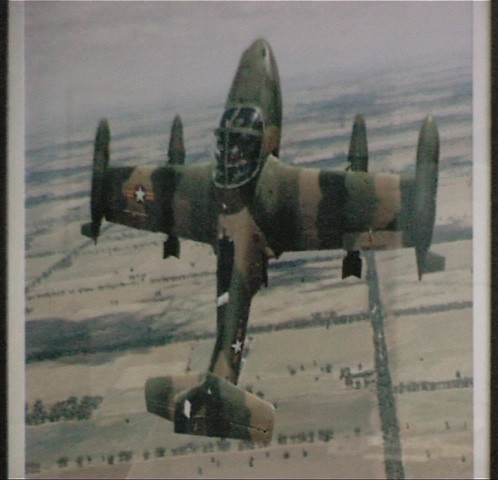
A-37B with special sky-blue camouflage
A-37B note special sky-blue camouflage
A-37B sky-blue camouflage effective
A-10 Thunderbolt II (Warthog): Desert Storm, Bosnia, Kosovo

Two Seat OA-10Bs with AFAC/GFACs in back; SeaHogs to give NAVAIR a High/Low Aircraft Mix
A-10 firing Maverick air-ground missile painting
A-10 gun run on tanks animation
Rutan's ARES

Charles Myers' Vintage Maneuver Air Support (MAS) doctrine
Bring back the Army/AF "Cactus Air Force"!
Close-up of ARES 25mm Gatling gun
ARES 2-seat attack/trainer version
Predator Armed UAV = UCAS?
USAF Predator UAVs at the behest of General Jumper have been armed with U.S. Army Hellfire laser-guided missiles and are being used in combat now in Afghanistan. Imagine what a Rutan ARES based U/MCAS platform could accomplish with larger bomb loads and higher speeds...what the cheerleading article doesn't point out is the 50% UAV crash rate of the Predators making us go broke...we need men in the cockpit with a survival interest to bring planes back or we are going to lose wars by inadequate "soda straw" vision and self-destruction in unmanned crashes.
TESTS
Photos: www.checkpoint-online.ch/CheckPoint/J4/J4-0003-PredatorHellfireMissileTests.html
Predator Hellfire Missile Tests "Totally Successful"
May 12, 2001
The Air Force's Predator Unmanned Aerial Vehicle made aerospace history Feb. 21 as it successfully launched a live Hellfire missile helping it evolve from a non-lethal, reconnaissance asset to an armed, highly accurate tank killer. "Capping a three-part series of demonstration flight tests, Predator successfully aimed and launched a 'live' Hellfire-C, laser-guided missile that struck an unmanned, stationary Army tank on the ground at Indian Springs Air Force Auxiliary Airfield near Nellis Air Force Base, Nev.," said Major Ray Pry, Predator program manager, Big Safari Program Office at ASC's Reconnaissance Aircraft System Program Office.
"... About seventeen seconds later, the missile impacted the side of the tank, hit the turret dead-square in the middle, and spun it partially around. "
"... About seventeen seconds later, the missile impacted the side of the tank, hit the turret dead-square in the middle, and spun it partially around. "
"Flown" by two Air Combat Command enlisted crew-members, a pilot and sensor-operator from the 53rd Test and Evaluation Group at Nellis, located in a nearby Ground Control Station, Predator launched the missile using Line-of-Sight communication, inflicting heavy damage to the tank, Pry said. The final flight, part of a Phase I feasibility demonstration that began in August 2000, was preceded by two similar, completely successful Hellfire launches Feb. 16 and earlier Feb. 21, according to the major. This first recorded missile launch from a UAV took place Feb. 16 at approximately 11:05 a.m. Pacific Daylight Time (PDT).
"Equipped with a single, inert Hellfire-C missile, the Predator, using its LOS communication band and infrared 'Kosovo' laser-ball, aimed and struck the tank-turret about six inches to the right of dead-center, spinning the turret around about 30 degrees," Pry said. "It made a big, gray dent in the turret - just beautiful."
To find a target and eliminate it Following the first launch, the Predator-Hellfire launch team reviewed telemetry data and camera footage captured by the GCS crew and a helicopter from the Nellis Range, Pry said. "We wanted to be sure we captured what we thought we had seen - that the stress and loads were within Predator's limits, and that the guides worked perfectly," he explained. "With two shots planned for Feb. 21 using both satellite and LOS communications links, we wanted to ensure we could use the satellite link to fire the missile."
Assembling at 4:30 a.m. local Nellis time, the team flew the Predator for 10 to 15 practice runs, doing simulated missile set-ups and launches, Pry said. "At approximately 9:30 a.m., the conditions were favorable for a live run, and the 53rd Test and Evaluation Group operators were ready," he said. "We executed the launch using the satellite link for the first mission. This successful launch met a key goal of the first phase of the demonstration.
"We came in on final approach, about seven kilometers from the tank, turned the laser off just shy of five kilometers and launched the inert Hellfire," Pry said. "About seventeen seconds later, the missile impacted the side of the tank, hit the turret dead-square in the middle, and spun it partially around." Pry said test teams inspected the damage to the turret and reset all parameters to use the LOS communications link for the live missile shot next. After a whole series of run-ins, to make sure the entire team was "in sync," they went through another pass with the same exact mission profile as the previous launch, and loosed the live Hellfire. "The missile exploded as planned against the side of the tank," he said.
"... Gen. John P. Jumper tasked Air Force Acquisition to demonstrate a weaponized UAV with the ability to find a target, then eliminate it. "
"... Gen. John P. Jumper tasked Air Force Acquisition to demonstrate a weaponized UAV with the ability to find a target, then eliminate it. "
The weaponized Predator is the brainchild of Gen. John P. Jumper, top commander of the Air Force Air Combat Command. He tasked Air Force Acquisition to "demonstrate a weaponized UAV" with the ability to "find a target, then eliminate it."
The Hellfire missile was chosen to arm the UAV because of its proven track record from Desert Storm back to the 1980s, its availability as a mature missile with all platforms still in production today, its weight of approximately 100 pounds and its relative ease of integration, said Lt. Col. Dennis Bleckley, assistant project manager of production and international operations in the Aviation Rockets and Missiles project office.
Although the Army team was tasked with the project in July 2000, concerns that an armed UAV might violate the Intermediate-range Nuclear Forces treaty between the U.S. and the former Soviet Union stalled the project from September to January.
The challenge was to arm the Predator, a UAV that was designed for reconnaissance missions rather than combat, with Hellfire missiles designed to be fired at low altitudes from Army Apache and Marine Corps Cobra helicopters. "They were never married together before and they were never designed to be married together, so it was kind of a shotgun wedding," Scott Beck, chief of the technical management division in the ARM project office said.
The Army team had to consider several risks inherent in integrating the two systems including whether the Predator could carry the missile, whether the aircraft offered the necessary stability to launch the missile and whether the aircraft's onboard acquisition/designator system had sufficient stability to meet the missile's guidance requirements. All of this had to be done in a short timeframe.
Reducing sensor-to-shooter kill times under 10 minutes When that the initial weaponization feasibility tests have been successfully completed, ACC Commander Gen. John Jumper reviewed the results to determine when Phase II of the effort will begin, according to Lt. Col. Tom Carlson, director of ACC's Advanced Weapons Requirements Branch, in a Feb. 27 Air Force News article. "Phase II will take the Predator-Hellfire combination to more realistic, operational altitudes and conditions, including the challenge of a moving target," Carlson then explained. "This will complete the demonstration of the objectives we set down at the beginning of this process, to demo the technology, and prove its operational feasibility."
There are still some challenges ahead, the colonel said. "We need to do some re-engineering on the missile, to take it up to higher altitudes," he said. "Once we're given the 'green light' to proceed to Phase II - and all indications are that we will - it will require another symphony of players, brought together by Major Pry and his team, to execute the second round of demonstration flights. "The bottom line is that we are taking a Hellfire missile, normally launched from an Army helicopter with its landing-skids 'in the trees', or from the deck of a sea-borne Navy carrier, flying under 2,000 feet, and asking it to fly at higher altitudes," Carlson said. "The recent Predator launches were done within the normal operating elevations for Hellfire."
The missile used in phase one, the AGM-114C, has an analog guidance and control system. A different missile, the AGM-114K (Hellfire II missile), was used in phase two because it has a digital guidance and control system. Also, more missiles were fired in Phase Two at more operationally representative altitudes and engagement ranges and they will be fired at moving targets.
On Apr. 17, the Air Force successfully fired three Hellfire II anti-tank missiles from a Predator recon drone, striking three tanks on a target range.
"... a weaponized Predator would be able to kill time-critical targets more swiftly and would avoid the trouble of diverting other strike aircraft. "
"... a weaponized Predator would be able to kill time-critical targets more swiftly and would avoid the trouble of diverting other strike aircraft. "
The weaponization of the Predator UAV is a priority of Air Combat Command chief Gen. John Jumper. Jumper has been particularly vocal about his goal of reducing sensor-to-shooter kill times to under ten minutes; mobile targets were particularly elusive and troublesome to the Air Force during Operation Allied Force. Equipping Predator with its own weapon could help the service meet that goal.
Sources say one challenge during Operation Allied Force involved assigning a strike package to time-critical targets identified and confirmed via Predator's digital TV camera. Too often, the target would elude a strike package before it could strike. However, sources say, a weaponized Predator would be able to kill time-critical targets more swiftly and would avoid the trouble of diverting other strike aircraft.
Air Force Chief of Staff Gen. Michael Ryan also supports the move and roughly $1.5 million in fiscal years 2000 and 2001 was set aside to fund the effort. Predator is also useful as a strike asset because of its low cost relative to other combat systems, Air Force sources say. A production-model Predator is valued at approximately $3.8 million, they added.
Air Force officials consider Predator an "attritable" asset because of its low cost; service officials say the loss of seven Predators per year is acceptable. [Editor what happens when you lose 48 x UAVs like we did in Kosovo? Where is your recon going to come from?] Several recent crashes have vexed program officials, however. In the most recent crash, an Air Force Materiel Command Predator and its equipment, valued at about $2.8 million, was lost.
Text sources: "State Department Finds No Treaty Implications In UAV Weaponization", Inside The Air Force, January 5, 2001; Sue Baker, "Predator missile launch test totally successful", Aeronautical Systems Center Public Affairs, February 27, 2001; Beth Skarupa, "Air Force Predator goes on the prowl with Army Hellfire", Redstone Arsenal Public Affairs, 4 April, 2001 (rewriting: Cpt Ludovic Monnerat)
Gunships
AC-47 "Puff the Magic Dragon": Vietnam
The "Dakota" or "Sky Train" is probably the greatest aircraft to ever fly, period. In Vietnam it was turned into a gunship best depicted in the film, The Green Berets where "Puff" is called in to wipe out the enemy that over-ran the SF camp.
Another attribute is that the C-47 is able to land on grassy fields (Short Take-Off and Landing-STOL) capability.
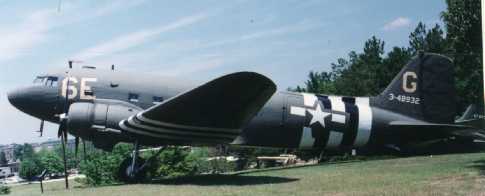
AC-119G/K "Shadow", "Stinger": Vietnam
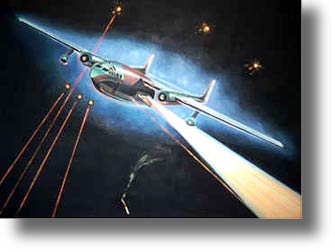
AC-130A/U "Spectre" and "Spooky": Vietnam, Grenada, Panama, Desert Storm, Somalia
AC-17 "Spectre III": 80 tons of gunship weaponry?
The entire gunship concept is in question after an AC-130H got shot down after it stayed on-station into the daylight hours defending surround marines trapped at Khafji. Clearly what we need is to overhaul the gunship and have it KILL the threat not just hope to evade it by moving to higher and higher altitudes and farther and farther away stand-offs; the ultimate expression of this the unmanned aircraft. If we want to win wars and control the ground we live on, we need to be able to wrest control of the air space over this ground an inhabit it in person. A faster AC-17 gunship with 80 tons of payload capacity to work with would yield enough firepower to do this to clear drop, landing and assault zones for Air-Mech-Strike forces to land. Proposed AC-17 Spectre III
ROTARY-WING GUNSHIPS
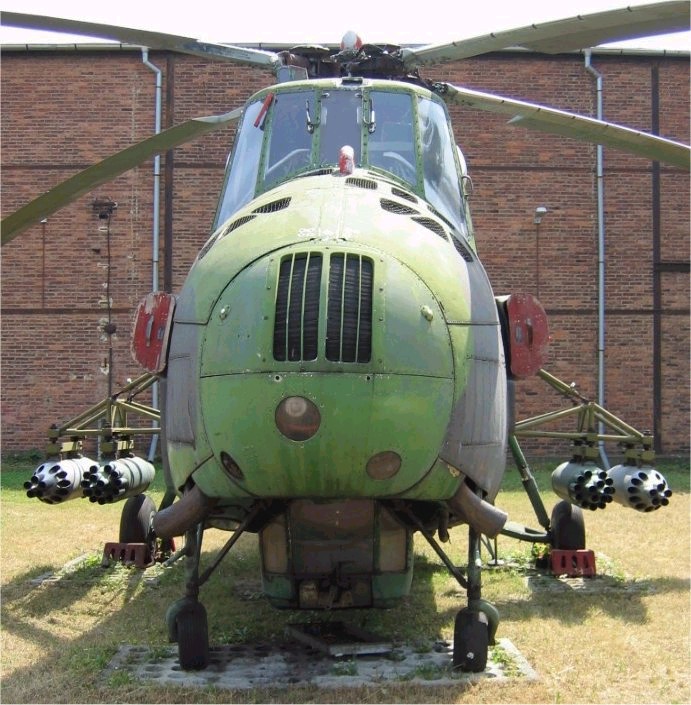
The Russians were pioneers by arming their Mi-4s with rocket pods...
Helicopter Air Assault Tactics web page:
The first formal military requirement for an aerial weapon for U.S. Army helicopters was initiated during this same period at Fort Benning and, subsequently, approved through the chains of command by Department of the Army. The requirement specified a lightweight, simple, flexible turret gun to be provided for all Army transport helicopters. Tactical experiments had proven the obvious requirement for some type of suppressive gunfire to be delivered by transport helicopters during the critical approach phase of a combat assault. Unfortunately, the light turret gun was never developed as conceived, but the Ordnance Corps latched onto the requirement as the justification of expenditures in the initial development of helicopter armament.
During this same time frame, a small group of pioneers, with the blessing and backing of Brigadier General Carl I. Hutton, Commandant of the Aviation School at Fort Rucker, Alabama, were making the first crude experiments with armed helicopters. Scrounging discarded hardware from the other services' junkyards, they improvised various combinations of machine guns and rockets in the face of ridicule and outright opposition. At the same time they began to develop tactics and techniques which they felt would prove useful when the technology of helicopter armament caught up to the theory.
The guiding genius for much of this development was a colorful officer, Colonel Jay D. Vanderpool. Colonel Vanderpool was Chief of the U. S. Army Aviation School's Combat Development Office, which was under the direct supervision of the Assistant Commandant. This arrangement was fortuitous since we could make all the assets of the School available to his project if required. In June 1956, with two officers, two enlisted men, and unbounded enthusiasm, Colonel Vanderpool went to work without a charter, without money and, by explicit direction, without publicity.
With borrowed personnel from the Department of Tactics, Colonel Vanderpool formed a "Sky-Cav" platoon which became notorious for its hair-raising demonstrations of aerial reconnaissance-by-fire. By mid-1957 this provisional unit, redesignated Aerial Combat Reconnaissance Platoon, had somehow acquired two H-21's, one H-25, and one H-19 armed with a wondrous variety of unlikely weapons. Colonel Vanderpool and his "hoods" were to see their efforts officially recognized when the Aerial Combat Reconnaissance Platoon became the nucleus of the 7292d Aerial Combat Reconnaissance Company (Provisional) with an approved Table of Distribution sanctioned by the Department of the Army on 25 March 1958. In subsequent work, Colonel Vanderpool and his group developed, on paper, organizations for an "Armair" Troop, Squadron, and Brigade. As the Assistant Commandant of the Army Aviation School, I was present when Colonel Vanderpool gave a briefing to Major General Hamilton H. Howze, the first Director of Army Aviation, on the organization of an "Armair Division."
NEW VIDEOS! Sioux scout helicopters in action as "Killer Bees" (second half of video)
2 x 7.62mm x 82mm (.30 caliber) Browning Medium Machine Guns above the skids; best depicted in the 1967 007 Jame Bond film, "You only live twice"
S-55 (H-19)
The French were the first to arm helicopters in Algeria in the late 1950s in their successful counter-insurgency operation. Best depiction is the brilliant film, "The Lost Command" where Colonel Raspeguy uses a S-55 to 3D outflank the rebels in the climactic battle ending. This inspired the U.S. Army Armair enthusiasts to take the concept even further...
H-21
Was armed with rockets/machine guns, but under-powered.
S-58 (UH-34)
Armed with guns, rockets and recoilless rifles by the French. U.S. service usually only a bungee-corded 7.62mm door gunner; best depicted in film, "Full Metal Jacket"
UH-1 "Huey": first U.S. turbine-engined helicopter
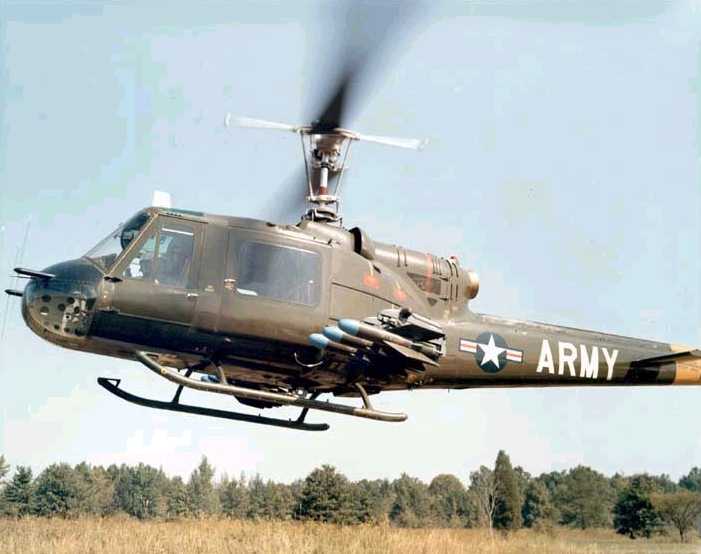
The Huey could mount rockets for the "Aerial Rocket Artillery" concept used by Army Air Assault units in Vietnam, as well as guns. In the beginning, some officers considered Aerial Rocket Artillery (ARA) to be a nuisance on the battlefield, and they could not understand why its method of employment should be any different than the armed helicopter which escorted the tactical troop lift. Fortunately, the aggressive spirit of the aerial rocket artillery battery demonstrated that it could and should be used in mass. While the other armed helicopters were preoccupied by pinpoint targets, the aerial rocket artillery could deliver area fire with the same responsiveness (and through the same communication channels) that tube artillery had done in the past.
These same aerial rocket artillery assets, if distributed piecemeal throughout the division, could not have functioned nearly as well. In this case, the whole was greater than the sum of all its parts. Aerial rocket artillery never entirely replaced tube artillery, nor was it ever meant to. However, by careful allocation of fire and precise timing of ships on station, the aerial rocket artillery was able to provide a remarkable volume of fire at times when no other fire support was available. To their credit, the aerial rocket artillery developed the same combined-arms partnership with the infantryman that has always existed between the "red leg" and the dog Soldier. We should remember that ARA pilots and their helicopters belonged to Artillery Branch---when helicopters were platforms shared by every Army branch and not owned by a now aloof and separate "Aviation Branch".
To the infantryman who has never been in an airmobile division, it is a very difficult thing to explain the responsiveness and effectiveness of aerial rocket artillery. Aerial rocket artillery, in contrast to the roving gunship, generally stayed on the ground with one section having a two-minute alert time. They were positioned so to be only a matter of minutes away from any potential target. Two minutes after a fire mission was received they were airborne, and, in a matter of a few minutes more, on target. As soon as the first section departed, a second section moved from a five-minute alert to the two-minute alert status, and another standby team moved to the five-minute alert. By this method, continuous and accurate firepower could be delivered. Aerial rocket artillery was so effective in the 1st Cavalry Division that the artillery commanders had to constantly remind the Infantry to use tube artillery when appropriate rather than call automatically for aerial rocket artillery support.
Culmination of the armed Huey was the TOW ATGM equipped Hueys that knocked out NVA T-55 tanks in the 1972 invasion.
UH-1B Huey with quad M60 7.62mm MMGs
Initially, the fifteen UH-1A helicopters in Vietnam were armed with locally fabricated weapons systems consisting of two .30 caliber machine guns and sixteen 2.75-inch rockets. In November 1962 the unit was augmented with eleven UH-1B helicopters. The "B's" were equipped with factory installed weapons systems of four M60 7.62mm medium machine guns per aircraft and locally fabricated clusters of eight 2.75-inch rockets. The "B" model eventually replaced most of the less powerful 'A's."
The UH-1B was not designed for an armed configuration and the weight of the armament system reduced the maneuverability of the aircraft and induced sufficient drag to lower the maximum speed to approximately 80 knots. As a consequence, the armed helicopters could not overtake the airmobile force if they left the formation to attack targets enroute. The early armed UH-1B's did an outstanding job in proving the concept of the armed helicopters, but they also pointed out many deficiencies that the Army would correct in later versions.
The provisional Utility Tactical Transport Helicopter company was based at Tan Son Nhut Airport on the outskirts of Saigon and was under the direct operational control of Military Assistance Command, Vietnam. From this base, it supported transport operations of the 57th, 33d, and 93d Light Helicopter Companies, all equipped with CH-21 aircraft. In the latter part of the test period, one platoon of helicopters was sent to escort the marine H-34 squadron operating in I Corps.
The plan of test for this company called for the evaluation of the armed helicopter in the "escort" role. Although "escort" was not defined, actual experience determined that the escort role broke down into an enroute phase, that was generally flown at a relatively safe altitude, the approach phase, where the heliborne force usually descended to nap-of-the-earth heights several kilometers away from the landing zone, and the landing zone phase. It was in the landing zone phase that the armed helicopter proved most valuable.
Prior to the advent of the escort by the Utility Tactical Transport Helicopter company, transport helicopters on the "dangerous" combat support missions were being hit at a rate of .011 hits per flying hour. For similar missions escorted by the Utility Tactical Transport Helicopter company, the rate declined to .0074. During this same period of time, the hit rate for all other flying done by Army helicopters rose from .0011 to .0024. In other words, the Viet Cong effectiveness against unescorted aircraft doubled while the efficacy of their fire against escorted aircraft dropped by 25 percent. Consequently, it was concluded that the suppressive fires delivered by armed escort helicopters were highly effective in reducing the amount and accuracy of enemy fires placed on transport helicopters. The response of the transport helicopter pilots to this added protection was clearly enthusiastic. Even the skeptical marine pilots began to rely heavily on the Army armed helicopters.
UH-1D Huey with 2.75" rocket pods; best film depiction: "Apocalypse Now"
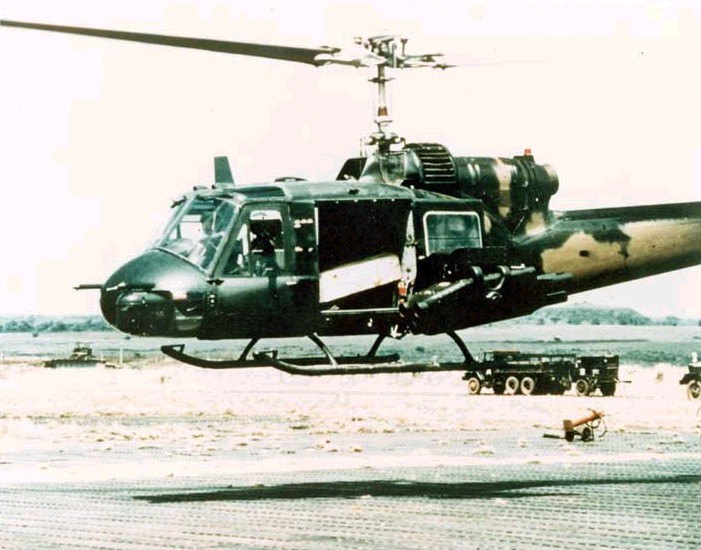
"By mid-1963 the 1st Platoon of the Utility Tactical Transport Helicopter Company which worked with the marine H-34's in the I Corps sector had become adopted by their comrades-in-arms as an integral part of their operations and few, if any, H-34 pilots elected to fly without the armed Hueys nearby. Procedures were developed whereby the armed Hueys picked up the fire support right after the fixed-wing fighter planes broke off their support for safety reasons, and that, in most cases, the last minute reconnaissance by the armed helicopters prevented the marine H-34 from going into extremely hot ambushed landing zones.
Ironically during this same period, I found myself as Director of Army Aviation testifying in front of Congressional committees on the role and absolute necessity of more and better armed helicopters. The Commandant of the marine corps and various Air Force officers gave negative testimony on the merits of this system. Fortunately, the Army viewpoint prevailed.

Beautiful painting of ACH-47s in action by Frank White
LTC Carle E. Dunn, USA-Ret. writes:
I, like my peers, appreciated the "Go-Go" ships. They were our best defensive weapons. The enemy dearly loved shooting at Hooks. The target was large, frequently carried many people and supplies, and lacked sufficient firepower for defense. When we moved to a new operational area, it seemed anyone that could hold a weapon shot at us. However, tuck a couple of ACH-47s in a flight, and the firing soon stopped.The Viet Cong had developed tremendous underground fortifications and tunnel systems throughout Binh Dinh Province. Many of these fortifications could withstand almost any explosion. Riot agents were introduced to drive the enemy from his tunnels and force him into the open. During Operation PERSHING the 1st Cavalry dropped a total of 29,600 pounds of these agents from CH-47 aircraft using a simple locally fabricated fusing system on a standard drum. Initially the drums were merely rolled out the back of the open door of the Chinook and the fusing system was armed by a static line which permitted the drum to arm after it was free of the aircraft. Using this method, a large concentration of tear gas could be placed on a suspected area with accuracy.From a distance, it was difficult for even Hook drivers to distinguish the "Go-Go" ship from the standard model. And, it became obvious that the enemy couldn't be either. It only took a couple of flights with two ACH-47s in our midst and the enemy soon learned. It was a joy to watch. Some jerk would be standing in the open firing. Suddenly, two of the birds broke formation and headed for the would-be hook-killer. The word spread fast -don't shoot at Hooks.
By the time "Guns-A-Go-Go" joined the 228th their operational procedures were deadly. There were tales that, when the unit first came to 'Nam, flight personnel thought they had an invulnerable, flying pillbox. However, they soon learned that teamwork was an absolute necessity for mission success. And their teamwork maximized their craft's ability to take down tough targets. An example related to me explains how.
One of the enemy's air-defense weapons was a radar controlled, quad .51 caliber weapon. The pilot explained that an indication of being radar tracked was a distinctive sound heard from their FM radio. A certain indication of target acquisition was blue-green tracers streaming skyward in their direction. One ACH-47 would take the attacking weapon under fire with 20-mm canons. This weapon out-gunned the .51 calibers in range and firepower. As the craft approached the Czech-made weapon's position, their explosive rounds tore into it while the .51 tracers fell short of the ACH-47. When within range, the aircraft fired its 2.75-inch rockets. Meanwhile, the other "Go-Go" had its 20-mm fire upon the target.
The lead ship's .50-caliber machine guns rained steel into the enemy's position. By this time, the other ship was firing rockets and the lead bird pummeled the position with 40-mm grenades and began its break left or right. The transom mounted .50-caliber brought fire on the target. The two ships worked this "daisy chain" attack procedure to perfection. No one would ever think that this effective firepower would lead to their demise. There are those who firmly believe that it did.
Conventional artillery was a typical fire support option. However, if not within range, the ARA brought their firepower to bear. One of "Charley's" basic tactics was to hold close to their enemy. This reduced fire support effectiveness because they were too close to friendly forces. The CPE of the 2.75-inch rocket immediately caused problems. Too many hit within friendly positions. Beleaguered ground units started calling for "Guns-A-Go-Go" by name.
The ACH-47's varied weapon complement proved excellent for attacking positions close to friendly units. The crews were most adept at placing heavy machine gun and 20-mm fires on target. Add to this the 40-mm grenades and the "Go-Go" teams could reserve their rockets for targets away from friendly positions. This proved an embarrassment to the ARA leaders and supporters of the ARA concept. The ACH-47 unit was in trouble.
Napalm was rigged and dropped in a similar manner during this same period. A single CH-47 could drop two and one-half tons of napalm on an enemy installation. Naturally, this method of dropping napalm was only used on specific targets where tactical air could not be effectively used.
Another version of the CH-47 which was unique to the 1st Cavalry Division was the so-called "Go-Go Bird." The "Go-Go Bird," as it was called by the Infantry, was a heavily armed Chinook which the 1st Cavalry Division was asked to test in combat. Three test models were received armed with twin 20mm Gatling guns, 40mm grenade launchers, and .50-caliber heavy machine guns, along with other assorted ordnance. Though anything but graceful, it had a tremendous morale effect on the friendly troops which constantly asked for its support.
From the infantryman's viewpoint, when the "Go-Go Bird" came, the enemy disappeared. The pilots who flew these test aircraft performed some incredibly heroic deeds to prove the worth of the machine. However, from the overall viewpoint of the Division, these special machines required an inordinate amount of support and, if we had kept them as part of our formal organization, we would have been required to give up three of our essential lift Chinooks. Army Concept Team in Vietnam monitored the tests of the "Go-Go Birds" and flew many of the missions. After two of the test vehicles were lost through attrition, the final armed Chinook was transferred to the 1st Aviation Brigade. Much debate would continue about the effectiveness and vulnerability of such a large armed helicopter, but the individual trooper who enjoyed its support would never forget it.
On 9 August 1967 the 2nd Battalion of the 8th Cavalry, under the command of Lieutenant Colonel John E. Stannard, commenced a battalion air assault into the valley 32 miles southwest of Quang Ngai City. The selected landing zone, named landing zone PAT, was situated on a ridgeline 2,300 meters southwest of an abandoned airstrip at Ta Ma. This landing zone selected because it was the only high ground large enough and clear enough of obstructions to allow six lift ships to land, and because it was in an area which would give an assaulting company the advantage of reconnoitering from high ground down to the valley floor. The assault started at 0936 after a short artillery preparation. After the 1st Platoon had landed, intense anti-aircraft fire came from the surrounding hills. Two Huey's were shot down almost immediately. Company A of the 2nd Battalion was faced with a pitched battle for the next four hours. The enemy situation, reconstructed later from information gained from prisoners of war, captured documents, and a survey of the battle area, disclosed that the chosen landing zone was right in the midst of well-prepared enemy positions. Looking down on the position were at least 80 North Vietnamese with three 12.7mm anti-aircraft weapons, 82mm mortars, and 57mm recoilless rifles. A Viet Cong Montagnard rifle company was on the same hill mass. The ridgeline was rimmed with fox holes and well-concealed bunkers almost flush with the ground. Company A had landed in a nest of hornets.
There were to be hundreds of acts of individual heroism in the next few hours which have been duly recorded elsewhere. The importance of landing zone PAT stems from the fact that Air Cavalry units were able to react with terrific firepower and extract their men from almost untenable. positions when necessary. The Aerial Rocket Artillery had fired 576 rockets in support of this action and two armed Chinook helicopters had delivered eight tons of ordnance on possible escape routes. Tactical Air had done a magnificent job of supporting the ground forces with a total of 42 sorties. What could have been a disaster turned out to be an effective assault, killing 73 enemy while only losing 11 friendly troops. Two major enemy units had been flushed out of hidden positions and a major anti-aircraft position had been destroyed.
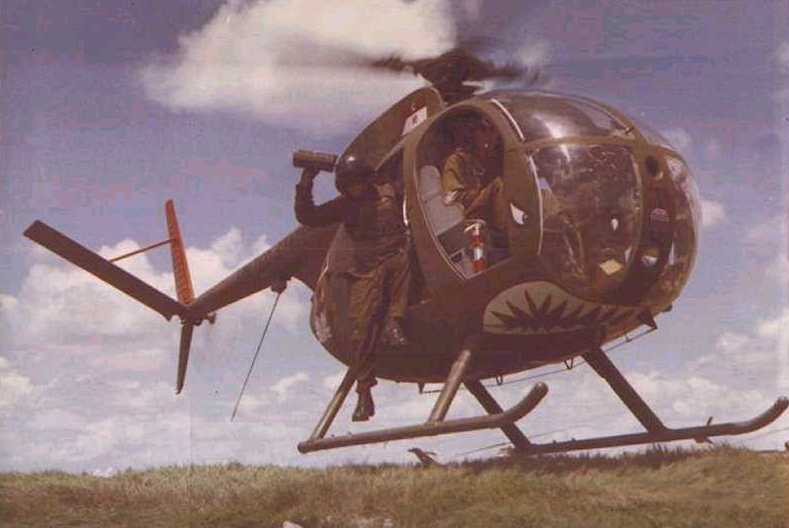
See the Little Bird in action as a "Killer Bee":
5.56mm Mini-Gun on OH-6A in Vietnam
Transported to the battle area INSIDE USAF fixed-wing transports. Can also carry 4 troopers on side benches.
OH-58D "Kiowa Warrior": Vietnam, Persian Gulf, Panama, Desert Storm, Afghanistan, Iraq
Unique Mast Mounted Sight (MMS) allows below tree-top suveillance/targeting; can be transported inside C-130s using folding tail, rotors and kneeling landing skid. Can transport 6 troops on external benches.
AH-60 "Blackhawk": battle-hardened successor to the Huey
Direct Action Penetrator (DAP)
AH-64 Apache
Attack Helicopter Tactics to include recent IDF combat
Tuesday, March 19, 2002 6:53 PM
Subject: Apaches
By Sean D. Naylor, Times staff writer
The Soldier's weather-beaten face was streaked with tears of gratitude. Just days earlier, separated from his buddies and pinned down by intense fire from al-Qaida Soldiers in the ridgelines around the Shah-e-Kot valley, he thought he was going to die.
Then, like fire-spitting avenging angels, Apache attack helicopters sliced through the thin mountain air pouring rocket and chain-gun fire on his would-be killers.
"We came in and took the fire away from him," said Capt. Bill Ryan, the commander of those Apaches. He said it matter-of-factly, as if there were nothing remarkable about piloting a helicopter through hails of bullets and rocket-propelled grenades to save a man's life.
Now safely back at Bagram Air Base, that soldier had come to thank h is deliverers.
As Operation Anaconda wound down, a string of well-wishers stopped by to pay homage to the dozen or so Apache pilots who had kept the al-Qaida troops at bay.
Not every visitor broke into tears. But all echoed the sentiments of Lt. Col. "Chip" Preysler, commander of 2nd Battalion, 187th Infantry Regiment. Preysler's battalion was one of two that flew into the teeth of entrenched al-Qaida positions March 2, the first day of the operation. Their very lives depended on Ryan's seven Apaches for close air support. When he came out of the battle nine days later, Preysler immediately sought out Ryan. With a smile on his face and his hands spread wide, he said, "You guys have huge balls."
The Apache exploits on the first day of the battle of Shah-e-Kot have done much to bolster the reputation of an aircraft that saw its battlefield role called into question after its role in Albania in 1999. In that bleak period in the helicopter's history, 24 Apaches were sent to Task Force Hawk for use in the war against Yugoslavia. But the choppers were held back from combat after two crashed and two pilots died during mission rehearsals.
The Apache community complained that ignorant journalists and casualty-averse Pentagon officials had unfairly turned their beloved killing machine into a scapegoat.
Now, three years later, the contrast could not be starker. The Apache drivers are being lauded as heroes, and their helicopter is receiving what to many pilots is praise long overdue.
With al-Qaida fighters so close to U.S. troops that close air support from "fast mover" jets was often out of the question, the Apaches became the only fire support available to ground commanders. [Editor's note: why we need Air-Mech-Strike GROUND tracked armored vehicles for fire support!]
In the crucial hours of that first day, when the carefully scripted battle plans had been rendered irrelevant and the outcome hung in the balance, Apaches saved the day.
"The weapon that changed the face of the battle for us was the Apache," said Col. Frank Wiercinski, commander of the 101st Airborne Division (Air Assault)'s 3rd Brigade and in charge of all conventional U.S. troops in the battle.
"I was just so impressed by its capability," he said. "I had never seen the Apache in combat before, though I've always trained with it. I am a firm believer right now that a brigade combat team commander needs his Apache battalion in an air assault division - its ability to protect us en route, its ability to set the conditions on the landing zones and then its close combat attack capability to take out fires.
"Artillery is a wonderful asset, but you need an observer, you need a sensor, and then you've got the artillery [tube] as the shooter. An Apache can do all of that, and it's always moving."
On station in the valley from dawn on the battle's first day, the Apaches flew again and again through withering small arms, heavy machine-gun and rocket-propelled grenade fire to provide fire support to the beleaguered infantry troops.
Five Apaches were present at the start of the battle, a sixth arrived Later that morning and a seventh flew up from Kandahar to join the fight that afternoon. None of the helicopters was shot down, but four were so badly damaged they were knocked out of the fight.
The fire the Apaches braved was so intense that when the day was over, 27 of the 28 rotor blades among the seven helicopters sported bullet holes, said Lt. Col. James M. Marye, the commander of the 7th Battalion, 101st Aviation Regiment. Marye's aviation task force included the Apaches of Ryan's A Company, 3rd Battalion, 101st Aviation.
Beneath the cold numbers are tales of heroism and extraordinary achievement. None are more dramatic than the story of Chief Warrant Officer 4 Jim Hardy.
At about 6:45 a.m., an RPG exploded under the nose of Hardy's Apache, sending shrapnel slicing through the helicopter's innards.
"I looked up and there was a black puff of smoke, like World War II flak," said Chief Warrant Officer 2 John Hamilton, who was flying nearby. "There was major damage to that aircraft," Ryan said. "They had lost the weapons systems and the target-acquisition systems."
Despite the fact that Hardy's Apache was now essentially unarmed, he stayed on station. He later told Hamilton that his plan was to fly up the valley and draw fire, allowing the other Apaches to engage enemy gunners once they had revealed themselves.
About 10 minutes after an RPG struck Hardy's aircraft, another hit the Apache piloted by Chief Warrant Officer 3 Keith Hurley, smashing into the left Hellfire missile launcher. "The RPG struck me on the left, rocked the aircraft, and a microsecond after that, a bullet came through the cockpit," Hurley said. By the end of the day there were 13 bullet holes in Hurley's aircraft. Lights immediately started flashing on Hurley's control panel, warning him that he was hemorrhaging oil. Hardy, one of the company's most experienced pilots, realized Hurley was in trouble, and got on the radio. As Hurley recalls it, Hardy told him, "I've got to go back to the [Forward Arming and Refueling Point], fall in trail and follow me, and we've got to go quick."
The two wounded Apaches headed for the FARP, a way station for the helicopters roughly halfway between the valley and their temporary base in Bagram, north of Kabul. They didn't make it very far. About a mile west of "the Whale," the humpbacked ridgeline that marked the western edge of the valley, more lights came on in Hurley's cockpit, including one that told him he had no fluid left in his transmission. "I called off the lights to Mr. Hardy and he said, 'You've got to land,you've got to land now,' " Hurley said. The two landed in a dried-up riverbed, within range of the al-Qaida positions. With bullets flying around him, Hardy, who Hurley described as "the unit maintenance god," shut the helicopters down and went to work on Hurley's aircraft.
"He did sort of a triage of the aircraft, examining it like a doctor," Hurley said. Hardy took the three one-quart oil cans that each helicopter carried as spares and poured all six quarts into Hurley's engine. Then he told Hurley they were going to swap helicopters and fly back to the FARP. "He told me, 'Don't dick around, when I get it started, I'm going,' " Hurley said. Hardy was drawing on his deep knowledge of the Apache to take a calculated risk. With Hurley's chopper leaking fluid like a sieve, he knew the six quarts of oil he had just poured in would not last long. But he also knew that the Apache's engine was supposed to last 30 minutes without oil before seizing up.
Hardy was gambling that he could nurse Hurley's Apache 50 miles to the FARP in less than half an hour. The alternative was to strap two of the four pilots onto the side of Hardy's helicopter, leaving Hurley's Apache behind as a dead loss. Hardy's gamble paid off. Twenty-six minutes after taking off under fire from the riverbed, the two damaged Apaches landed safely at the FARP. Hardy's colleagues were in awe. "There are not a lot of folks out there who would have taken that aircraft off the ground," Ryan said. "It was an incredible action by Mr. Hardy." Hamilton said: "He's a hero, no doubt about it." Marye recommended Hardy for a Distinguished Flying Cross. He also recommended Ryan, who continued flying despite being nicked on the chin by a bullet, for a Silver Star and several other pilots for the Air Medal with "V" device.
KA-50 "Hokum": first air-to-air combat helicopter
Has operational ejection seat (YES, it can be done).
RAH-66 Comanche: first stealth helicopter
COMBINATION FIXED AND ROTARY-WING
Piasecki VTDP "Ringtail" Program
UH-60 modification program for USAF/USN
YAH-56 "Cheyenne" proves pusher propellor/wings for higher speeds
Cheyenne launching 2.75" rockets
AH-56 at Rucker outdoors when paint was fresh
Early B/W photo of Cheyenne taking off
Cheyenne in flight
Cheyenne at Fort Rucker Museum standing guard
Air-Mech-Strike Warrior by Cheyenne
Close-up of the combination fixed/rotary wing direction we must go
KAV-100 Russian compound attack helicopter
AV-44: V/TOL Spectre
AV-21 V/TOL 500 mph Speed Crane: Gavin's KIWI gunship pod concept
ACH-Carter Copter gunship
Boeing's Canard Rotor Wing (CRW)
